OWL BROOK FARM
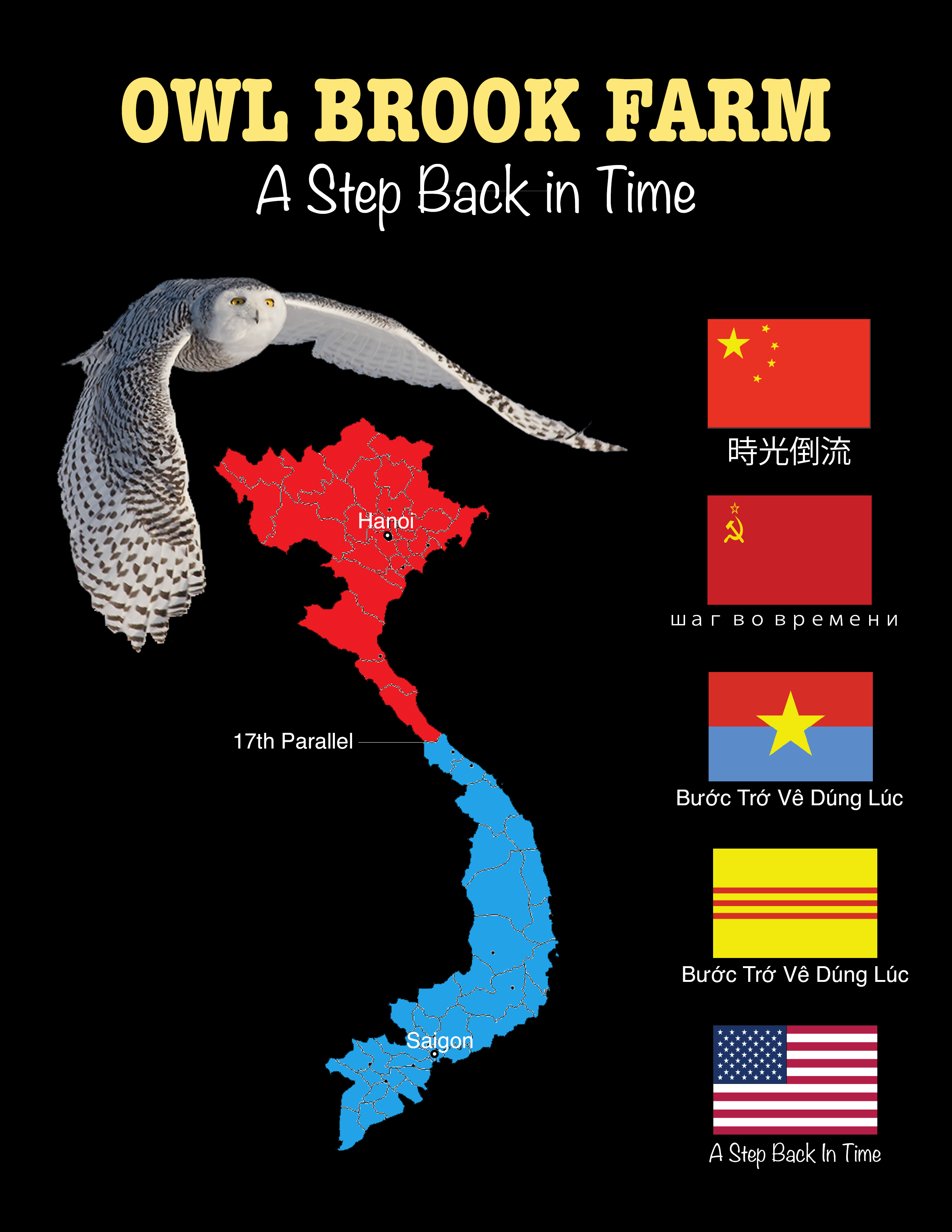
A STEP BACK IN TIME
A “WALKABOUT” IN QUANG TRI, THUA THIEN PROVINCES, AND
THE HO CHI MINH TRAIL—THE TORTUOUS ROAD TO GET THERE
by Harry C. Batchelder, Jr.
“Sometimes it is necessary to go a long distance out of the way in order to come back
a short distance correctly.”
Edward Albee, “Zoo Story”
“Sometimes when you lose your way life gives you a kick in the ass that lands you
back on track . . . or in this case, back on The Trail.”
Harry C. Batchelder, Jr. • November 11, 2012 • New York City
©2016 Harry C. Batchelder, Jr.
TABLE OF CONTENTS
-
UNSOUND BEGINNINGS
Page 1 -
The Lady Shares Her Story
Page 1 -
A Visit to the Love Manor
Page 2 -
An Immodest Proposition
Page 3 -
New Year’s Eve in New York City
Page 5 -
Denouement
Page 5 -
The Fog of Love and War
Page 6 -
The Dense Fog Lifts
Page 8
-
LONG JOURNEY, LONG OVERDUE
Page 10 -
The Struggle to Find “The Correct Line”
Page 10 -
Sundays with Micheline Anne
Page 11 -
Why The Ho Chi Minh Trail? Why Not Governor’s Island?
Page 13
-
A STEP BACK IN TIME
Page 15 -
Flying the Steel Bird
Page 15 -
The Return of the Native
Page 15 -
The Airport Road to Economic Perdition
Page 17 -
Restaurant Bobby Chinn
Page 19 -
The War’s Detritus
Page 21 -
Four Pots of Tea with a Side of Versace
Page 22 -
“Has Anybody Seen General Giap?”
Page 24 -
Seeking Out the Spirit of Saigon
Page 25 -
Air Vietnam to Hue at Dawn
Page 29 -
Welcome to “Harry’s”
Page 30
– i –
-
A Long Day with Emperors Long Dead
Page 33 -
Searching for Fall’s Ghost
Page 39 -
A Walk with Comrade Chris on “The Street Without Joy”
Page 40 -
Why Routes 9, 14, and 49
Page 46 -
AS SEEN FROM “THE STREET WITHOUT JOY” • MARCH 2012
Page 47 -
VIETNAMESE ARCHES • FORTIFIED VILLAGES • THE TREE LINES
Page 49 -
The Cam Lo Chamber of Commerce Welcomes You
Page 50 -
There is No Elevator to the Highlands
Page 54 -
“They Just Disappeared” “We are in the Middle of Nowhere,
Fighting for Nothing”
Page 56 -
BATTLEFIELD VIEWS • KHE SANH • MARCH 2012
Page 59 -
Comrade Chris: “The Bru All Became Christians,
Now They All Have Cellphones”
Page 62 -
“You will be the object of attention, hospitality, offered rides
all along the way” Bamboo Boy, Lonely Planet Forum
Page 67 -
A Further Stroll Down The Trail to Meet the Wild Crowd
Page 73 -
A Night on Bald Mountain
Page 76 -
The Gay Caballeros and the Ambiance of A Loui
Page 79 -
The Way Home
Page 82 -
VIEWS FROM THE TRAIL • MARCH 2012
Page 85 -
Where is La Residence?
Page 86 -
HIGHLANDS GALLERY • MARCH 2012
Page 89 -
The Last Days
Page 90 -
Back into the Steel Bird
Page 91 -
Avarice and the Steel Bird
Page 91
– ii –
UNSOUND BEGINNINGS
The misadventure began innocuously enough as I found myself sharing a
ride from New Hampshire to New York City in the company of two local women,
a reasonably well-preserved sixty-something brunette, and her sister. The bru-
nette, as it turned out, was a woman on a mission; the sister was on board as her
bat woman.
The Lady Shares Her Story
From the outset I was spared the burden of making conversation. More
precisely, I was held captive to a personal narrative I found oddly fascinating.
For close to five hours, “SI” (for “Spectacularly Inappropriate”, as I came to
understand her to be) gushed obsessively about her supposedly “ex-” lover. He
was “the love of her life”, “the most charming man in the world”, possessed of
physical attributes and energies beyond those of mortal men; and (of greatest
importance, as it turned out) he was “rich as Croesus.”
As the drive continued, SI proceeded to describe a relationship constructed
on a not uncommon foundation: man and mistress shared a deep and profound
love of material wealth. Their ten years together had produced a rich public dis-
play of vulgar excess, best exemplified by construction of “the Love Manor”, an
ostentatious nineteen-room mansion the pair had built as a monument to their
love. And lest the neighbors miss the point of erecting this supersized blight on
the New Hampshire landscape, the lovers playfully conferred upon themselves
titles of “native” royalty, none too subtly proclaiming thereby their superior posi-
tion in the local social hierarchy. Even their two German Shepherds, a breed
better suited to guarding prisoners at Dachau then greeting guests at anyone’s
Love Manor, had been rechristened with royal titles of their own.
Concerning the allegedly former paramour himself, SI continued to unself-
consciously describe an individual of such inherent vulgarity that I could only
think of him as “NV” for “Naturally Vulgar.”
As SI prattled on I could hear my mother’s voice in the back of my mind
cautioning me to steer clear of people who “gave themselves airs.” But I was too
caught up in the momentum of the story to heed my mother’s words, or pay
attention to the frantically flashing yellow lights that lined the roadway. Stub-
bornly ignoring all the warning signs and signals, I pressed ahead as though the
road were clear and true.
A Step Back In Time
Page 1
A Visit to the Love Manor
As a couple, SI and NV oozed a private jet, a herd of show horses, and a
fleet of sports cars, not to mention three mansions, including the aforementioned
Love Manor. When, inevitably, I was led on a private tour of the Love Manor’s
grounds, SI proudly announced that it had taken two years to build, that it had
cost untold millions, and that she and NV had been involved in every aspect of its
design and creation.
Not versed in the finer points of architectural design and, perhaps, not
with the fairest eye, this soulless monstrosity dumped into a former cow pasture
reminded me of nothing so much as a Stalinist Georgian 1950s convalescent
home for “security types.” I espied Yagoda, Beria and Yezhov gamboling on the
lawn as they gazed longingly at a ghastly white metal Bauhaus-style storage
shed, stretching out approximately a football field in length. SI declared rap-
turously that this year-round climate-controlled paean to bad taste housed her
loved one’s collection of more than two dozen sports cars. Leaving aside the
mindless extravagance, it struck me that the sale of but one or two cars would
feed the deserving poor of New Hampshire for a year or more.
It has been my experience that these ersatz baronial visions are not quite
complete without a few life-size or larger ersatz Grecian statues punctuating the
grounds, and, once again, the designers of this particular vision did not disap-
point. SI led me to one such gigantic accent piece. She was a bit vague as to the
statue’s antecedents (Diana, perhaps?), but declared confidently that it had cost
“gobs of money.” Unfortunately, the winters had not been kind to Diana, and she
was tilting precariously. I did not have a firing table with me, but using dead
reckoning, if Diana were launched from her present position, she would clearly
impact the Bauhaus sports car shed—not such a bad thing to my way of thinking.
SI pointed out, almost lyrically, that the Love Manor was only one of the
couple’s love nests. NV had purchased two additional overstated homes, one of
them on an island much favored by local “Lake Society” (or, to my mind, “chat-
ter-box society.”) SI noted that, although a boat ride to their island property
would take at most fifteen minutes, NV had purchased a seaplane. The island
was peopled by the nouveau riche and self-styled “literati and glitterati”, and NV
wanted to arrive in style, preferably just in time for sundowners with the Happy
Valley crowd. I had visions of the Pan Am Clipper arriving in Lisboa circa 1939,
although in this case without the classy passenger list. SI stated that she and NV
were as one in believing that “a grand entrance is everything in life!”
Page 2
A Step Back In Time
During the tour, SI shared a touching tale concerning a recent addition to
her paramour’s sports car collection. NV had purchased an Aston Martin for an
obscenely staggering sum of money but in doing so failed to realize that even he
must take a six-hour lesson just to get the car off the lot. SI noted that NV had
failed to coordinate his schedule with hers, causing her to miss “a most impor-
tant” warm-up for “a most important” horse show. SI was most upset by NV’s
thoughtless inattention to her needs, and a lover’s spat ensued. I can tell you
that, by this point in the tour, issues of gross insensitivity were much on my
mind. Get real—get a life—better yet, get a Zipcar or a dozen Zipcars. They are
cheap. NV could purchase a fleet of Zipcars for what he paid for the Aston.
In hushed tones worthy of the divulging of a state secret, (but more likely
dictated by the arrival of the Love Manor’s Dominican overseer accompanied by
one of the German Shepherds—what did the man think I was going to do, nick the
olde familia plate?) SI murmured confidentially that NV possessed attributes
well beyond his prodigious “native” talents. These, coupled with SI’s declared
enthusiasm for the many Shades of Grey, kept the lovers’ pot-au-feu constantly
on the boil. The amorous pair allowed it to be widely known that they were ripe
and ready for action—so long as the action didn’t startle the dogs, they were up
for it.
Ruefully, SI acknowledged that, like all great men, NV was more than
generous in sharing his talents. Word travels fast in small communities, in this
case even faster, sped along by SI’s ringing endorsements. NV was apparently
human catnip, all that and quite a bit more, to the deserving and undeserving
alike—un homme pour tout le monde. Some of his acrobatics were reportedly
spectacular to behold—laissez les bon temps rouler!
As I exited the Love Manor’s grounds, I could swear I saw Heathcliff in
“native” garb serving those delicious little canapés to the same crowd that Tom
Wolfe so exquisitely skewered in Radical Chic & Mau-Mauing the Flak Catchers.
I violently dispatched Yagoda, Beria and Yezhov using a Makarov 9mm for good
measure. It had been a most spiritually uplifting tour. Mont Saint Michel by
seaplane—now that’s something new!
An Immodest Proposition
SI remarked that with their private jet, herds of show animals, attend-
ance at car and horse auctions for “over-the top” purchases of exotic autos and
Tennessee Walking Horses, lofty status in chatterbox society, and “native” titles
A Step Back In Time
Page 3
of empowerment, life was very good. But, as is often the case in her lover’s
world, “very good” had become “not quite good enough”; and so, despite their
numerous awards at horse shows, and their unapologetic self-indulgence in all
manner of exotic “native” delicacies, after ten years of bliss (“was it really that
long?”) SI sadly acknowledged that the couple were apart, and “very much
estranged.”
It was here that SI announced gamely that she was launching a “Golden
Age Sweepstakes” to see who would be the lucky man to succeed NV in her
affections. Although not disclosed to me at the time, one such Sweepstakes had
already taken place which, I later learned, had resulted in disastrous and some-
what scandalous consequences for the contestant. [N.B.: it is my considered
opinion that, if the collective emotional baggage of the parties involved were to
be lined up at the Equator, the results would circumnavigate the globe twelve
times.] SI’s sister thought I would make a good if not ideal candidate and, since
NV wasn’t around, what the hell, SI needed some entertainment. Looking back, I
can only conclude that this was the moment when my lifelong competitive streak
took off at full gallop, leaving my better judgment eating its dust. I looked up to
the emotional hills and mountains, and, accepting SI’s repeated assurances of
deep estrangement, I agreed to enter the Sweepstakes. I subsequently found out
that on the very day I joined up, SI contacted NV and informed him that she
would now be seeing me. I wonder, why would she do that? As they say in my
neighborhood, “calentar la plaza!”
According to SI, she had “serious issues” with NV, and they were not on
speaking terms. However, soon after I entered the Sweepstakes, and apropos of
nothing, SI told me (how exactly had she gotten this message, by semaphore?)
that NV was leaving a hopping European capital where he had a baronial flat
complete with servants to return to one of his stateside mansions (this one
located three miles from her own modest home) to enjoy the balmy New Eng-
land winter weather. Finding myself put in play as a cat’s paw did not produce
a pleasant feeling. However, given everything I had been told about the depth
and breadth of their separation, I decided to stay the course. I looked up to the
emotional hills and mountains one more time, and I still did not believe that
they could get their joint artillery up there. For a while, SI’s assurances came
like raindrops at the beginning of the monsoon. However, soon after his return
to the neighborhood, references to NV began to clutter her musings: “how
charming”, “how debonair”, and “sure there are some blemishes, but boys will
Page 4
A Step Back In Time
be boys.” I heard the words but chose to ignore the clicking sticks, and I
soldiered on.
New Year’s Eve in New York City
Under the right circumstances, New York City provides the ideal roman-
tic setting, never more so then during the holidays. SI was coming to visit her
son and I planned on spending New Year’s Eve and Day with her. On the after-
noon of New Year’s Eve, SI and I had lunch with her son and friends at Rolf’s,
which was decked out to the hilt with German holiday decorations; then off to
MOMA and the Diego Rivera murals for a bit of revolutionary top-up; and then
on to Lincoln Center to see “Blood and Gifts”, a J.T. Rogers play that chronicles
the development of a C.I.A. case officer in the First Afghan War. I attempted to
introduce SI to the role of a case officer, explaining that in the course of the play
she would undoubtedly see manipulation, lying, deceit and betrayal, all for the
“greater good” (irony unintended.) SI appeared pre-occupied; it was becoming
clear that her attention was elsewhere.
During the play SI received a cell phone call and left the theater for ten
minutes. When she returned, she was obviously not back in the theater but
somewhere very far away—life was beginning to imitate art. I admire a good
psychological operation as much as the next man, and this one was done beauti-
fully; I just didn’t care for the fact that it was being done to me. I almost, but not
quite, wanted to congratulate them on the timing—how did NV know we would
be in the theater? As Mao teaches, good intelligence is everything!
Although the rest of the evening was intended to be light fun ending up
on the Brooklyn Bridge at midnight, I might as well have been with Madame
Nhu. SI informed me that she must return immediately to her son’s apartment,
and our parting at 1:00 am was about as romantic as a beer-fueled freshman
fumble at the dormitory door.
Denouement
“Salute to Vienna” was for years a Christmas gift to me from my late
sister—the event is upbeat, romantic and a special way to start the New Year.
Le Colonial, for those who love Southeast Asia, is one of the most romantic
restaurants in New York, a step back into a 1920’s planter’s house in Cochin
China. It was my intention to ask SI during dinner at Le Colonial to travel with
A Step Back In Time
Page 5
me to Vietnam where I hoped to exorcise some demons, the Lao and Cambodian
issues having previously been laid to rest. What could go wrong? Plenty!
The concert was enjoyable. How can anyone screw up Strauss waltzes and
polkas? Nevertheless, SI appeared out of sorts, and complained that the music
was “tricycle” music. I had never heard Strauss put down quite that way, but
even I, belatedly to be sure, was beginning to recognize that a sudden slide into
ice cold emotional waters might be something other than invigorating.
The walk from Lincoln Center to Le Colonial skirts the southern extrem-
ity of Central Park, and is generally pleasant. During the walk SI said little but,
when she did, it was in keeping with the festive spirit of the day. She carelessly
announced that when “they” came to New York, “they” always came on NV’s
private jet for shopping sprees and time to recover from the plastic surgeries
that fed his vanity. Naturally, whenever they were in New York they stayed at
the Waldorf, with their personal limousine on call to take them to all the latest
“in” and “hot spots”. SI cheerfully described the splendors of The Waldorf Astoria
lobby where she and NV would relax while they waited for their limo. As we were
going to pass the hotel on our way to the restaurant, she generously offered to
give me a tour. I politely declined the invitation and looked to see if she was
wearing a sensitivity meter; she appeared to have left it at home. It would soon
become clear that this was not an oversight.
The Fog of Love and War
I recognize heavy duty incoming and this was not the 75mm and 105mm
stuff of Dien Bien Phu. This was the 130mm, 152mm, Khe Sanh stuff coming
straight in from Ca Roc in Laos, all of it expertly laid down and not fired for
effect. I got the message loud and clear, and I decided it was going to be inter-
esting to see how they pulled it off. I didn’t have long to wait!
Le Colonial is frequented by, among others, individuals who, as identified
by Jean Larteguy in his book The Centurions, have been emotionally seduced and
infected by “la fièvre jaune” of Cochin China. Put simply, Le Colonial is a most
romantic and nostalgic haven for those seeking refuge from a blustery, cold,
rainy New Year’s Day. Me—I was just frantically trying to find an emotional fox-
hole—I never had a chance! For those of an operational bent, almost all of the
seats face the door with a wall at your back. I had barely ordered drinks when
SI opined again that her ex-lover was “the most charming man in the world.”
She wondered aloud why “they”, in their Waldorf Astoria salad days, had not
Page 6
A Step Back In Time
discovered Le Colonial. Silently I gave thanks that Le Colonial is not listed
in The Big Apple Guide for the Terminally Avaricious! The conversation and
the temperature at the table felt like naked al fresco dining in Sapa in January.
I could tell that SI was not feeling la fièvre; in fact, she was somewhere between
Mars and Uranus heading out. I paid the bill and ventured out into the cold, wet
night, to walk the thirty-three blocks to her son’s apartment.
During the rainy walk, SI waxed lyrical about the ten years of bliss she
spent with her former love—selective amnesia was much in play during this
soliloquy. One wonders, just what was the attraction—or does one? For close
to a city mile I was lectured about the joys of the obscenely rich life. This was
Thorstein Veblen on acid! The emotional 130mm and 152mm fell like driving
rain, and then for good measure she added Willie Pete every third round. The
tubes were glowing and burning up!
Fiercely, a word SI adores, I was attacked for my scandalous lèse-majesté
in pointing out that if NV had, to put it charitably, “strayed”, there were better
than track odds he would “stray” again—and, by the way, nobody’s getting any
younger. Some of these “falls from grace” were widely known and quite close
to home. SI’s retort was that “bad boys are more interesting and fun.” True
enough, perhaps, but for how long until the sharing act wears thin—ten years is
a long haul. There must have been other benefits. SI “fiercely” defended NV’s
“style”, “dash”, “flair”, “savoir-faire” and another trait that decorum prevents
me from mentioning. At this point, I had a few adjectives and even some choice
nouns ready to throw into the mix, but, reminding myself I was a gentleman, I
chose to exercise restraint.
Proudly, perhaps believing she had coined the phrase, SI declared that she
and NV “were made for each other.” At that moment, in 3D no less, a vision of
Tristan and Isolde flashed before my eyes. By the time I reached Twenty-fourth
Street and Second Avenue, mahquibs, phibobs, nats in Converse Red Stars, trolls,
jinns, a veritable Murderers’ Row of evil animist spirits were furiously gnawing
at my heart and ass. All of the members of SEATO were there (except for the
Pakistani jinns who were delayed clearing customs at JFK.) I knew if the “Day
of the Dead” crowd arrived, I was going down hard.
For the next ten minutes, this gay miasmatic carnival of evil spirits was
going full bore, the spectacle orchestrated, and I date myself with this one, by the
Joshua Light Show. I spied Veblen accosting the few passersby, proclaiming that
he had joined the “Chicago Boys” and was now a “supply side” devotee. No one
A Step Back In Time
Page 7
appeared amused or interested. My last stronghold against vulgar materialism
had been overrun.
My reverie was interrupted by SI who indicated that, because of my scan-
dalous affronts to her ex-lover, she was dismissing me from the “Golden Age
Sweepstakes.” I need not escort her the one remaining block to her abode nor
accompany her to the bus station on the morrow. Although still reeling from the
emotional carpet bombing, I replied that a gentleman does not leave anyone on
a New York City street corner on a cold and rainy night. SI answered, with just
a whiff of classless arrogance, “have it your own way.” Although I admired the
pithiness of the retort, truth be told, I thought it a bit lacking in grace, and per-
haps even bordering on the inconsiderate.
During the one block walk, SI was still “fiercely” blazing as to my lèse-
majesté in pointing out certain obvious truths about her ex-lover. She then
heroically announced that her “true love”, and here she dropped all pretense as
to the real status of the parties, had, upon his return from Europe, immediately
and repeatedly pledged, garanties en béton, his “eternal love”, promising that
once they were together in one of his three baronial homes, all would be right
with the world!
I have never known “eternal love”, nor do I at this late date ever expect
to experience it. However, in SI and NV’s case, no matter how delusional the
concept, I finally grasped that it was not a belief to be trifled with. Time for me
to withdraw, and best to leave the field gracefully. Our parting that evening was
subarctic—good manners only move people with manners—il faut en finir!
The Dense Fog Lifts
At this point, friendly furies took pity upon me. Earlier in the day, before
the Waldorf Astoria fusillade, I had bought SI a piece of spray paint street art
which she left at the restaurant—this oversight was to have unimaginable con-
sequences for me. I returned to Le Colonial to retrieve the drawing, and as I
entered the restaurant, Larteguy’s “yellow infection” embraced me and the tem-
perature on all fronts rose considerably. Feeling like a damn fool and a lot worse,
I paused to take stock. Although found wanting in the “Golden Age Sweepstakes,”
emotionally battered, and facing the despair that haunts defeat, I was nonethe-
less still standing. Thus did the knocked-down-three-times-get-up-four phoenix
raise its head, as I closed out what up to that point had been a psychological
Page 8
A Step Back In Time
descent into the abyss. The true adventure was about to begin, as I prepared
to return to the land of mental and physical anguish that still haunted my soul.
Given that the recent mardi gras of manipulation and deceit had not actu-
ally killed me, it was now time to challenge myself physically and mentally to
see if having survived the ordeal had made me stronger. As I left Le Colonial
that evening, I took, as Mao would say, my first tentative step on a long journey,
long overdue.
In Kaneto Shindo’s 1960’s film “The Naked Island”, a hauntingly tragic
exploration of the savagery and despair of Japanese peasant life, there is no
spoken dialogue. Allow me to assure everyone that the cab ride to the bus ter-
minal—sorry baby, no private jet—made “The Naked Island” look like a simultan-
eous three-ring spelling bee. To enable SI to return as expeditiously as possible
to the land of “native” royalty and “eternal love”, I arranged for her to take an
earlier bus. Speaking as a gentleman, I wished SI and her lover every happiness
and I meant it. Who knows, perhaps SI’s “fierce” defense of the spiritual as well
as material benefits of vulgar wealth had made a true believer out of me!
I wait in vain for a thank you for the weekend which I still thought was
a triumph of planning, even though it lacked a certain something in execution.
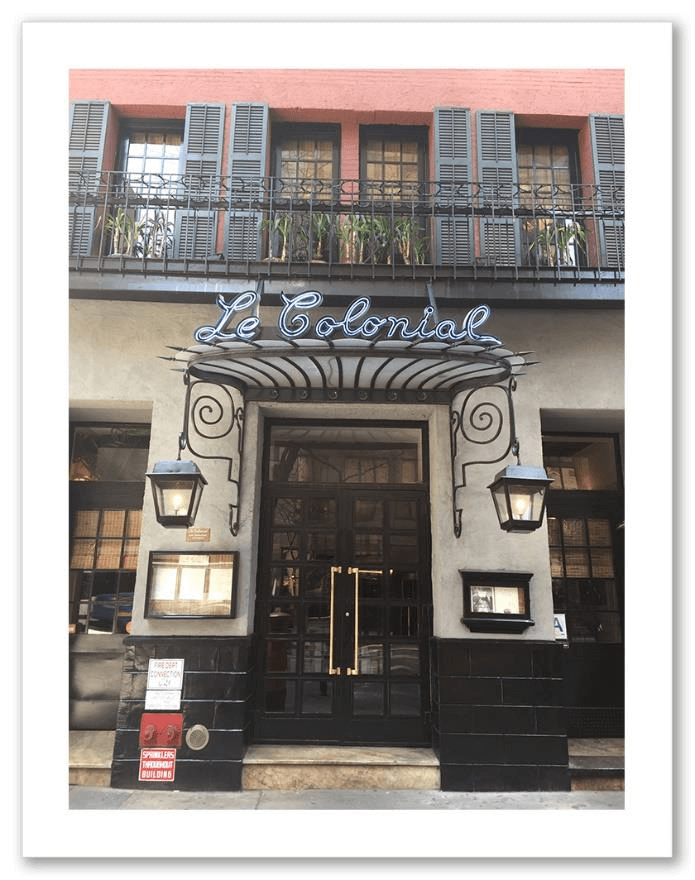
A Step Back In Time
Page 9
LONG JOURNEY, LONG OVERDUE
The Struggle to Find “The Correct Line”
Over the next several weeks I renewed my intellectual friendship with
Mao, On Guerilla Warfare; Lawrence, Seven Pillars of Wisdom; Fall, Street
Without Joy; and Larteguy, The Centurions. Locating up-to-date maps of Viet-
nam’s Central Highlands was a problem, and the New York Public Library Map
Room had nothing on the Ho Chi Minh Trail. Google Earth came much into play.
The game was beginning to shape up.
Mao believes that in order to have a sharp mind you must “savage” (his
word) the body, and so I set about to do just that, or at least build up enough
endurance to walk twenty-five miles a day. I joined the Harlem YMCA as one of
the few, if not the only, geriatric white males looking to become part of the gym’s
“animal kingdom.” No free weights, thank you. A good friend had laminated an
image of the grotesque Stalinist arch at Lao Bao as a reminder to me to press on
when I faltered on the treadmill.
Once the regulars determined I was not a geriatric undercover cop, I was
treated with the utmost courtesy and respect; once they saw the picture of Lao
Bao and understood what I was planning, several of the older guys urged me
to extend the workout to include a series they called “funning.” The routine in-
volved crunches, low rowing, and lats, and utilized every machine for developing
the upper body. They suggested this program might come in handy should any
trouble arise during the “walkabout”.
I continued my workouts, the pounds started to come off, and eventually
I could hold my own—the “savaging” was working. As I approached peak fitness
for a man in the prime of his seventy-sixth year, I thought of Mao’s highly touted
propaganda plunge into the Yangtze River. The seventy-two-year-old Chairman
paddled in circles and floated on his back for a little more than an hour among
the bobbing heads of countless cheering comrades. I would be hiking solo on the
Ho Chi Minh Trail, eight to ten hours a day, without so much as an “attaboy” from
the sidelines.
In another development for life-long use, I learned that if one plays the
“Internationale” five times back-to-back, you can handle anything the bastards
throw at you. As my endurance increased I could feel myself getting pumped up
mentally as well. I grew impatient to go—the sooner the better. Brushing off the
Page 10
A Step Back In Time
last remaining crumbs of emotional stupidity, I bid farewell to the sorry smell
of second-hand curry, and reset my sights on Saigon.
Sundays with Micheline Anne
For the very early advisors to Southeast Asia the conflict was intense,
personal and, on occasion, rewarding: Never to be forgotten, you were there
“doing good!” In his personal narrative, The Village, Francis J. (“Bing”) West
exquisitely details the wrenching panoply of emotions experienced by young U.S.
servicemen in the carnival of death atmosphere of Vietnam. Inevitably, despite
the environment and circumstances, friendships developed, and relationships,
intimate and unexpected, took root.
As a disciple of Lawrence, you never slept with the women in the country
to which you were assigned—never, ever. This prohibition constitutes madness
for many, but was not an issue for me; besides, my heart was elsewhere.
By chance, I met the mother of a thirteen-year-old young lady of mixed
French and Vietnamese parentage. Micheline Anne was not terribly attractive
physically but possessed of a universe of innocence and class; I saw in her a light
that would one day travel round the world. Because the air was still French, she
had not yet been ostracized, which, as the war dragged into decades, would be-
come the fate of thousands of mixed children. Her father, a French legionnaire,
had abandoned the family; her mother, occupied with “other things” (charitable
words) had little or nothing to do with her. Micheline Anne spoke broken Eng-
lish, was hard pressed to find the money for school, and was condemned to a life
of indifference or worse with no hope of escape. Enter the big blue-eyed men
from the East. Back to school, (Catholic—what else) and a friendship was born
that burns as brightly today as it did fifty-three years ago.
Each time the men from the East returned to Saigon we sojourned to the
sidewalk café on the terrace of the Continental Hotel. Three strapping Americans
and this teenager in her Catholic schoolgirl’s uniform—not your everyday assem-
bly. The ritual was fixed: Cokes all around—no Perrier for this crowd. Micheline
Anne, very much the lady, held court—an island of innocence surrounded by a
sea of violence, chaos, and deceit. The relationship and emotions that resulted
were intense. I can only compare them to those portrayed in the 1962 Serge
Bourguignon film “Sundays and Cybele”, which, when I first saw it, wounded me
beyond despair for months if not years.
A Step Back In Time
Page 11
Micheline Anne’s English improved, her grades soared. I told her if she
did well I would send her to the Sorbonne where she could learn to be a revolu-
tionary and return to become the power behind the throne. I would have found
the money somehow. The revolutionary part I would have soft-peddled, but then
again, maybe not. Although the rendez-vous were not all that many, people were
watching, and the “struggle” soon got very personal.
Our team returned late one evening and, as she adored ice cream, I gave
Micheline Anne some piastres for the next day. She and I said our goodnights,
and went our separate ways. Back at the Continental as I got ready for bed I re-
membered a note I had received several months earlier. It had been cut out from
a newspaper and read “You shall know pain.” I was soon to learn the extent of
the pain.
Early the next morning I heard an explosion outside in the block just
down from the Continental, and I knew to a certainty what had happened. The
ice cream and candy store opened early and when I hit the pavement I saw
Micheline Anne, her body half in the street and half on the sidewalk. What was
left of her head rested in a pool of dirty water that remained where the street
cleaners had passed by her lifeless form. The Vietnamese were stepping over
her. I saw the bloody piastres in her hand, and the light went out in a great
portion of my heart, never to be lit again.
Her mother, quite properly and I did not fault her, said this would not have
happened if Micheline Anne had not associated with us. She wanted nothing to
do with the cremation, and when I returned the ashes to her she placed them in
a closet, not on an altar. She summarily dismissed me. I had it coming, but there
was nothing she could do to punish me that remotely approached what I would do
to myself in the coming years. I never heard from her again and I completely
understand why.
I have been told, professionally, that Micheline Anne’s murder has more
than colored my views on many things; a Russian doctor, no less, recommended
that I return to Vietnam to “bring closure.” I don’t understand words like
“closure”. Why would I want to “move on” from someone beyond special, whose
memory endures unchallenged in my heart’s embrace. In my mind, so long as
I am alive to remember her, Micheline Anne is immortal; when I die, she dies. I
would gladly give up a thousand lesser memories to sit with her again, sipping
Coca Colas on the terrace of the Continental Hotel, and savor those halcyon days,
Page 12
A Step Back In Time
all too few, when a big blue-eyed man from the East and a French-Vietnamese
young lady, discarded by her mother, fused an emotional bond beyond steel.
Get over it—no—I wanted to meet up with Micheline Anne and start all
over—closure be damned! What do those Russians know anyway! Emotionally
dead, thanks to the Five Year Plans. Still, the doctor was one of the very few who
wholeheartedly supported, no, encouraged the “walkabout”; where others were
horrified by the idea she was gung ho. I must learn to cut her a little slack.
Why The Ho Chi Minh Trail? Why Not Governor’s Island?
By way of background, military intelligence schools in the 1950s and
even to this day tend to turn out “bean counters”, which totally ignores the
political aspects of revolutionary war. This is not meant to fault them, as they
see their mission as one of “pure intelligence”, and to slip into that “other world”
is to risk corrupting their mission. The Pathet Lao/Viet Cong crowds (not to
mention whatever Khmer mass murderers were around at the time) were not
burdened with any such constraints. As noted by Larteguy, and also by Fall in
Street Without Joy, our adversaries early on embraced the concept that military
tactics are of secondary importance—politics will always take precedence. We
have yet to master an effective response to this critical hierarchy.
Additionally, the boys in black had a broadly based intelligence net spread
throughout “the masses” which provided their operations with up-to-the-minute
intelligence of such a kind and volume as to severely cripple counter-operations.
Mao preached, and these were not abstract concepts, that theirs was a war of
“movement, alertness, mobility and attack.” Lest there be any doubt about the
wisdom of this approach, consider that the nightmare effect of Tet has never
been completely exorcised from the psyche of the United States military. Fall’s
later chapters vividly illustrate how we were caught in the same trap as were the
French, indeed even on the same roads!
In his brilliant introduction to Mao Tse Tung’s On Guerilla Warfare, Briga-
dier General Samuel B. Griffith sets out in two succinct paragraphs America’s
reliance on a worship of technology in missiles, bombs, and the big bang for the
buck. The crowd in black relied on rigorous discipline, up-to-the-minute intelli-
gence, and a clear picture of what they were fighting for. This is, admittedly, a
gross oversimplification of the rights and wrongs in the conduct of the war, but
as Fall’s early insights teach, America ignored certain precepts of “revolutionary
warfare” that ultimately led us to the embassy roof.
A Step Back In Time
Page 13
In the 1950s, a miniscule minority of intelligence officers began to grasp
the impact that the tactics of revolutionary war might have on the Army, the
Navy and, to a much lesser extent, the Air Force. The minority voices were
muted and their opinions were never sought. Although they took a pounding in
Graham Greene’s The Quiet American, these officers found intellectual comfort in
the actions and teachings of Major General Edward G. Lansdale, USAF. The boys
in no-rank khaki slowly emerged from these humble beginnings. Militarily, des-
pite fierce resistance, USAF special operations squadrons were getting ready to
be birthed in the not-too-distant future.
These special ops officers slowly trickled into Laos, Cambodia and Vietnam,
and I was invited to join. I have never been invited to Governor’s Island, nor do I
expect to be—a small price to pay for social integrity. Show me your friends and I
will tell you who you are!
The Ho Chi Minh Trail was General Giap’s logistical lifeline. We bombed
it, sprayed it, mined it, sensored it, tried to build a fence, tried everything but
boiling and fricasseeing it, and we failed dismally to stop the flow of supplies. An
estimated 600,000 went down the trail and 200,000 came back. As terrain goes,
it is not much of a challenge, but if you do it solo with a rucksack and a jackknife
it can get interesting. According to the boys at the Lonely Planet nobody had
ever walked or tried to walk the trail, because for long stretches “there is nothing
down there” and no place to stop. A perfect SAS problem course. Time to “ride
the tiger” on The Trail.
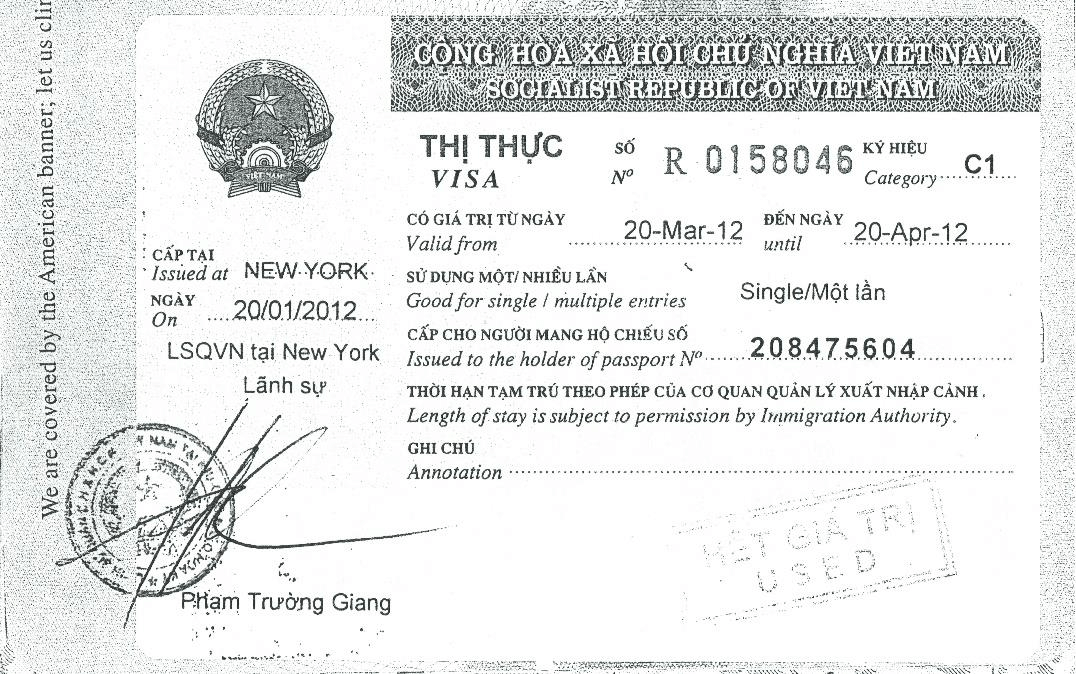
Page 14
A Step Back In Time
A STEP BACK IN TIME
Flying the Steel Bird
Given the nature and length of the trip it was not too difficult to pack; the
weight of the historical emotional baggage was far more troubling. Haunted by
having to deal with fifty-two years of neglect, I cannot sleep the night before my
flight. Sunday morning to the gym, and I break four miles an hour on a 5% in-
cline. Cold showers galore, then into the steel bird for a thirty-three hour joy ride
to Saigon. A close friend gave me Nelson DeMille’s novel Upcountry and as I read
it I realized just how thoughtful a gift it was. I would be walking in many of the
same areas, such as A Loui and its environs.
I had a window seat and as we descended into Saigon, I immediately no-
ticed that the city’s urban sprawl had passed Tan Son Nhut. A huge golf driving
range—golf driving range?—loomed into view. We greased runway 25R and, as
we turned on the taxi way, eighteen black lichen colored helicopter revetments
loomed with landing circles still clearly visible. As we passed in review, they
were at attention like a Praetorian guard for a vanished “Contain Communism”
empire. In the old days Tan Son Nhut was “spooky” with frenetic activity; four of
the hangers remained, but not the craziness. As we turned to the docking ramp I
saw, just outside the airport, a monstrous Corona Lite advertising banner draped
on a new apartment building—it had to be one hundred feet of flag—welcome to
globalization.
The Return of the Native
Major Reginald Hathorn was, in 1968, an O-2 driver in Vietnam. In his
2008 book Here There are Tigers, he mentions his early upbringing in Louisiana,
and writes that when he first arrived at Tan Son Nhut, Vietnam smelled, to him,
“like a rattlesnake.” One of Hathorn’s first missions was to bring in “fast movers”
to bomb the Ho Chi Minh Trail, a portion of which I was to walk on the first day of
my “walkabout.”
My initial arrival experience differed from Hathorn’s because as a teen-
ager I helped my father work Owl Brook Farm, the most spectacularly unsuccess-
ful dairy farm in the history of the world. There is no greater joy imaginable for a
teenage boy than getting up at 4:30 in the morning at ten below zero in four feet
of snow, opening the door to a tie-up where thirty-two head of cattle have been
A Step Back In Time
Page 15
doing their business for the last twelve hours, and cleaning up the mess with no
mechanical scuppers!
Do this for a while and you will understand why Mao, in the previously
referenced essay, observed that “only the men of the North are able to lie under
arms and meet death without regret.” And he never experienced my father’s tie-
up! Compared to the tie-up, Saigon in the late ’50s smelled to me like a Givenchy
perfume factory.
Based on my initial observations from the air that Levittown had snuggled
up to Tan Son Nhut, I figured that if I got bored, I could hit a few golf balls and
down some Corona Lites. Then the plane door opened and it was air conditioning
all the way. I thought I might be in for some fun at Immigration, and I was not
disappointed.
My immigration officer was, I guessed, in his late thirties, and a sharp
dresser with well-shined shoes. Reviewing my travel history he asked, in per-
fectly unaccented English, what I was doing in Burma (not, I noted, Myanmar)
before it got trendy, and why I had visited Laos twice, coming in from Chiang Rai.
I told him I was interested in “native textiles.” By this time he was joined by his
supervisor, a bit older, again speaking perfect English, and sporting an equally
sharp uniform and shoes. It was the two fairly recent Cambodian visas that
caught their attention—I decided to get in the game.
I told them that, to my mind, 2,000 Chinese visitors a day to Siem Reap
“lowered the tone of the neighborhood.” On a roll, I opined that it was a good
thing the Vietnamese had invaded Cambodia to teach the murderous Khmers a
lesson, but the Khmer Rouge were still running the country—they had just put on
suits. During this latter paean I detected a slight twitch around the supervisor’s
mouth but I was mostly locked on his eyes. He then handed me back my passport
with a “welcome back to Vietnam.” I had no prior Vietnamese visas in my pass-
port—touché! With this for starters I knew my stay was going to be interesting.
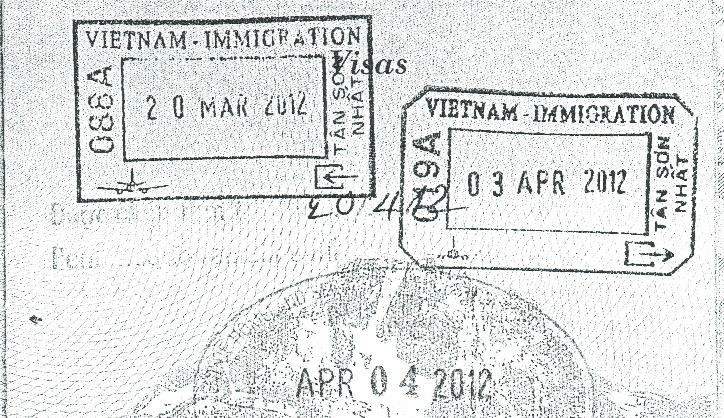
Page 16
A Step Back In Time
The Airport Road to Economic Perdition
I climbed into a cab and, within one hundred yards of the entrance to the
airport, I was floored. On both sides of the road, small entrepreneurial shops—
machine shops, motorcycle repair shops, small offices, and clothing stores—were
humming. Their density quickly increased, and by the time we had gone two
kilometers it was wall-to-wall small enterprise. To my mind, there was no way
this fit into any Five-Year Plan. As we drove further towards downtown, small,
then larger tasteful office buildings began to appear and, although it was late
morning on a business day, swarms of light-cc motorcycles operated by neatly
dressed men and women began to clog the roads. Further on, more steel and
glass appeared, as did more motorcycles. The road was a central economic
planner’s worst nightmare. As we hit downtown Saigon, the French ambiance
was almost obliterated by new development.
Arriving at the Continental, I looked over to the block where Micheline
Anne’s murder had taken place. The block, everything, and I mean everything,
including the sidewalks, had disappeared. A sign proudly announced construc-
tion of a luxury hotel, magnificent luxury condominiums, a spa, and an under-
ground parking garage. I found myself thinking about the water table in Saigon
and the money it will take just to build the garage in a city that hardly needs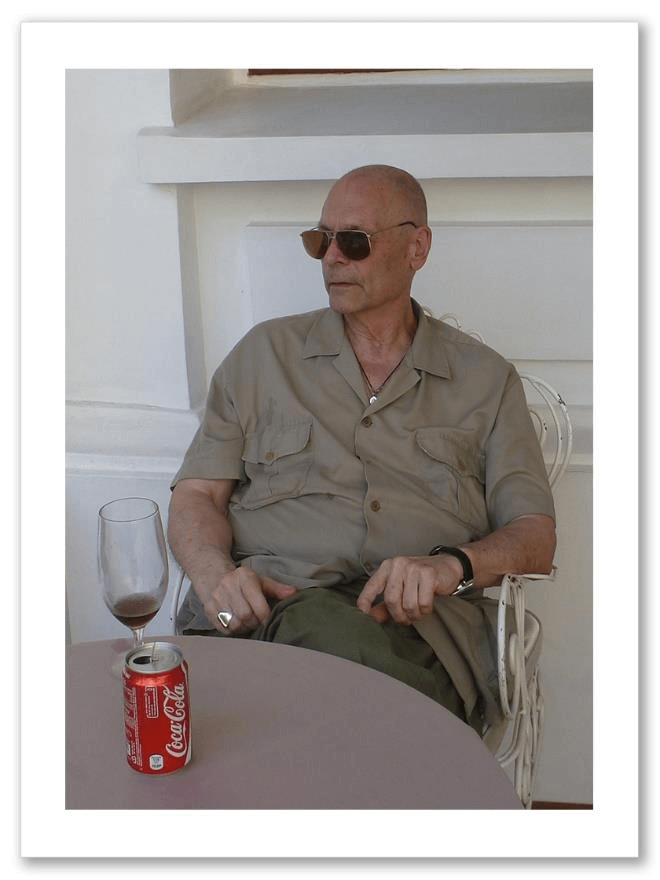
more cars.
The Continental, the grand dame
of traditional Saigon hotels, subjected as
she was to the construction symphony
next door, must always be aware just how
precarious life is under Red capitalism.
As I entered the hotel I glanced over at
the construction site and vowed I would
somehow get inside. I had been back for
more than an hour and everywhere I
looked I saw clothing that could have been
bought at a southern California strip mall;
not an ao dai in sight, not even at the re-
ception desk. The physical reminder of
my despair had been vaporized, and the
soft edges of Saigon replaced by hard steel
and concrete. The economic aspirations
A Step Back In Time
Page 17
of Deng Xiaoping had found fertile soil in Saigon, and they were flourishing. I
checked in, immediately went to the front veranda, ordered a Coke, and, looking
every bit the “ugly American”, tried to get a handle on the changes all around me.
It is generally my practice, if at all possible, to walk a city, and I immedi-
ately headed for the War Remnants Museum. I took my time and I was more
than impressed. The parks were clean, no litter on the streets, no beggars, every-
one neatly dressed. The palace and every other public building were in tip-top
shape. The traffic was chaotic, but with none of the vicious New York City top-
dog aggression. To my mind, whatever they were doing had made the city livable
and aesthetically pleasing. Even the swarms of motorcyclists appeared to get
along reasonably well with each other.
The War Remnants Museum is by far the most popular museum in Saigon.
The U.S. takes some body blows here, with static displays of our various aircraft
and helicopters, and a “daisy cutter” thrown in for good measure.
As I entered the museum’s grounds I was pleased to see the iconic O-1 Bird
Dog front and center, and the sight made me proud to be a Bluesuiter. Ravens, 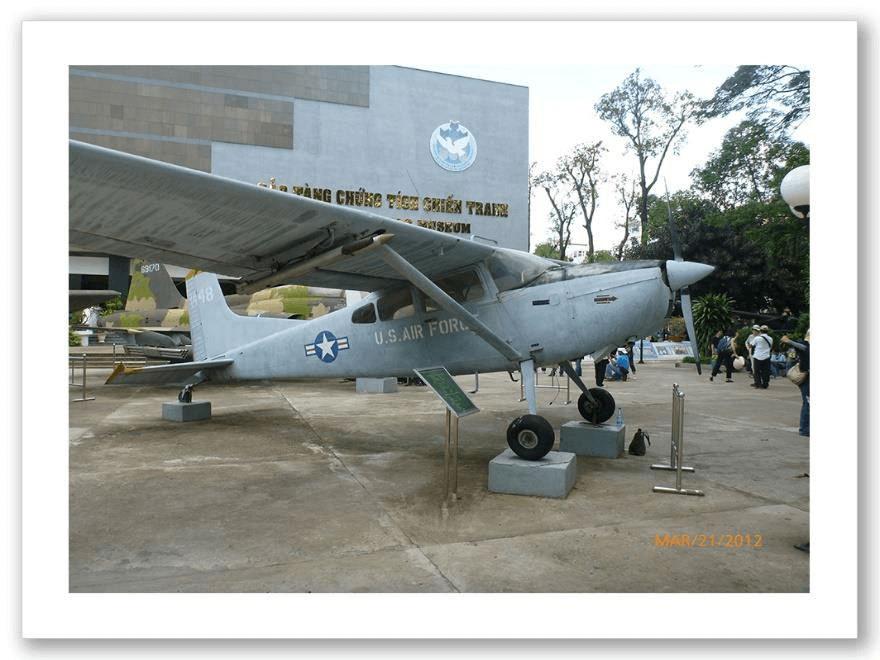
perhaps the greatest group of
aviators ever assembled, (and
who, as befits those who fly by
ailerons and are required to
jink every thirty seconds just
to stay alive, possess an elan
the uninitiated cannot even
imagine) had christened the
O-1 “the mightiest fighting air-
ship in the world.”
As I toured the galleries,
I noticed the conspicuous ab-
sence any exhibits referencing
the 6,000 Vietnamese who were methodically listed, hunted down and murdered
by the Viet Cong during their occupation of Hue. Despite some subsequent polit-
ical differences, the Vietnamese were, on that occasion, aping their murderous
Khmer neighbors.
On the far left as one enters the museum are a series of shops offering fake
Zippo lighters from many of the war years. The lighters display the unit desig-
nator on the front, and on the back pithy G.I. philosophies which offer a glimpse
Page 18
A Step Back In Time
into the mind of the owner and the demons of the times. They illustrate despair:
“You can fuck with the troops, but you cannot fuck with time”; humor: “If I had
a home in Hell and a farm in Vietnam, I would sell both”; defiance: “Kill them
all; let God sort out the innocents”; and profound insight: “Life is sweet for those
who have fought for it, for life has a flavor the protected will never know.” I pur-
chased the last of these and carried it with me everywhere.
Back to the hotel. My first impressions of Saigon were confirmed: a spank-
ing clean city, little poverty, and a well-fed, well-dressed populace. Clearly this
was more than trickle down Red capitalism at work. I was impressed, but I had
not yet seen the countryside.
By chance, an acquaintance of mine had met a couple from Vietnam while
they were in New York. They graciously agreed to meet me for dinner to discuss
the projected trip and introduce me to the “new” Vietnam. They chose the res-
taurant and it was my lucky day on all fronts. She was your basic ten-star Viet-
namese Cambodian knockout—charming, smart, worldly, in short, a treasure.
He was a photographer lately returned from Burma, handsome, charming and
worldly—in short, an incandescent couple. Any reticence between us dissolved
instantly when the menu was opened. To share the unique hospitality of Res-
taurant Bobby Chinn, the proprietor’s rules follow in their entirety:
Restaurant Bobby Chinn
“In the unlikely event of a terrorist hostage-taking
situation in this restaurant, please DO NOT call the Russian
Special Forces. I would rather be pecked to death by a duck.”
Restaurant Bobby Chinn Rules:
Introduction to Menu
“This restaurant is an Abba, Kenny G., and Gypsy King
Free Zone. We also refuse to play any bands with more than
one lead singer or matching sweaters. Female Teenyboppers
dressed like whores with synchronized dancing are also
banned! To preserve the dining experience, we request that
you are well versed in mobile phone etiquette (SILENCE). All
our Poultry & Meats are Halal or as close as it gets to Kosher
. . . Except the pork, of course! None of the staff were harmed
(physically) to bring you quality food and service tonight, or
A Step Back In Time
Page 19
ever. Children’s menu available upon request and duct tape
is available for hyperactive children. Please do not ask us to
split the bill other than by a number. We do not do ‘she had
this, and I had 1/2 of that’ very well. Please note that we
have smaller portions at the same prices for Anorexics and
those aspiring. Also this restaurant is non-smoking, please
smoke at outside, feel free to fart there also. Thank you.”
S E A
Cold-blooded seawater creatures that didn’t have a chance or even a clue!
Crispy Skinned New Zealand Salmon on Wasabi Mashed Potatoes,
Vegetables, Ginger Demi Glace 456
A I R
But they spent a little too much time on land, and not enough in the air.
Then there is Bird Flu . . .
And you want to know why it’s called foul?
Apple Smoked Duck Breast with Black Sticky Rice,
Baby Bok Choy & Pomegranate Duck Jus 600
Half a Rotisserie Chicken served with Root Vegetables & Mixed Green Salad 378
L A N D
Dumb cows that thought they were living in India or something.
Lambs that had no idea about Islam
The Wagyu Burger, Mixed Greens & Truffle French Fries 550
Red Wine Braised Lamb Shank with Cous Cous 640
Filet Mignon 696
S I D E D I S H E S
We tell you “You are beautiful” all night long (includes a signed copy of the menu.) 126
Grapes Wrapped in Goat Cheese with a Pistachio Crust 264
Wasabi Mashed Potatoes 130 Truffle Mashed Potatoes 306
Mac & Cheese, BBQ Pork Ribs with Asian Slaw 252
Mashed Potatoes, French Fries, Edamame 180
Nachos 276
Page 20
A Step Back In Time
For the next four hours they jenned me up as to the new Vietnam—both
were supporters of the trip and the conversation was stimulating and beyond.
They illustrated the economic development of the country with the touching
story of a young Vietnamese entrepreneur who purchased a Lamborghini.
Because of his slight stature, the driver’s side had to be modified and a special
team was flown from Italy to Vietnam to customize the seat. This was accom-
plished and he set off for Hanoi on Route 1. However, due to the poor condition
of the road (torn up from overloaded trucks) and the car’s low clearance, it was
necessary to have a tow truck accompany the car all the way to Hanoi and back.
It took the young man three days to get to Hanoi, two days longer than the train,
and four days to get back. Nevertheless, he considered the trip a success—quality
vulgarity, expressed with cachet, trumps wholesale vulgarity hands down.
As I walked back to the Continental along Dong Hoi Street I was assaulted
by Tiffany, Versace, Chanel, Cardin—every shop an icon of Western materialism
and greed. I thought I was on Calle Florida in Buenos Aires or Fifth Avenue in
New York, but Dong Hoi is a lot more intimate. I returned to the Continental, sat
on the patio, sipped a Coke, looked over at the silent construction site, tried to get
some answers and got none. I knew where I was going the next morning.
The War’s Detritus
I was taught that whenever I come to a new city, if I don’t speak the
language, I must search out the English language newspaper and read every
page. Everything—even the want ads—the lot! I arose early and got only as far
as the first page of the Saigon Post and, I believe, page seven, before I was floored
once more.
It appears that there are three mobile phone companies in Vietnam. The
Vietnamese are cell phone crazy, and one company is ailing and another is seek-
ing to take it over. In a dispatch from Hanoi, no less, a Mr. Thach (I didn’t get his
full Government title) vehemently opposed the takeover as “anti-competitive”,
and he strongly urged that even to countenance a takeover would not be “in the
long term interests” of Vietnam. Mr. Thach’s position was heartily endorsed by
several other Government worthies—was I in a communist country or a Univer-
sity of Chicago Law School antitrust class? Sure the paper’s mindless reporting
of Italian Soccer League scores was of some interest, but I began to think that
1975 wasn’t the only major date in this country’s history, and that 1990 was
A Step Back In Time
Page 21
equally or more important. It warmed my heart to contemplate the barrels
of hydrochloric acid that an article like this must dump into the stomachs of
Hanoi’s Marxist ideologues—are there any left up there? It was more than
delicious to contemplate how they must choke on their morning coffee when
greeted each day by such news. Tell me please, who won? I decided to have a
chat with an individual I believed to be just such an ideologue.
In 1951, in two highly different academic astrospheres, Harvard’s Hannah
Arendt published The Origins of Totalitarianism, and Eric Hoffer (his academic
milieu was a caboose on a Western U.S. railroad) published, The True Believer.
Reduced to their absolutely basic theses, both come to the same conclusion: “if
you scratch a brown shirt (Nazi), you will find a beefsteak (Red).” The particular
intellect of “the true believer” inclines him toward absolutes, and inspires within
him a relentless drive to destroy the non-believers. Hoffer’s book is as relevant
to today’s media creation, the so-called “Arab Spring”, as it was to a very frosty
cold war which was soon to erupt in Korea. Arendt and Hoffer believe that the
revolutionary and counter-revolutionary have much in common, as their beliefs
spring from identical intellectual premises, but that each takes a different path in
the forest. I was soon to test this theory.
Four Pots of Tea with a Side of Versace
Lotus is a jewel of a shop on Dong Hoi, tucked among the behemoths of
Western materialism—the small shop sells nothing but revolutionary propagan-
da posters. Lotus is an experience not to be missed as the proprietor will gen-
erously spend hours tying each poster into Vietnamese history and detailing its
relevance to “the struggle”. My initial intent was to purchase some posters as
gifts for a disillusioned ’60s SDS friend—he was mad for a Giap poster—and a New
York female Rad of some notoriety, but the purchases were a secondary mission
to what I believed would be a little “revolutionary” tutorial.
I armed myself with two pots of tea—one that vile green tea that almost
immediately tears the enamel off your teeth, and the other, good capitalist Tetley
black tea. I was dressed for the part in Ray-Bans, an NBO safari shirt and cargo
pants—into the fray.
The shopkeeper, whom I will refer to as “M”, (I use this designation to
protect the innocent) came to the door. I presented the tea and opened with,
“how do you like your new neighbors?” M replied, “Now we even allow big blue-
eyed men from the East into our shop, they are some of our best customers.” I
Page 22
A Step Back In Time
liked the retort and over the next four hours M graciously showed me the collec-
tion of posters, as we took an emotionally precarious journey over six decades of
Vietnamese revolutionary history.
I advised M of my total disillusionment with the Dong Hoi experience and
asked “Is this what 60,000 plus Americans died for?” Evenly, although such tact
was probably not called for, M answered “We lost millions.” I told M that I would
soon be walking on the trail where hundreds of thousands perished, and that it
was clear to me the “revolution” had been betrayed, and the Hanoi ideologues had
sold out. Deftly skirting the questions, M replied “nationalism is a great thing.”
I asked, looking out toward M’s neighbors, if the sight didn’t continuously
poison M’s thoughts. I got the same “Nationalism is a great thing” and “Why did
you arrogant Americans believe you had the right to dictate our form of govern-
ment?”—Touché! I slammed back—had M bought any lovely Tiffany charms
lately, the ones that cost six months of an average Vietnamese worker’s pay? I
offered to accompany M across the street to help with the selection—your move.
I had held back the Giap card and now I played it. Giap, perhaps the great-
est military man since Mao, [although his greatest triumph, Tet, was based on
Mao’s “Feint in the West (Khe Sanh), strike in the East (Tet)”] had recently and
very publically opposed bauxite strip-mining, stating such mining was inimical to
Vietnam’s national interest. This was much to the dismay of Hanoi bureaucrats,
and Giap had become a “non-person” à la Trotsky. I advised M that I was looking
for Giap shirts for my Rad and SDS friends. After some gentle prodding, M re-
plied that I would not find them in Saigon but maybe Quang Tri City, as “red roses
still bloom brightly there.” Nevertheless, M was able to dig up a Giap/Ho poster
which will bring joy to a bummed out SDS cadre. I thanked M for going the extra
mile and asked if there were any more Giap/Ho posters? I was told, with a little
smile, that they were scarce.
After consuming four pots of tea, it was time to leave, and I asked M, as
we stood now, who won the war? M indicated that in 1975 they did, and today,
given Dong Hoi Street, we did. Then M added that we, you and I, both lost, but
that at least I did not have to walk to work every day past Versace, et al. I told
M I walked to work every day on Wall Street, and that I waltzed every day with
moral indifference in America. Sadly, during my four hours with M no other cus-
tomers arrived. I bought some additional posters and left the shop secure in the
knowledge that Arendt’s and Hoffer’s theories were alive and well. I never spent
a better four hours with a dyed in the wool ideological adversary.
A Step Back In Time
Page 23
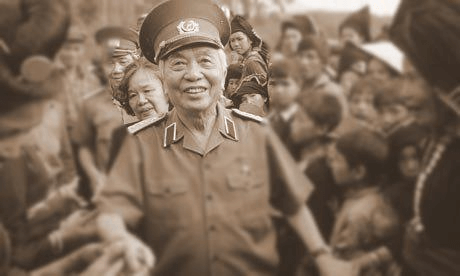
“Has Anybody Seen General Giap?”
I decided to hire a driver and motor scooter to search for a talisman for the
trip and to recondo for Giap T-shirts. This is no small decision as it is best not to
get a driver who is too cautious. As I spoke no Vietnamese, it was a crap shoot, 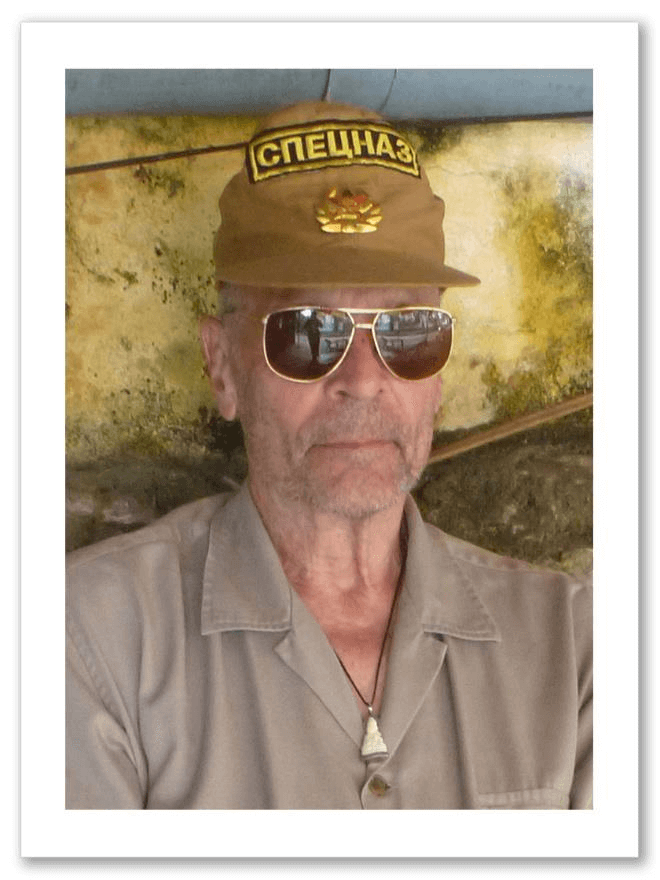
and I won. My driver’s initial “grand ges-
ture” was to go four blocks against traffic to
make a left hand turn—returning a cowboy
back to the Ben Thanh market.
Before leaving the U.S. I was told by
a Vietnamese client that I would be disap-
pointed by the market, price-wise and in
terms of selection—he got that right! We
searched in vain for Giap T-shirts—when we
asked, we were greeted by stares reminis-
cent of a Stalinist Central Committee meet-
ing considering the Trotsky issue—some
professed not to know him, even when my
driver colleague queried them in Vietnam-
ese—we were shopping for an image of a
non-person. Traditional crafts such as lac-
quer were reduced to one stall, talismans
and hill tribe fabrics were nowhere to be
found. By chance I was able to convince a seller to string a small Buddha on a
Page 24
A Step Back In Time
brown leather cord, which I prominently displayed from that day forward.
Otherwise I could have been, except for the tea and coffee, in a cut-rate Ameri-
can clothing store—rubbish.
I then travelled to Cholon to review old acquaintances and it, too, now
looks like a California strip mall. We canvassed both the Binh Tay and An Dong
markets in search of Giap T-shirts. If you want to see private enterprise in its
rawest form, sit yourself outside the Binh Tay market and watch the “sweat
shop” action. Human beings as beasts of burden, à la the Singapore docks in the
1950s. It is a great advertisement for unionism! No Giap, no traditional crafts.
Back to the hotel veranda, another Coke, malevolent thoughts for the construc-
tion site—well into the night—solo—no friendly spirits. Tomorrow: back into
the fray.
Seeking Out the Spirit of Saigon
Religiously, without fail, upon our return to Saigon, Micheline Anne would
take us to the Jade Pagoda and give thanks for our safe return. Given what had 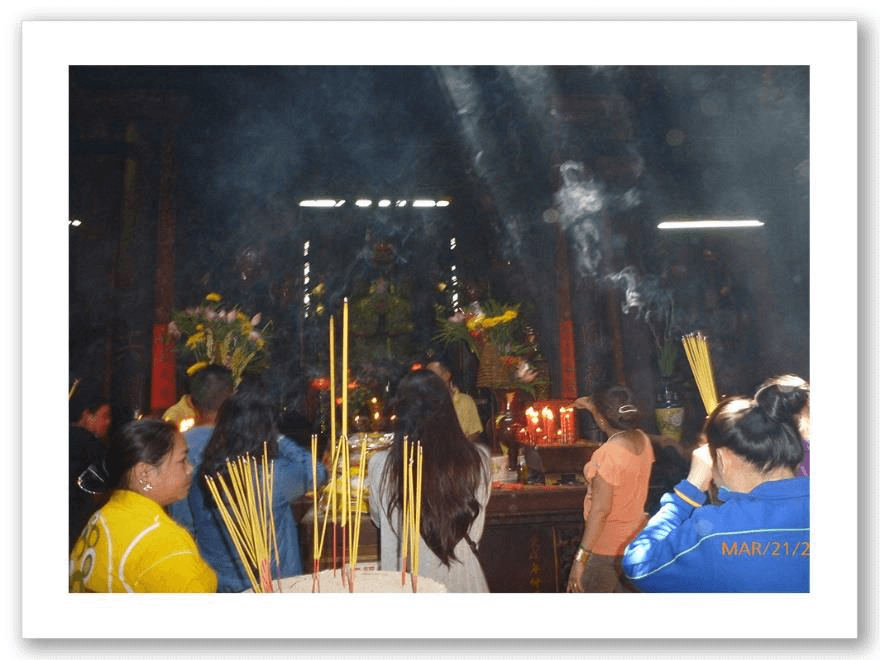
happened in my early life, I
was never too fired up about
this ritual trip, but I thought I
had to go back to get closer to
her memory—wrong.
The place was jammed
and the cash registers were
singing. I sat down and
watched the “action” and, to
my mind, if Luther were to
come back to earth and land
here with a small chainsaw
the place would be match-
sticks in minutes. Supplicants, paying fistfuls of money to keep the oil going for
the lamps, and the air thick with incense. I am not knocking incense, but how
does a spirit sort out whose incense is whose? I sat there quietly, a relative term,
with the hordes seeking benefits. I waited patiently, hoping there would be a
seventh inning stretch—there was none. I watched the hustle, and I use that
term in the street sense, and sadly reached the conclusion that if Micheline
Anne’s spirit were to be found, this was not the place. I lit my handful of joss
A Step Back In Time
Page 25
sticks, made my way out of the sanctuary, and was greeted by an altar that
captured it all for me.
Giving a new meaning to “pay your way into heaven”, the altar is guarded
by its own steel safe. I sat down to watch and see if you prayed first then paid,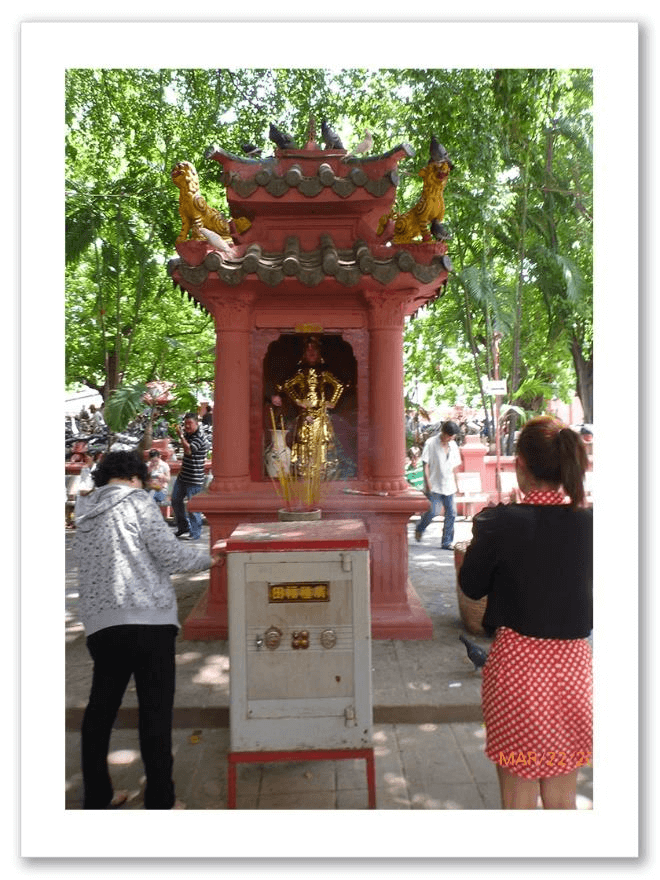
paid first then prayed, or applied for
spiritual Medicaid. Leaving aside the
cynical nature of my voyeurism, the
results were quite startling—capitalism
and bourgeois morality ruled, as all but
three worshippers paid first. But I was
pleased to note the three who took the low
road. If you want to get in touch with the
spirit world in this place, bring lots of
dong, because if you spend even a few
moments watching “the action” Marx’s
“opiate of the masses” springs readily to
mind. Micheline Anne and I will meet in
some tranquil spot—this did not even
remotely approach such a spot. The Jade
Pagoda has none of the tranquility of Lao,
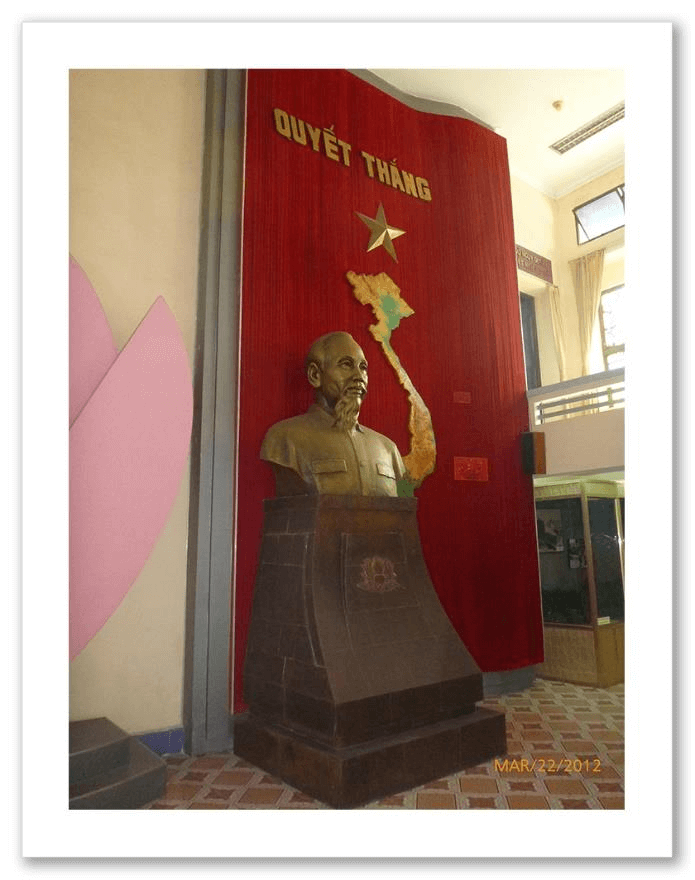 Japanese or Burmese temples. It is an
Japanese or Burmese temples. It is an
oil-burning, money-making spiritual
casino with not the slightest hope of a
payout—no solace.
I decided to head away from the
madding crowd and hit the Military Mu-
seum. The trip was interesting, on a very
modern road, old structures juxtaposed
with new high rise apartment buildings.
I arrived at the entrance where I
was greeted by two neatly dressed high
school age guardians of the revolution-
ary flame. She, I noted, was studying
advanced algebra and he quantum
physics—both books in English. I was
escorted into two cavernous halls which
Page 26
A Step Back In Time
meticulously detailed the NVA’s ’73 and ’75 campaigns. I was politely asked if I
wished to be escorted as I toured the exhibits. I declined the invitation, but asked
if there were any additional visitors that day; there were none.
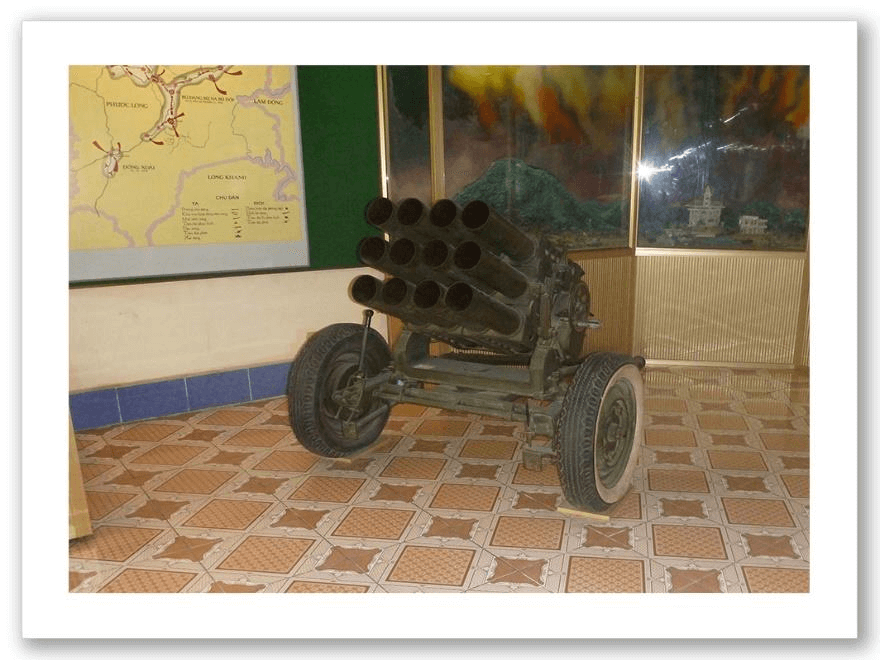 The halls were huge,
The halls were huge,
with military maps detailing
the developing events, and
numerous small machines of
death everywhere; the big
machines of death were out-
side. As is my wont, I decided
to explore the building, and
the next room I entered was
a large banquet hall that was
beautifully decked out in
white for a wedding to be held
that evening. Much hustle
and bustle setting up for what I guessed to be a wedding for 400 “intimate”
friends. Despite my recent strange interlude of l’amour fou, I decided to investi-
gate. As is the custom at Vietnamese weddings, pictures of the bride and groom
were prominently displayed. She, youngish and your basic ten-star knockout, he
considerably longer in the tooth, jowly, with triglycerides on fire—a match made
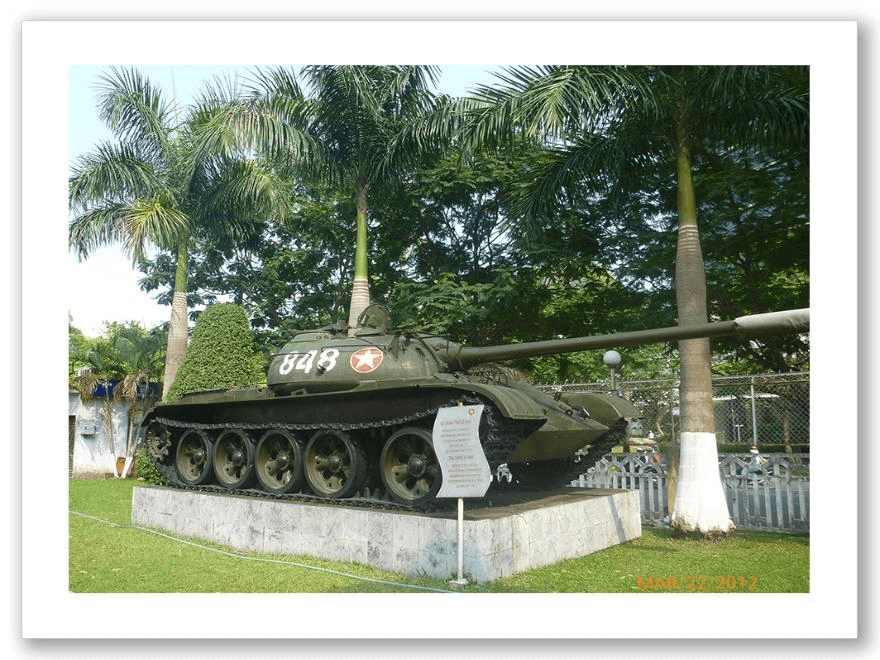 in heaven.
in heaven.
It was the seating that
got me. Chairs were lined up
in rows of thirty—no tables.
Now, I have been led to believe
that weddings provide fertile
ground for wolves of both
sexes to prowl. How do you
prowl when the object of your
desire is in Seat 24 and you
are in Seat 2? Despite recent
personal setbacks, I am still a
believer à la Robert Browning
and Elizabeth Barrett Browning’s initial encounter; here, alas, there was little
chance for potential lovers’ eyes to lock over the Gruyere. An invitation, no
A Step Back In Time
Page 27
matter how subtly nuanced, to view the ’73 Highlands campaign, or perhaps in
the next room the ’75 Highlands campaign, hardly strikes a romantic chord. A
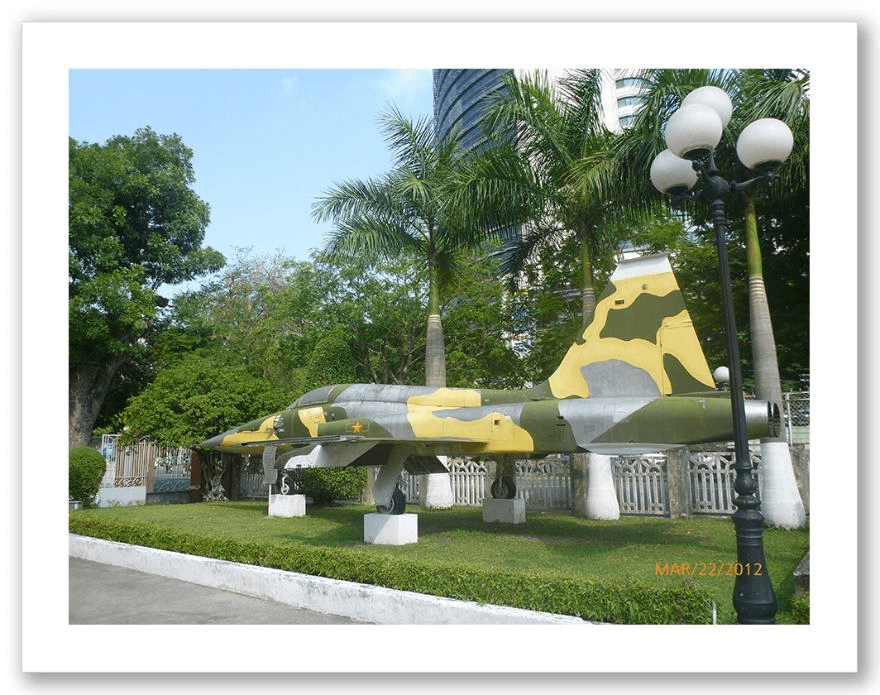 coquettish suggestion to take
coquettish suggestion to take
a moonlight stroll amidst nu-
merous machines of death—
planes, tanks, and B-52 wreck-
age—leaves a great deal to be
desired romantically, with the
possible exception of a chance
to steal a kiss in the shadow of
the clearly erotic SA-2.
Although not able to
attend, I wished the couple and
their guests, as they hike the
romantic trails of life, well.
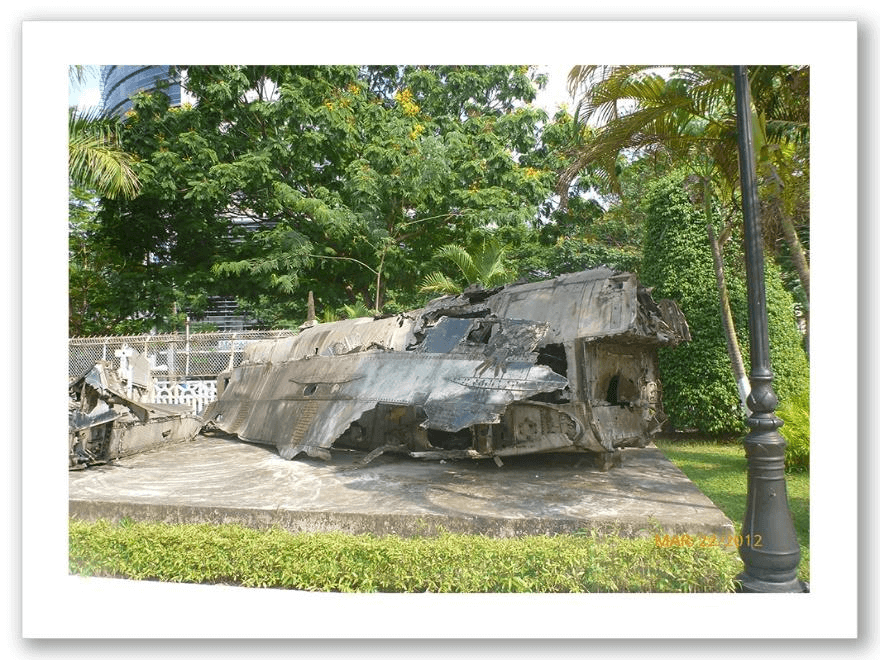 A little down from the
A little down from the
museum I treated myself and
the driver to warm Cokes and
contemplated “the meaning of
it all.” L’amour fou is such a
ludicrous concept; the game is
fixed from the start.
I returned to the Contin-
ental, got another Coke, and
sat on the veranda. Across the
way in front of the opera house,
actors in traditional ancient
costume posed for tourists and
were much the rage. It struck me that they also did this fifty years ago to attract
patrons to the evening’s performance. The actors worked hard for two hours, but
I noted that none of the tourists proceeded to the box office to purchase tickets.
As the sky grew dark I attempted to get into the construction site but with-
out success as the site was guarded. Another evening of increasingly malevolent
thoughts as I sat on the veranda. The hotel people were great. They left my table
but put away all the others. Empathy, or afraid I might go off? I walked to the
flower market, purchased eleven yellow roses (my calling card), returned to the
Page 28
A Step Back In Time
site, estimated where Micheline Anne had fallen, laid the roses there, and spent
the remainder of the night guarding them until I went upstairs to pack. When I
came down at 04:30 the roses were still there—inadequate and terribly sad, but
the best I could do.
I had an 0 dark thirty flight to Hue. When I arrived at the domestic ter-
minal things were a bit slow so I had tea and a roll. I moved to a seating area
and, strangely, saw my server running after me. Explaining I had overpaid she
handed me a 200 dong note (10 cents). I estimated she left her post and ran 200
feet—behavior that is far from the norm in the U.S. When I thanked her I hoped
she was as touched as I was by her gesture.
I read in the morning’s Saigon Post that Viet Nam was experiencing an
economic downturn. You could not divine this from the domestic terminal, which
was soon jammed wall-to-wall and out the door. My dawn patrol flight to Hue was
chock-a-block full, and I was the only roundeye.
As we taxied out I saw an example of capitalism at work that I had noted
while waiting for my flight: numerous domestic airlines bearing exotic names
had sprung up. One of these “exotics” was on a different runway and the aircraft
was clearly a DC-9—what model I could not make out—the mists of history dim
the senses. I made a mental note never to fly that airline. Better to walk in.
Air Vietnam to Hue at Dawn
The flight to Hue was interesting as we played dodge ball with thunder
heads up to 35,000 feet—beautifully ominous, because if it started to rain it would
rain for days. Landed without incident, and where the ride into Saigon had been
a free enterprise eye-opener, the ride into Hue was just the opposite. Early in the
morning, little traffic—architecture crumbling French with some Stalinist accent
pieces.
We pass some small shops starting to open, but no people shopping. A tell-
ing point about the city: the taxi driver drove the speed limit and barely honked
the horn. None of the Saigon motorcycle hordes in evidence, a slow downtown. I
liked it already.
I was staying at La Residence. If you can, don’t miss it. The former Gov-
ernor General’s home, and it merits all five of the stars given by the Vietnamese
Travel Bureau—a jewel, staffed by gems.
A Step Back In Time
Page 29
I had previously corresponded with the hotel’s travel director and I made
a beeline to meet him. You would have thought I was the prodigal son returned.
He immediately expressed, and for the next two days constantly reiterated, his
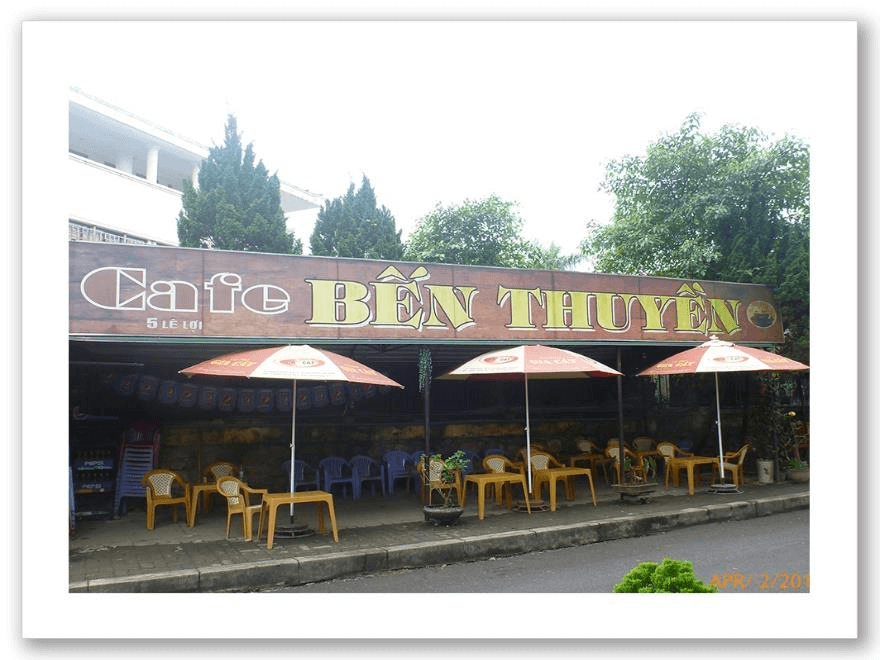 grave concern about the
grave concern about the
“walkabout”. He shut down
his desk, and we adjourned
to a café next door; this café
was to have a major impact
on my stay in Hue. The travel
director and I sat down, and I
engaged in a “self-criticism”
struggle with him about my
plans. He soon understood
my reasoning.
I have a spiritual aver-
sion to being charged five
dollars for a can of Coke or a bag of M&M’s. I found out I could buy a can of Coke
at this café for fifty cents. Also, I was put off by the way Vietnamese treat their
lotto sellers. Sure, everyone knows the lotto is fixed and crooked, but these kind,
elderly women are gentle souls, living a marginal existence and, unlike beggars
in other cultures, never aggressive. It torqued me to see them waved off with a
disdainful flip of the right hand, or worse, completely ignored. I decided to do
something about it. I quickly noted that the café was quite exclusive. In fact,
two other parties sitting five feet from each other barely spoke. Not a word ex-
changed as one passed a newspaper to the other.
Welcome to “Harry’s”
The next lotto seller came by. I immediately bought two dollars’ worth of
lotto tickets, invited her to sit down with us, ordered a Coke and handed the lotto
tickets to the proprietor—an unprecedented occurrence I am sure. The joint was
now mine, and I named it “Harry’s”. While in Hue I made it my headquarters
and over the three days following my “good luck” gift to the proprietor I received
oceans of free black tea. There is something so delicious when a club manager
knows what you drink and what your guests, three lotto sellers, drink—Cokes all
around. A new blow for American capitalism. The atmosphere in Harry’s was
Page 30
A Step Back In Time
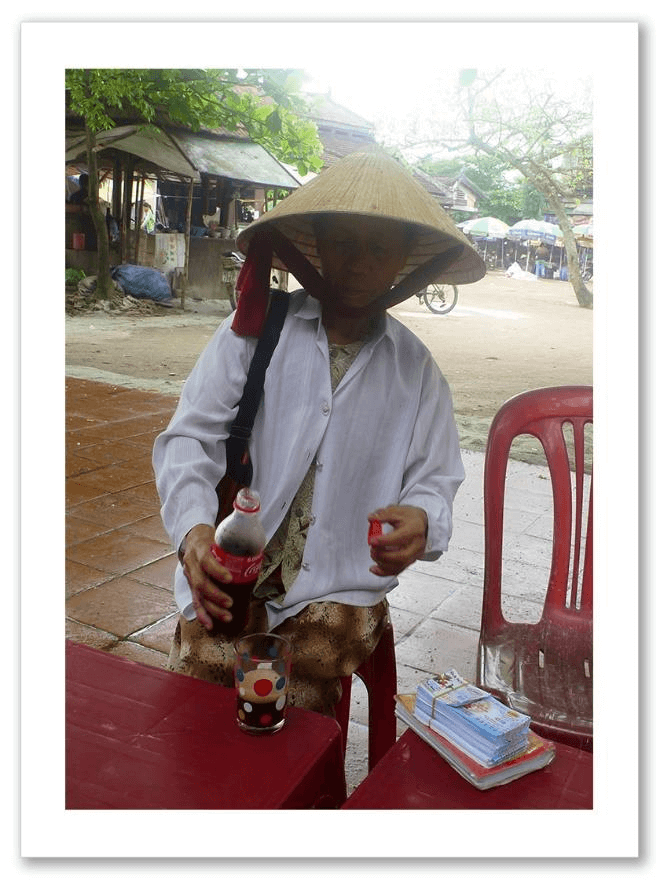 peaceful, relaxing, and on a subsequent
peaceful, relaxing, and on a subsequent
visit I jealously guarded the panache of
the club. The old women and I could not
communicate with each other, so we sat
in companionable silence, taking a load
off, and contemplating “the meaning of
it all.” Sadly, it could not last forever. I
reminded myself that when I return
I must bring some Bach, Beethoven,
Mozart, and Wagner’s “Overture to the
Flying Dutchman.” This will put us well
ahead of the pack musically; he who
controls the velvet rope sets the tone.
Harry’s was to provide another
personal highlight of the trip. Way back
in the ’50s I became enamored of a style
of Chinese scroll painting I called “karst
painting.” At the time I believed the scenes were all in the artist’s head. I was
wrong, but it took about forty years to correct my misinterpretation.
I had mentioned karst painting to a client’s brother and he set me straight
by inviting me to join him on a trip to Guilin on the Li Jang River—a more than
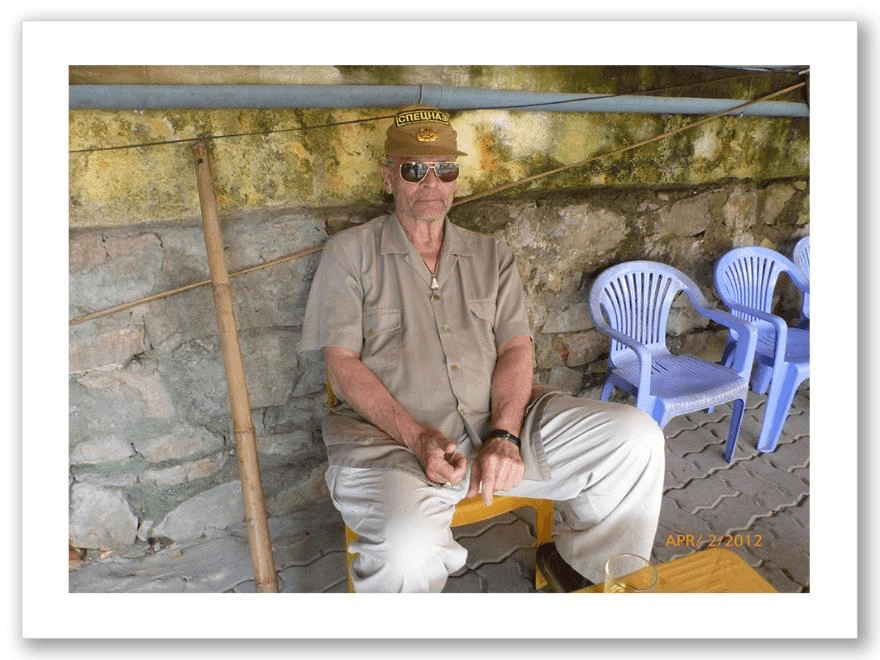 moving experience provided
moving experience provided
by a man who even in defeat
knew victory. After coming
off the river the client’s
brother and I repaired to a
piano bar at a Holiday Inn
where a most enjoyable
tuxedo-clad piano player
entertained the two of us.
Still on a high from the river,
I noted the pianist playing
many romantic songs in a
very distinct style, including
a song which would turn out to be Richard Clayderman’s “Murmures.” I asked
him to play it again and I was on a roll: champagne—two bottles—for the pianist
A Step Back In Time
Page 31
and my client’s brother. I don’t drink, but I have been told they thought it was a
great party. Richard Clayderman touched my romantic soul.
While at Harry’s on the evening of the third day, I heard a Clayderman
song and asked the owner to play it again, and he did. When it finished, the
owner, who spoke no English, handed me the disc and said “un souvenir pour
vous.” I politely declined but the moment will never be forgotten.
“The Imperial City of Hue,” the former royal capital of Vietnam, had been
a seat of learning and the arts. During the war it was captured by the Viet Cong,
and 6,000 inhabitants, who had been selected for liquidation prior to its fall, were
murdered. For several weeks Hue held out, despite continuous air assault which
pretty much leveled the city. The Viet Cong flag flew over the citadel and was a
continuous target for the besiegers to knock down. I once saw a T-shirt for a
mortar crew which showed a 91mm mortar with the caption “We are into earth-
moving and instant urban renewal.” We pounded it non-stop, but never com-
pletely succeeded in knocking the flag down. The psychological point was made
and is still being made today.
The city was going nowhere and falling into decay until 1990 when some-
body recognized that tourism could bring it back. Whatever your political
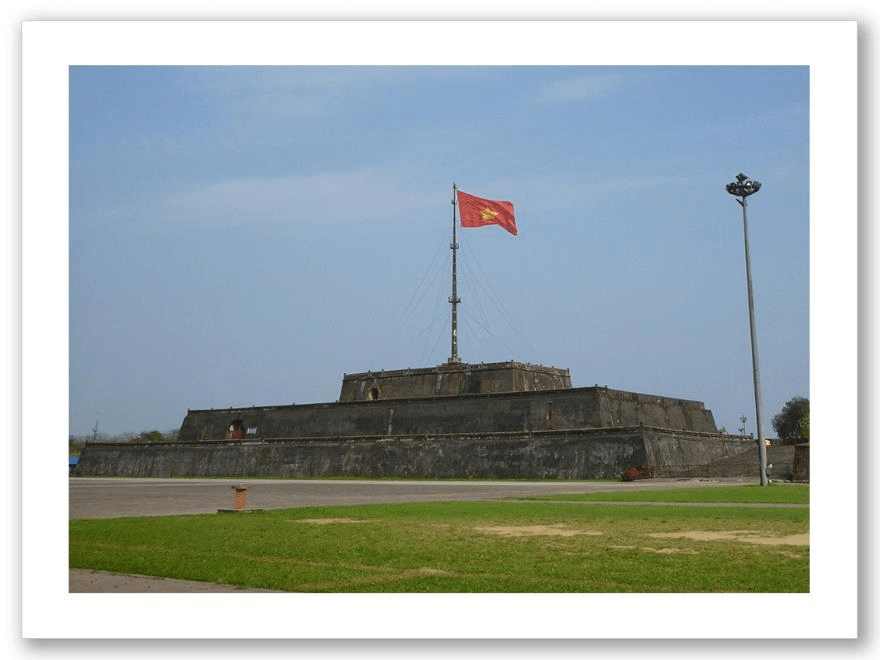 persuasion the promoters
persuasion the promoters
have clearly done a good job,
particularly with the wind
machine that blows the flag
(half a football field in length)
that flies over the citadel day
and night. Before I toured
the citadel I wanted to walk
around it. This was great fun
because the fortress is sur-
rounded by an impenetrable
fence of small enterprise
shops selling everything—
clothing, electronics, even a Viet Cong flag, which I immediately scooped up for
my SDS friend.
I returned to Harry’s for an evening with Richard Clayderman—it does not
get much better than this! Clearly Hue exhibits a cachet that Saigon might have
done well to consider, but unfortunately it is now too late, as Saigon has gone too
Page 32
A Step Back In Time
far down the Lotus and Lamborghini path to turn back. Vulgar materialism has
not, for a multitude of reasons I suspect, overwhelmed Hue. Not such a bad thing
to live in a less materialistic backwater.
Today I meet my travel mentor for another round of strenuous struggle
and self-criticism, and I tell him to forget about trying to talk me out of the walk-
about. I am going, and I need some help. He asks who is Bernard Fall and why
am I so interested as to where on Route 1 he died—no one knows him or has ever
heard of him! He persuades me to take a tour of Hue and its environs, and sug-
gests that perhaps some tombs would interest me. I am skeptical, but again I am
to be proven wrong, not about the tombs, but, as it turns out, about the social
activities attendant to the tour.
A Long Day with Emperors Long Dead
I dread tours, but when the small van arrived, I thought we were a tour
of four: myself, another man who was leaning against the door, and two dour
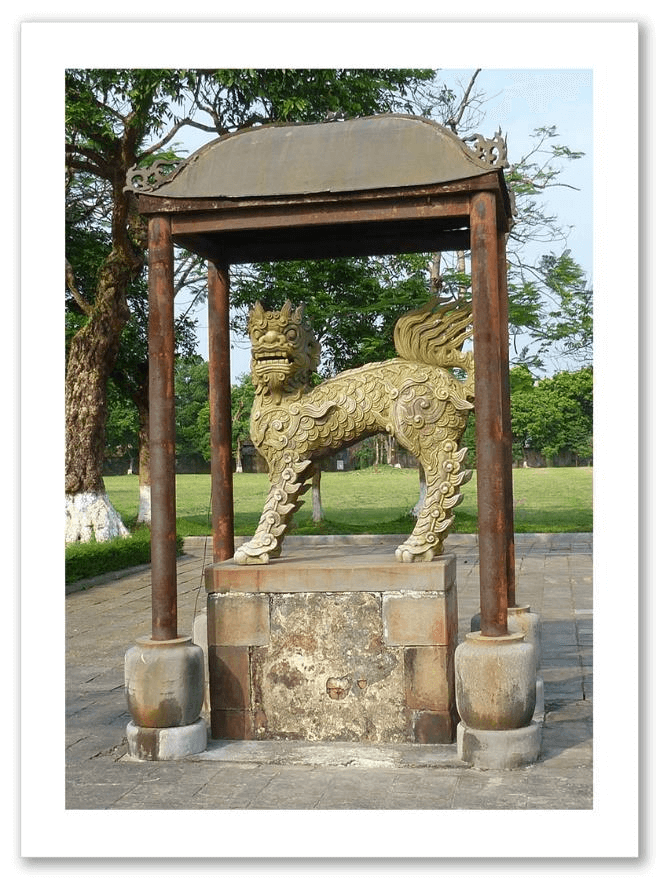 Danes. Off we went, the Danes giving
Danes. Off we went, the Danes giving
me quizzical looks and pointing to my
left where a young couple emerged from
a death clutch. One eight-limbed body
became two, and when she came up for
air I guessed she was fourteen and he
not much older. Vietnamese honey-
mooners on their way to see the Tombs
of Emperors Two, Three and Four—can
it get more romantic than that?
It was Children’s Day and many
visitors to the tombs appeared to be
deep into necrophilia. While no doubt
intriguing, I was more interested in the
social aspects, past and present. It ap-
pears that King Three was “as one” with
his Khmer buddies across the river,
having spent thirteen years in France. He decided his tomb should be made all of
glass with little or no Vietnamese input—France will do that to you. To pay for his
monument, he raised the taxes on food 50% and cut the rations of his workmen.
A Step Back In Time
Page 33
Voila! Starvation of the peasants and the death of 50% of his workmen—Jaya-
varman II was alive and well in Vietnam.
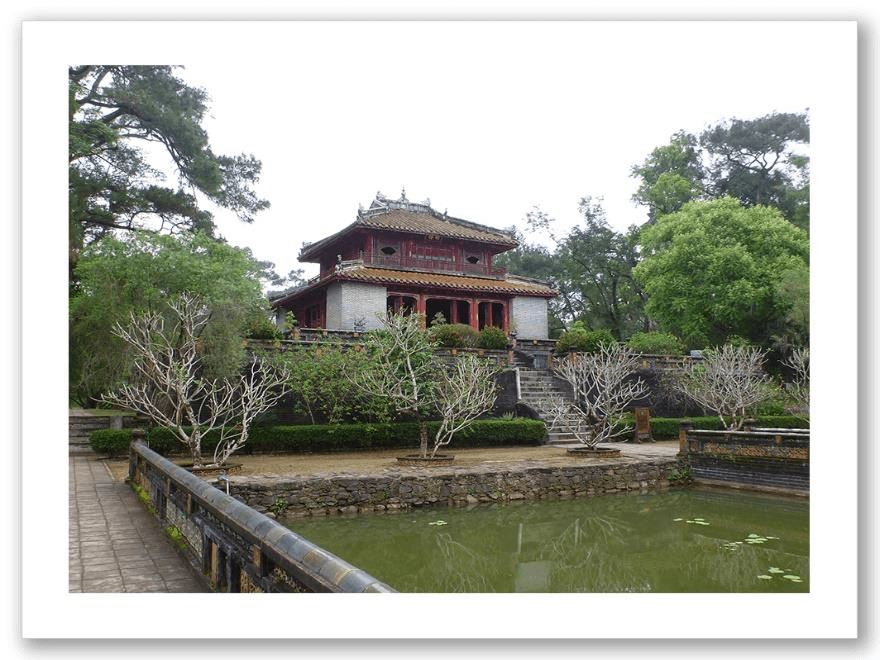 The guide was quick
The guide was quick
to point out that this king, al-
though childless and down to
twelve concubines from his
predecessor’s two hundred,
was not gay. France will also
do that to you, and clearly
there is a serious issue here
that must be addressed by the
gender industry crowd.
Scientifically, I am not
sure how the guide arrived at
his conclusion, but I took it at
face value. In a conversation later that day a Vietnamese nationalist journalist
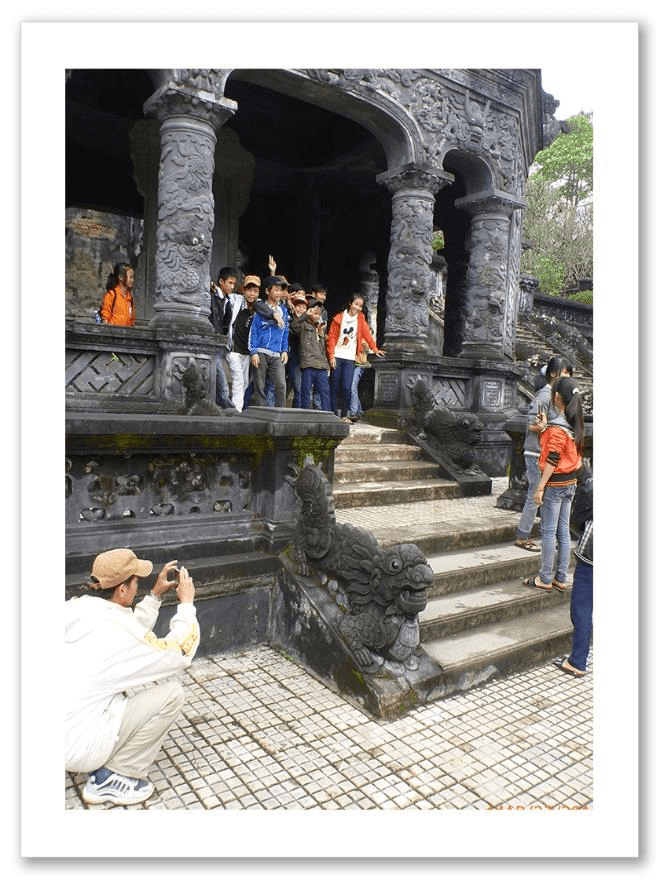 observed that this glass tomb was the first
observed that this glass tomb was the first
of many curses the French had inflicted
upon the Vietnamese people. Decorum
prevented me from probing further to
ascertain the other curses French civili-
zation had bestowed on Vietnam.
As previously noted, it was Chil-
dren’s Day, and with hordes of children
everywhere it was difficult to get a handle
on “the meaning of it all”, but one tableaux
was worth the trip.
Approximately twelve or more Viet-
namese teenagers, all relating to the past
glories of their emperors, cavorted by the
tombs. All had cell phones and cameras,
virtually all were talking on the phones,
and one, in a Mickey Mouse T-shirt, was
doing an excellent rendition of a Hollywood starlet, cameras blazing away. This
went on for several minutes and I was pleased to see that they were all dressed
Page 34
A Step Back In Time
like MTV goons. You gotta love American TV and the “civilizing” influence of
cell phones.
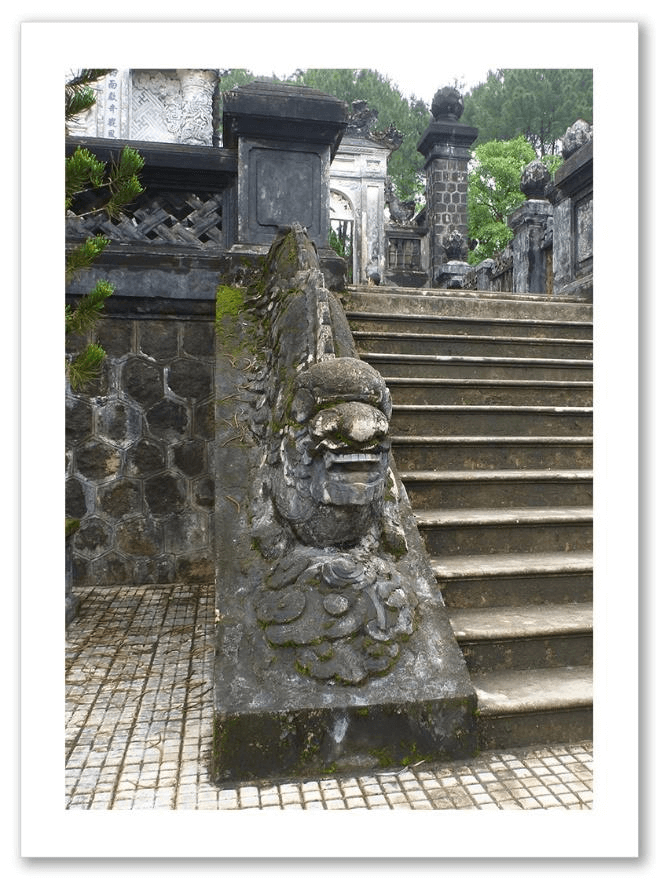
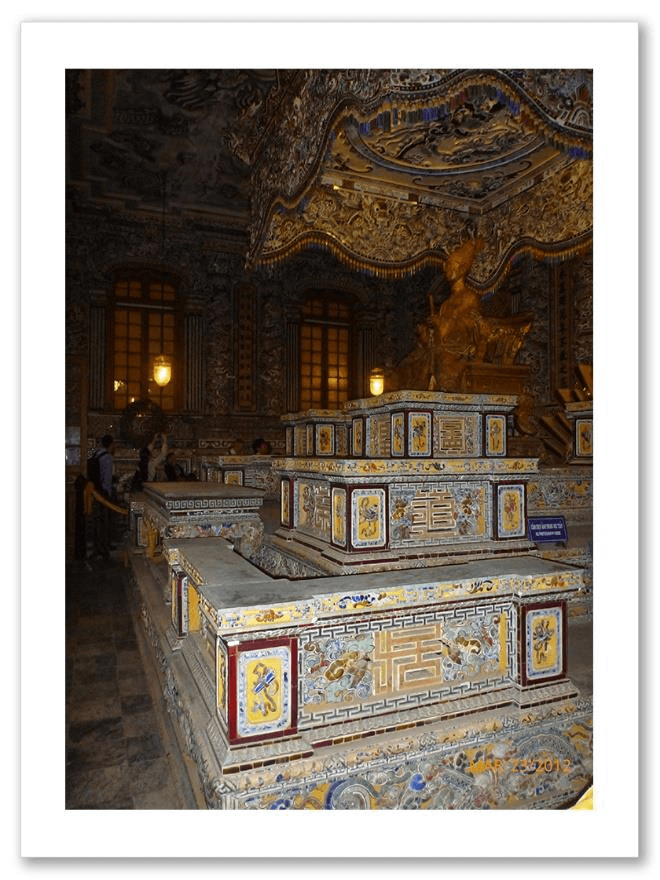
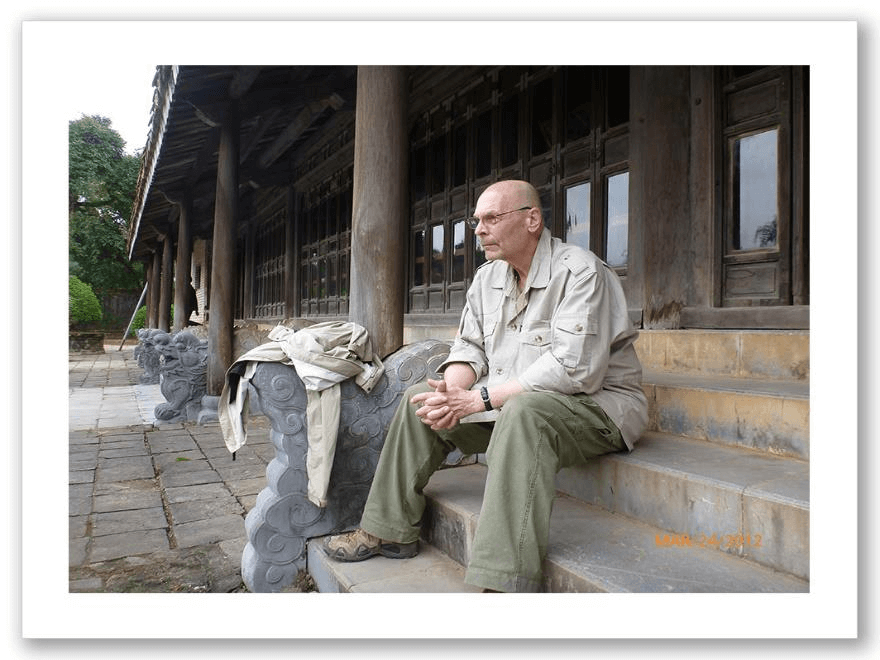
A Step Back In Time
Page 35
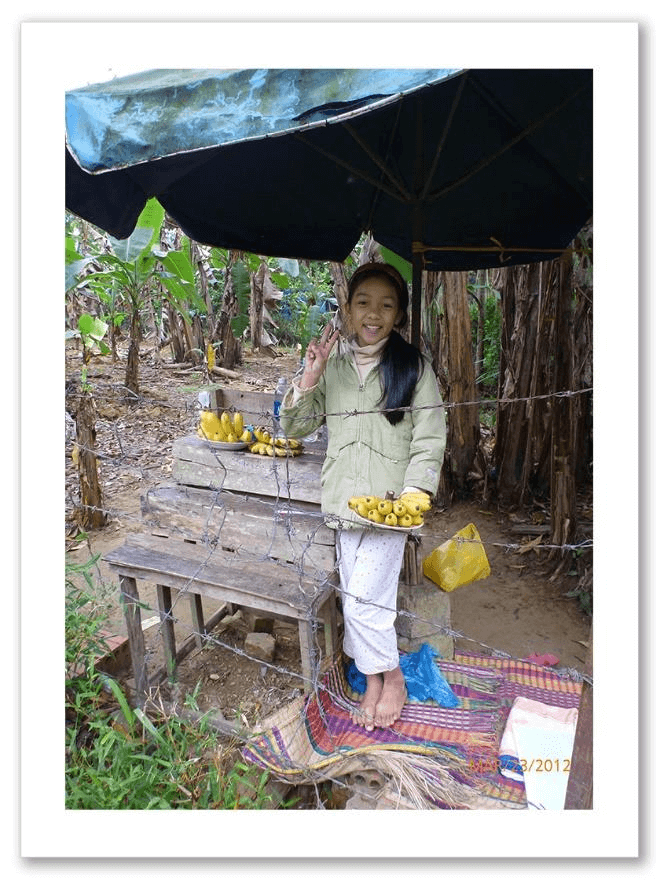 However, all was not lost. As I was
However, all was not lost. As I was
leaving the last tomb I encountered a
young banana seller, bought all of her
bananas, and tried to put the other Rocky
Horror Show out of my mind.
Tours of this type the world over
always end with the obligatory shake-
down when you are herded into a curio
shed or shop. However, as these things
go, this one wasn’t too bad: I learned how
they make incense and conical hats. Sad-
ly, despite a fleet of other tour buses little
incense appeared to be changing hands.
I bought some for Harry’s, gave it to the
manager, and that evening the owner and
the lotto sellers got on a cosmic rail to
heaven knows where. As we left the curio
caves the male honeymooner and the driver were having some fun at what I be-
lieved to be the young lady’s expense. This did not bode well for a life filled with
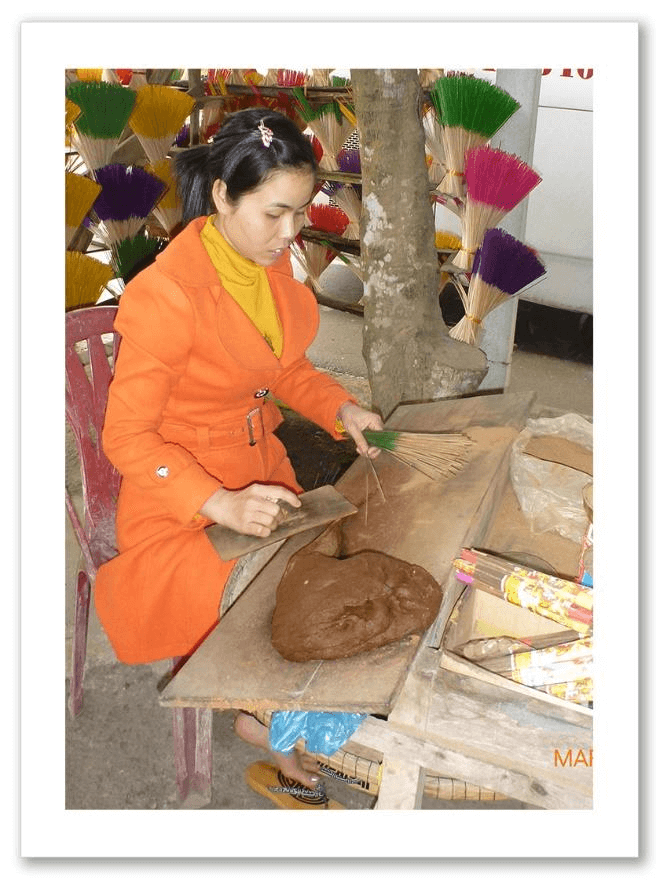
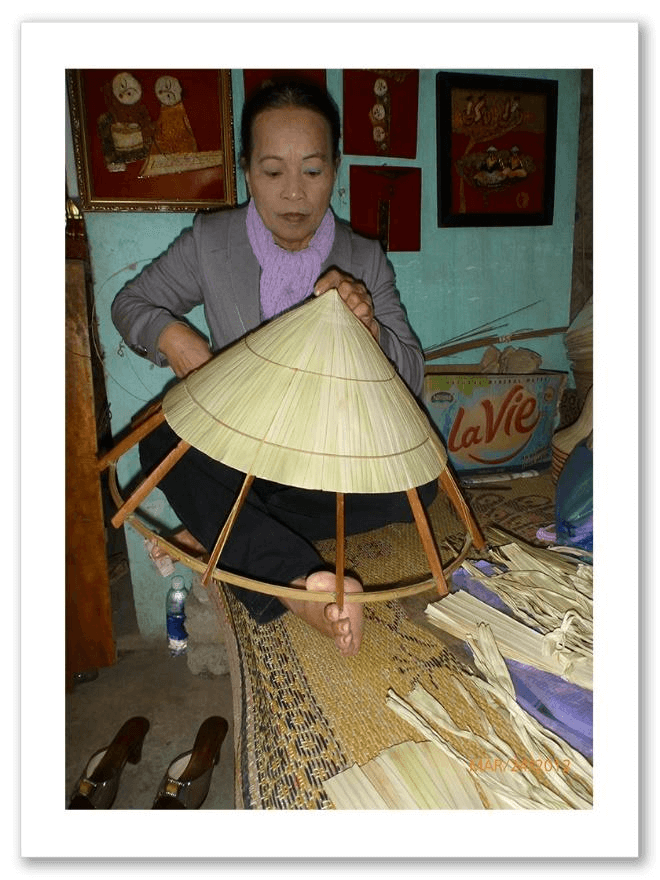
Page 36
A Step Back In Time
marital bliss. As we pulled out of curio alley I spied a flower seller, told the driver
to stop, and bought eleven roses—the seller was puzzled by the number, but I
didn’t have time to give her a précis of Japanese romantic gestures. Back in the
van, roses presented to the couple, the overall temperature much improved, we
continued our drive.
As I was being dropped off at the hotel I invited everyone to Harry’s, and I
was floored when everyone accepted, even the dour Danes—free soft drinks will
get them every time. A most unexpectedly pleasant hour as night fell. I give the
Vietnamese couple two years at best!
Back at the hotel the travel advisor told me his astrologer had suggested I
go to the countryside as good things would happen to me if I did. I agreed, and
the next morning, in a meeting that bordered on the bizarre, the astrologer gave
instructions to the scooter driver, and we headed into the countryside in search
of the Thanh Toan Bridge.
Within fifteen minutes we were traveling through small villages, with
paddy cultivation as far as the eye could see—on the point on a motorcycle! Ex-
cept for a few modern improvements the villages were as they were one hundred
years ago. A field problem every five hundred yards; those death dealing tree
lines were everywhere, with burial mounds thrown in for good measure. It sent
chills up my spine as the real Vietnam came to life. It was magical—and it was to
get better.
I once heard a trooper describe “walking the point” as the ultimate sacri-
fice. (N. B. For the type of personality who relishes “the point” one can do no
better than Tiger Force by Michael Sallah and Mitch Weiss.) This same trooper
likened “search and destroy” to the old county fairs where they had metal ducks
on a chain in a water tank, and if you shot so many ducks you won a prize. He
said the only problem was, when you are crossing the paddies and walking on the
dykes you’re moving a lot slower than the ducks in the tank. I spent the better
part of an hour looking at tree lines, figuring in and out routes—right back into it,
and if you can do this trip don’t miss it. No guides, just you and your scooter
driver. Do not go in a car. It would destroy the ambiance.
I arrived at the village which, although small, is a gem. And, coming from
Grafton County in New Hampshire where Stanley Grafton lived and completed
the last modern day covered bridge, I appreciated Thanh Toan Bridge which was
completed in the 1400s. What I didn’t appreciate were the young teenagers
A Step Back In Time
Page 37
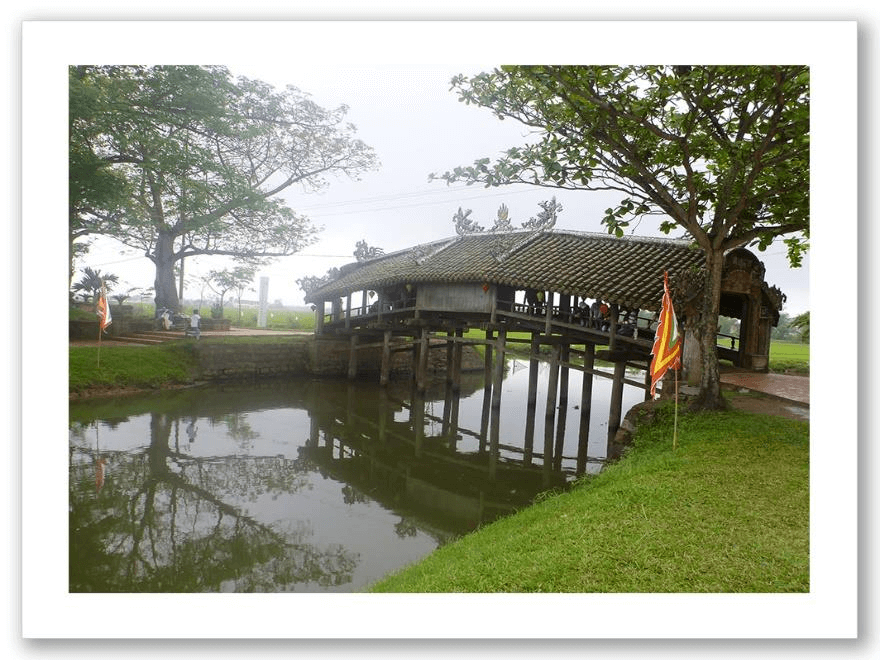 using the altar to set up their
using the altar to set up their
card tables. Six others dressed
and behaving like American
teenage trash were jabbering
on their cell phones.
I walked across the bridge
looking for a small museum I
had been told I should visit.
What no one prepared me for
was the human treasure trove
that awaited me. As I neared
the museum I saw, huddling like
Macbeth’s witches, three elderly
women, one of whom saluted me, and not a bad salute at that. I gave them a saw-
adee from the sky and we were off and running.
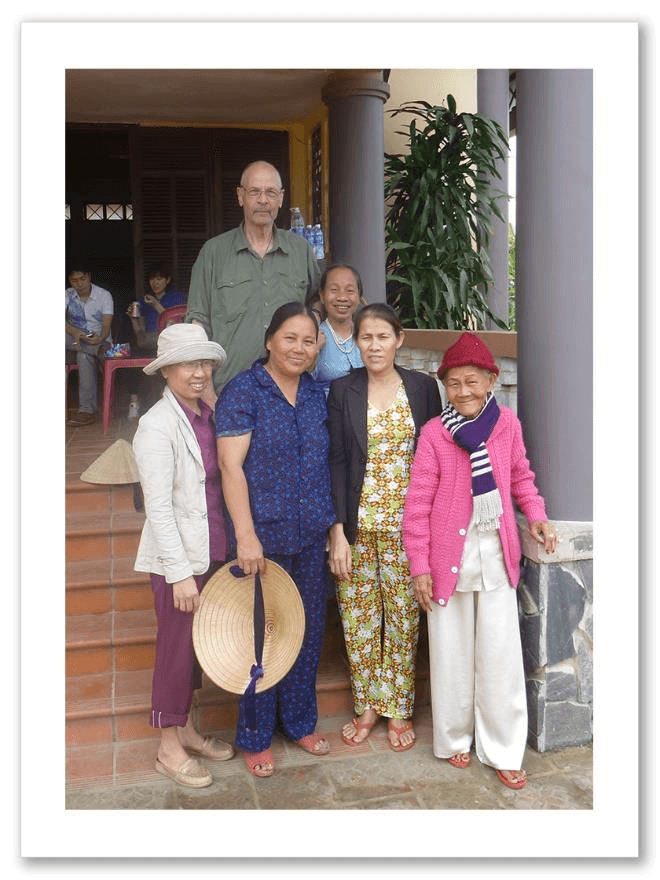
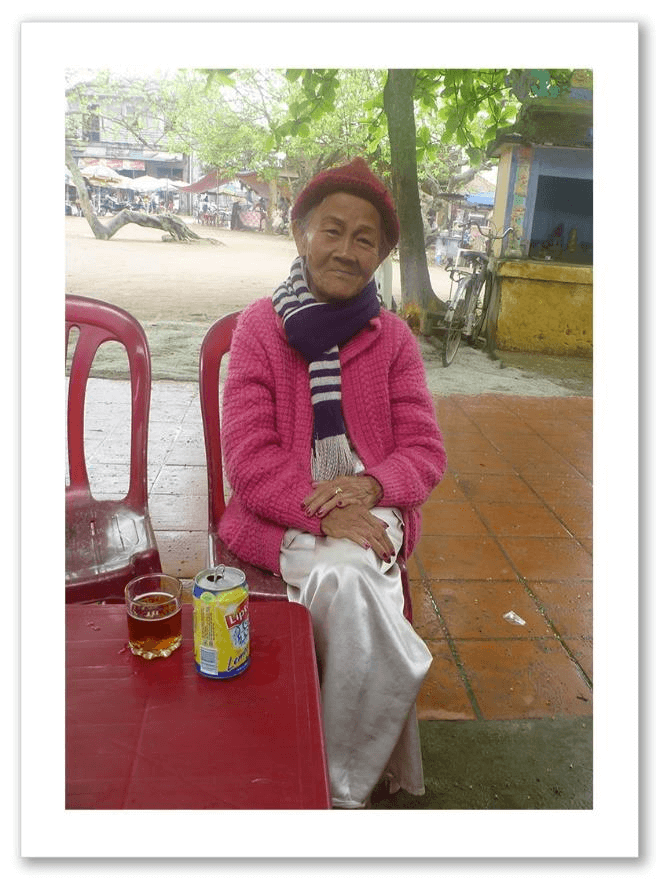
The museum was a sad attempt to recreate peasant life. There was a foot
operated paddy pump which one woman offered to demonstrate, but I said it was
not necessary. Cokes for everyone. But then providence entered the game with
the arrival of another elderly Vietnamese woman. She spoke broken English but
Page 38
A Step Back In Time
was able to unlock a cask of tragedy that illustrates the depth and scope of the
Vietnam War better than any book.
She was a laundry worker at Phu Bai, an army helicopter base; she met a
captain, and they were married. In 1968 during the Tet offensive he was killed.
Her language skill allowed us to extend the conversation to four other women
who had lost sons, lovers and children. The toll exceeded seven. One woman
cannot visit her son in Texas! I spent an afternoon I shall never forget, and their
willingness to open up their hearts more than touched me. However, the obser-
vant will note that my initial muse did not drink Coke, but Lipton tea—a charac-
ter lapse that I will not hold against her. I cannot find an adjective that would
adequately express my feelings for that day. I told the motorcycle driver to go
slow as I wanted to savor the countryside as we returned to the hotel through the
paddies—twilight field problems every 500 yards. When I hit the hotel I told my
travel guru that I was leaving ten bucks for the astrologer. He said that ten was
too much and I should leave five, as we did not want to give her the idea we were
anything but skeptical about the accuracy of her readings—heady stuff!
Searching for Fall’s Ghost
As previously noted, Bernard Fall provided an initiation and constant
companion to any young special operations officer in the early 1950s. His books
were devoured by young officers but sadly not understood by the “heavy metal”
guys. One of the cornerstones of the trip was to walk “The Street Without Joy” in
an attempt to honor Fall by learning where on Route 1 he was ambushed.
I spent three days asking anyone and everyone where Fall had been am-
bushed in February of 1967. Some professed not to know him, and no one knew
where he was ambushed. My tribute has to be a mental one, but it is a debt every
special operations officer who served in Southeast Asia, or anywhere else for that
matter, owes to a very special man and warrior.
My travel maven said he had the finest guide in Vietnam (a woman) and
when I asked whether she knew what I was trying to do he said she would know
by the time we met. He urged me to take a car all the way. I rejected this out of
hand. I told him to have her meet me in My Chanh the next morning and be pre-
pared to walk twenty-five miles. I was dubious about meeting a female guide
who knew nothing about military matters for a walk on “The Street Without Joy”.
This jaunt was to be a warm-up for the trip into the Highlands, a shakedown
cruise, if you will.
A Step Back In Time
Page 39
A Walk with Comrade Chris on “The Street Without Joy”
Cool, overcast
We roll into My Chanh. I meet my guide, henceforth referred to as “Com-
rade Chris”. Short, cadre haircut, those terrible cadre glasses, a real apparach-
niki. And just what I needed—blessed with a quick mind, so sharp you could cut
steel with her intellect, and a blazing sense of humor that made our twelve hours
together the most interesting and hilarious I have ever had the good fortune to
spend with anyone. She opened with “Captain, I couldn’t get any U.S. military
maps, but I did get the French one at the time.” With this opening I knew I hit
the guide jackpot. I just didn’t realize what a monster jackpot it was going to be.
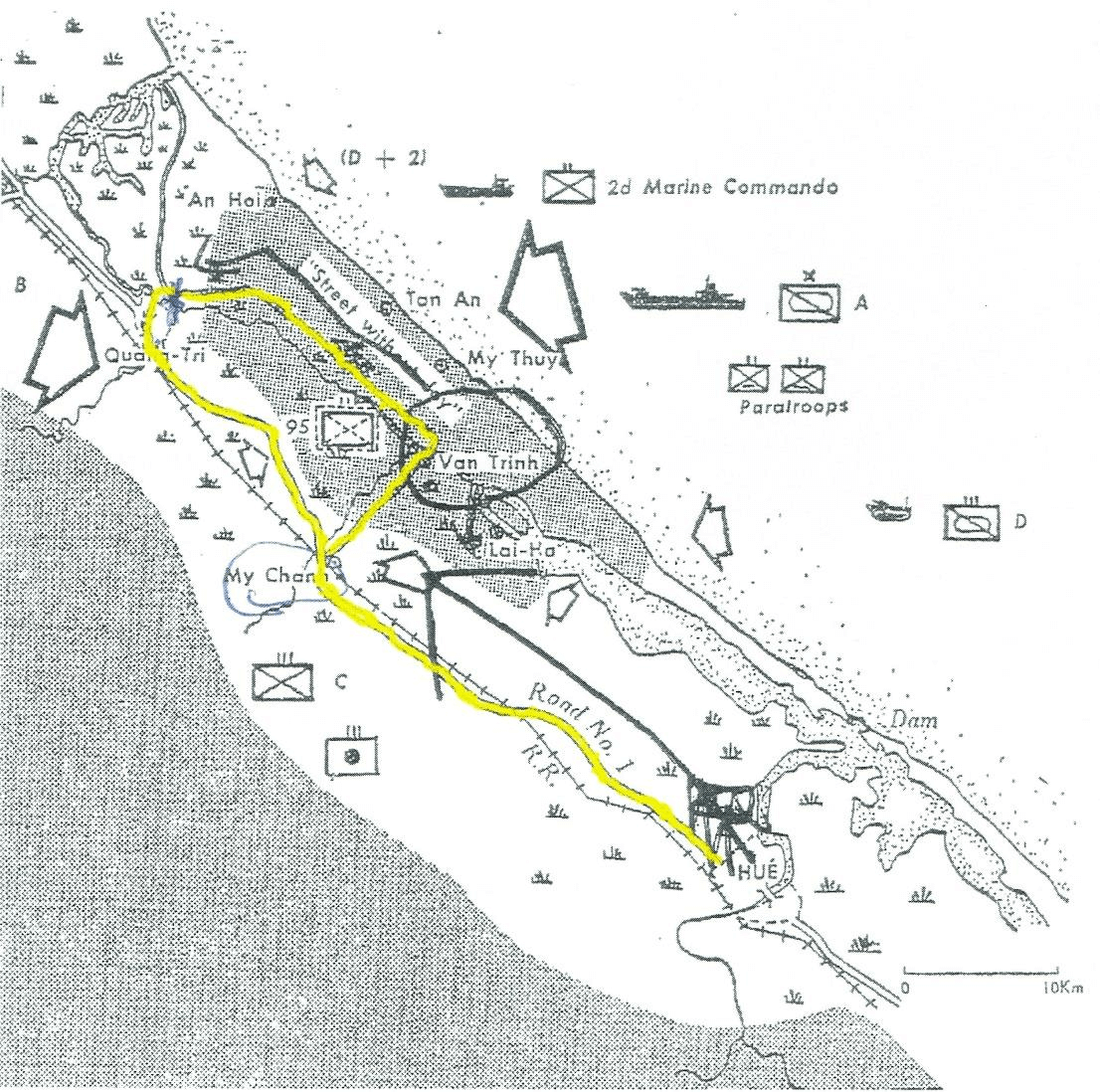
In simple terms, “The Street Without Joy” was an approximately twenty-
five mile stretch of road that paralleled Route 1, the main north-south road
connecting Saigon with Hanoi. Viet Minh used to come from fortified villages to
ambush road traffic on Route 1. The French mounted perhaps the largest joint
Page 40
A Step Back In Time
military operation since World War II with the object of trapping the Viet Minh
in a bottle. The operation failed because although the trap was sprung, a lack of
knowledge of precise weather conditions, local terrain, and some poor and over
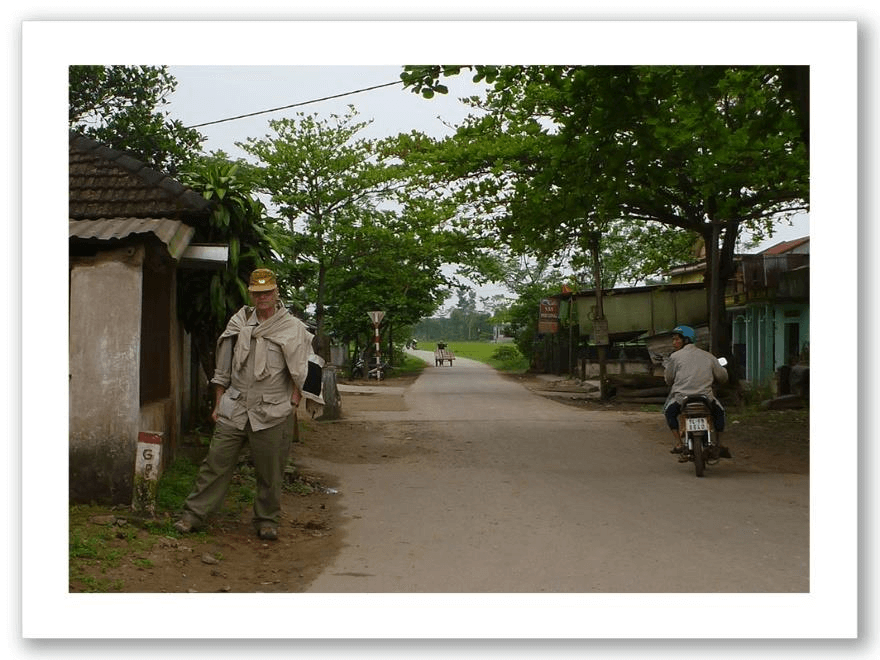 complicated planning doomed
complicated planning doomed
it to failure. Hard to believe,
since they had been in the
country for thirty or more
years, and, faulty or not, in-
telligence on their adversa-
ries’ dispositions led to about
an equal number of casualties
on both sides. The French
military pronounced the
operation a resounding vic-
tory. The troops knew other-
wise.
We headed to a small crossroads town, which on the earlier maps is named
Van Trinh, but has been renamed Xuan Vien. Set our packs and started down a
level one-lane road, but not until after having been the center of attention in
Xuan Vien. I told Chris the locals were staring at her and she answered that they
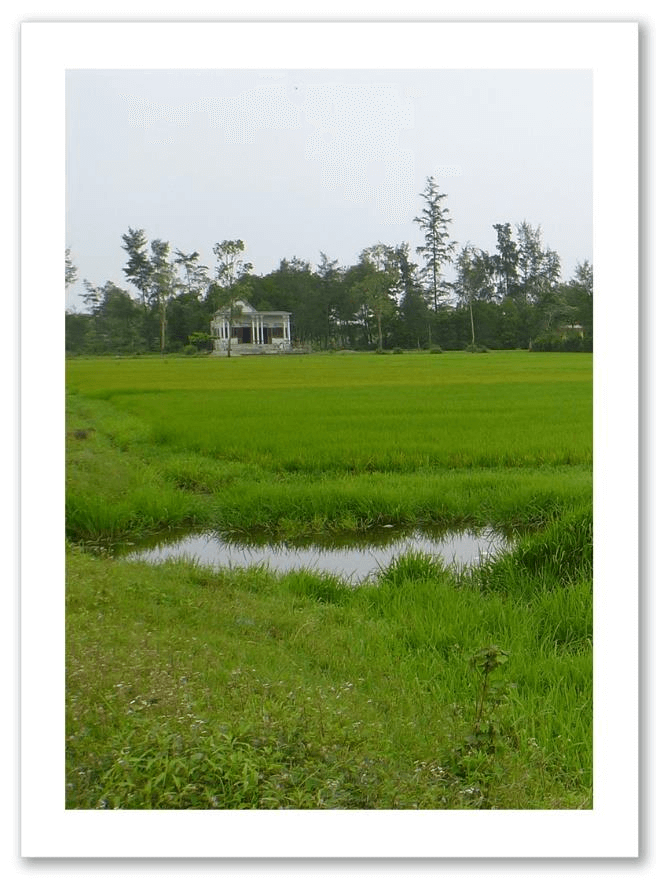 haven’t seen many “big men from the
haven’t seen many “big men from the
East with Ray-Bans” as we were pretty
much all driven out after ’68. The little
apparachniki has very sharp teeth and
claws!
We had only gone a few kilometers
and the field problems quickly became
clear: tree lines to both east and west
bisected by a large dyke, and you were
in the duck gallery as you moved down
the road. Chris checked off the fortified
villages from the 1950s as we made our
way. We even passed the occasional
errant bomb crater from the last war.
As we walked I told Chris of my failures
in obtaining a Giap T-shirt, and she said
A Step Back In Time
Page 41
we might get lucky in Quang Tri City as it was still red. I learned that Chris’s
husband, a thirty year Party member, had come down from the North and they
married. She was proposed for membership in the Party but her husband—I
would love to meet this guy—said one communist in the family is enough; there
should always be one parent out of jail to take care of the kids.
When I queried Chris about Giap she indicated he is her kind of communist,
but my lefty friends should realize that Giap T-shirts are probably a thing of the
past—they may have a better shot in America. I pondered this revelation.
I told Chris that I would never go above the 17th parallel and that I fly the
South Vietnamese flag in my New Hampshire home; the neighbors don’t know
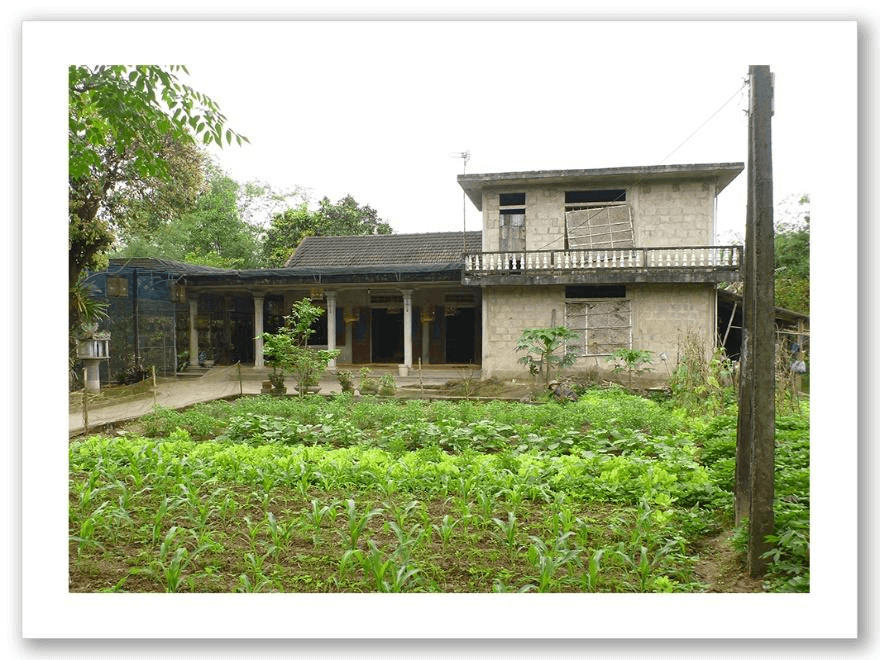 what it is. Her retort—and it
what it is. Her retort—and it
was a beauty—was that the
best pho noodles come from
above the 17th parallel and
because of my 17th parallel
phobia she would deliberately
not feed them to me because
if she did she would be held
accountable for my death and
her spirit would never know
peace. But if someone else
fed me the noodles, that
would be another story.
Little traffic and we move steadily ahead, passing clear indications that
every inch of cultivatable land is utilized, even front yards of nice homes under
refurbishment. We pull into our first checkpoint and find the driver asleep.
During the walk Chris expressed grave concern that I did not have chil-
dren and wanted to organize a contest of women, with traditional style hair worn
to the waist, who would have to walk from the Da Krong Bridge, in heels, to the
Delta. She did not believe there would be many takers and about 10 kilometers
should weed out all the pretenders. I told her I was touched by her concern, but
no Party members, thank you. Chris indicated she would add Mr. Dung of La
Residence, my travel guru, to the search committee, but would not tell him the
finish line was the Delta.
We are there for barely five minutes when people appear and question
us about what we are doing as nobody walks in the area. Three people: one a
Page 42
A Step Back In Time
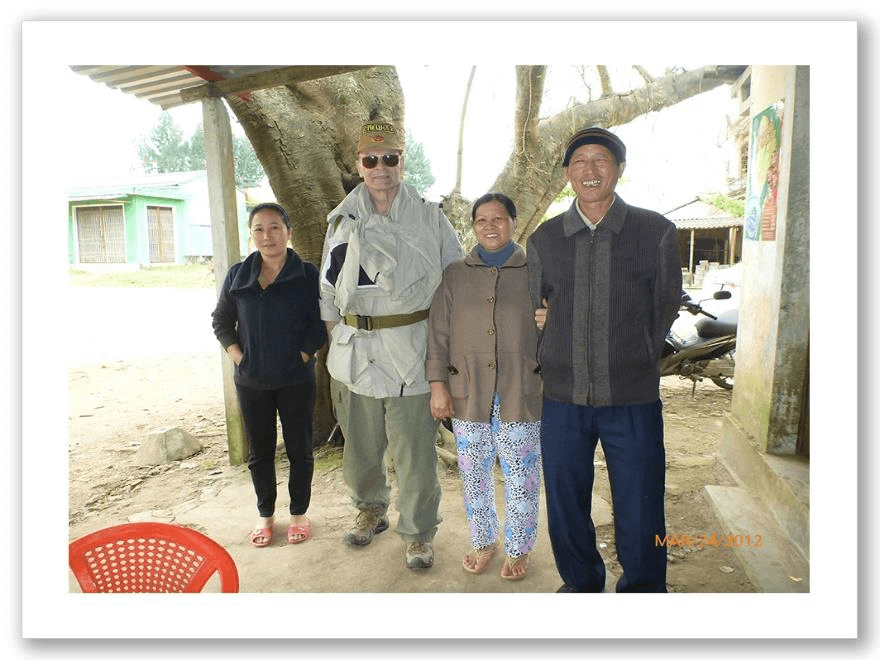 journalist who had been in
journalist who had been in
a labor camp for fourteen
years; his wife, interned for
four years; a mother, whose
son was ARVN and was
killed, held for three years—
the tales, all gut wrenching,
but no overt bitterness to-
ward the United States. I
am positive I would not be
so magnanimous.
We moved along quickly
and soon came upon family
memorials flanking the road. Relatives were supervising the construction of
and tending to monuments to their ancestors. Some of the descendants are
themselves approaching the century mark and are most willing to talk about
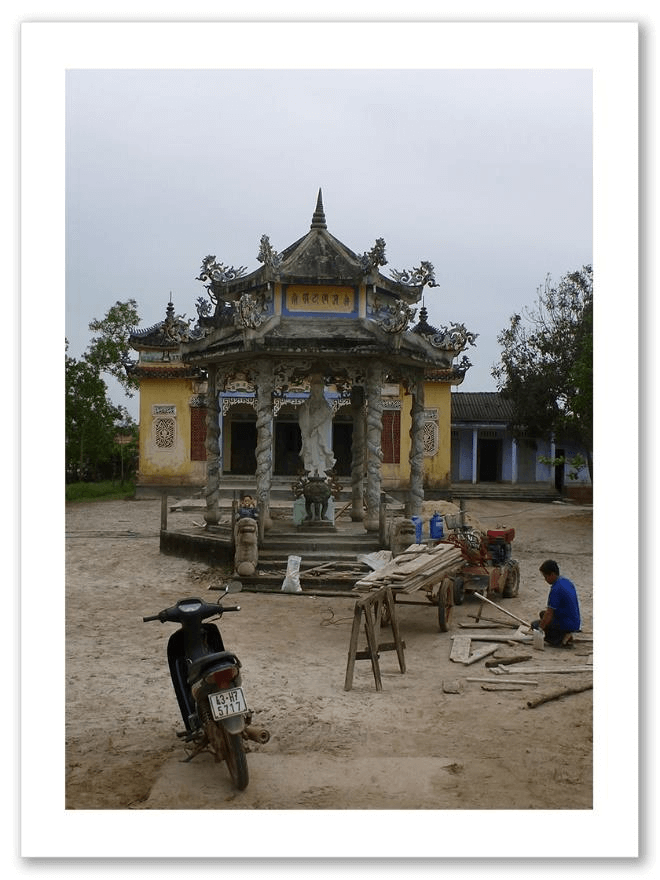
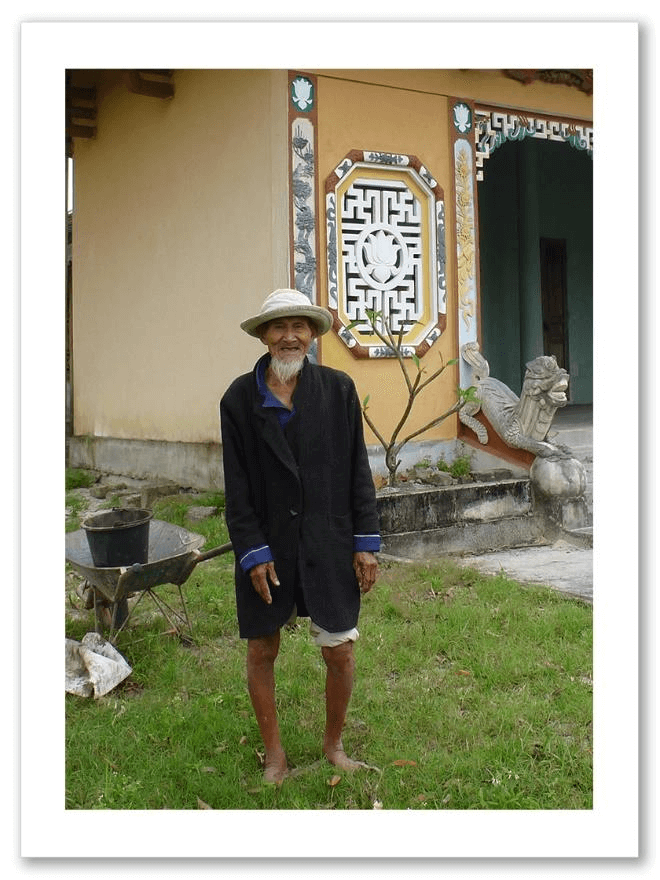
their families. The field problems keep changing but as we approach the place
the trap was to shut, the ground turns marshy and I understand where things
went wrong.
A Step Back In Time
Page 43
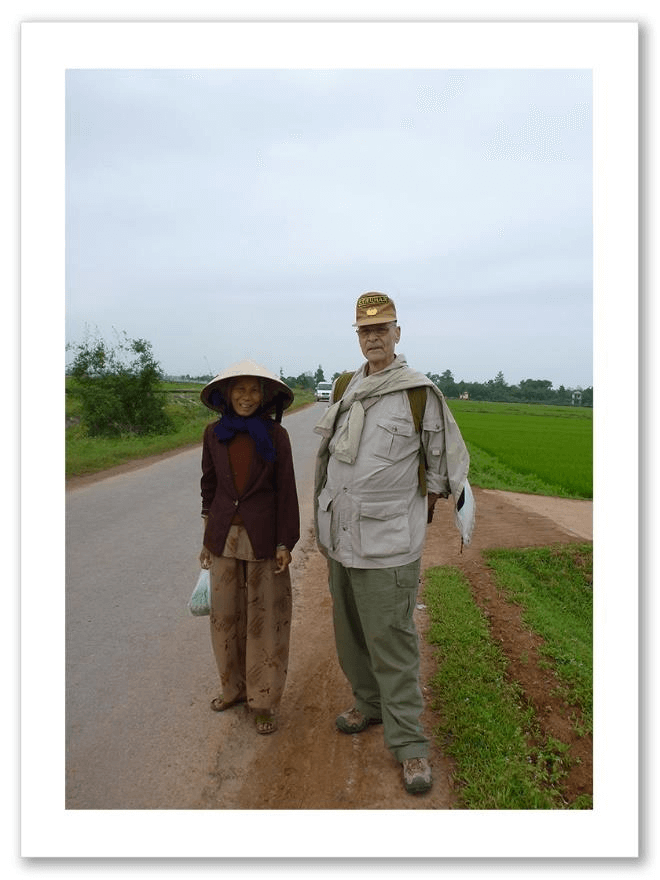 At our next checkpoint our driver
At our next checkpoint our driver
is again asleep, and we again become the
object of attention. Some women have an
aura of elegance about them—I call it the
Elvira Madigan syndrome. We were to
meet such a woman at this checkpoint.
She approached us and queried what the
big man from the East was doing walking
in this area. Chris explained.
The woman appeared to be in her
middle seventies and indicated she had
three sons, two killed in the war, and
another son who had fled to the United
States and was doing well. She indicated
that in 1975 the North Vietnamese had
come down and taken everything, even
peoples’ homes. At this moment a some-
what younger male, dressed in loose black except for a white T-shirt, came over
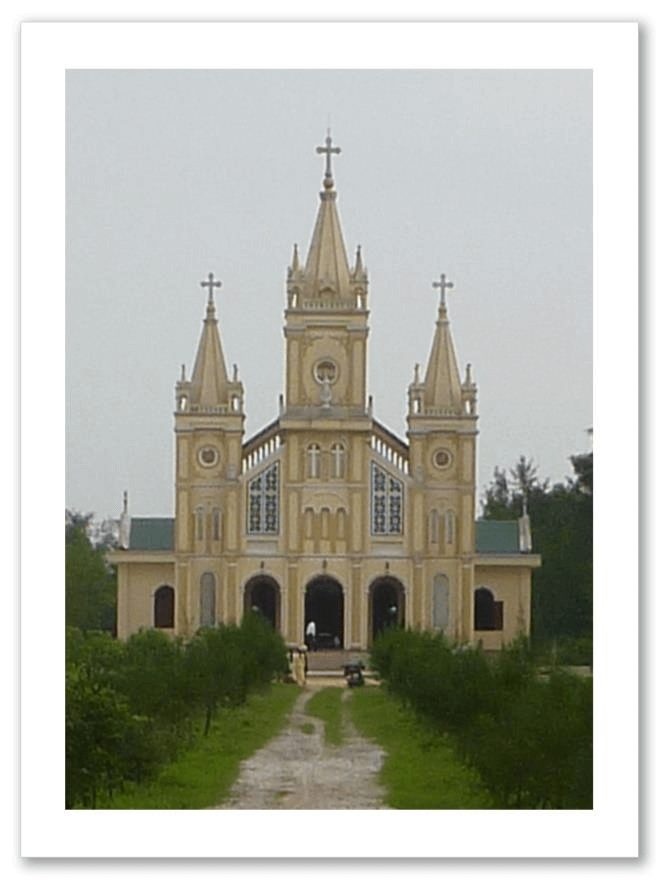 and I told Chris to switch the conver-
and I told Chris to switch the conver-
sation to the weather.
Cheeky Chris asked if I wanted
to ask him where he had fought in the
South as maybe we had been shooting
at each other. My reply was for Chris to
go home and ask her husband what he
had taken when he arrived—Mexican
standoff. But candidly, I think she got
the better of me. We made good time
and continued to meet friendly people
and come across interesting and incon-
gruous buildings such as a lavish Cath-
olic church in the middle of nowhere.
We found the driver asleep, woke him
up and I ordered him to take Chris to
her hometown of Dong Ha where we
could have an early supper and discuss my walkabout—best move I ever made.
Page 44
A Step Back In Time
In the next hour and a half Chris revised the trip, cutting out the walk from
Cau Viet to Dong Ha, doing it instead by local van, and cutting out the walk from
Lang Vei to Lao Bao so as to spend more time at a more leisurely pace on the
trail. Chris indicated I must carry a stick “to keep the animals away.” Since it
was Sunday we couldn’t buy one, but I should attend to it as soon as possible. My
instructions for food, beef or chicken soup, and my pleas for shelter were written
out. She would never know what a lifesaver these two small pieces of paper
would be.
As we parted Chris advised that tomorrow she was escorting a group of
rich Americans to Khe Sanh. I told her I would be on Route 9 and she might pass
me. Chris replied that she would languidly put her hand out the window and ac-
knowledge me, but just barely, as I was the big man from the East who, because
I couldn’t buy her a Honda Dream, made her the butt of a never-ending stream
of insults as we walked along “The Street Without Joy”. I rarely laugh, but this
brought me to my knees. Sadly, we did not cross paths the next day, as I would
have paid big money to see that put-down. Comrade Chris left, but not out of my
life—her laissez-passer was the most important document of the trip.
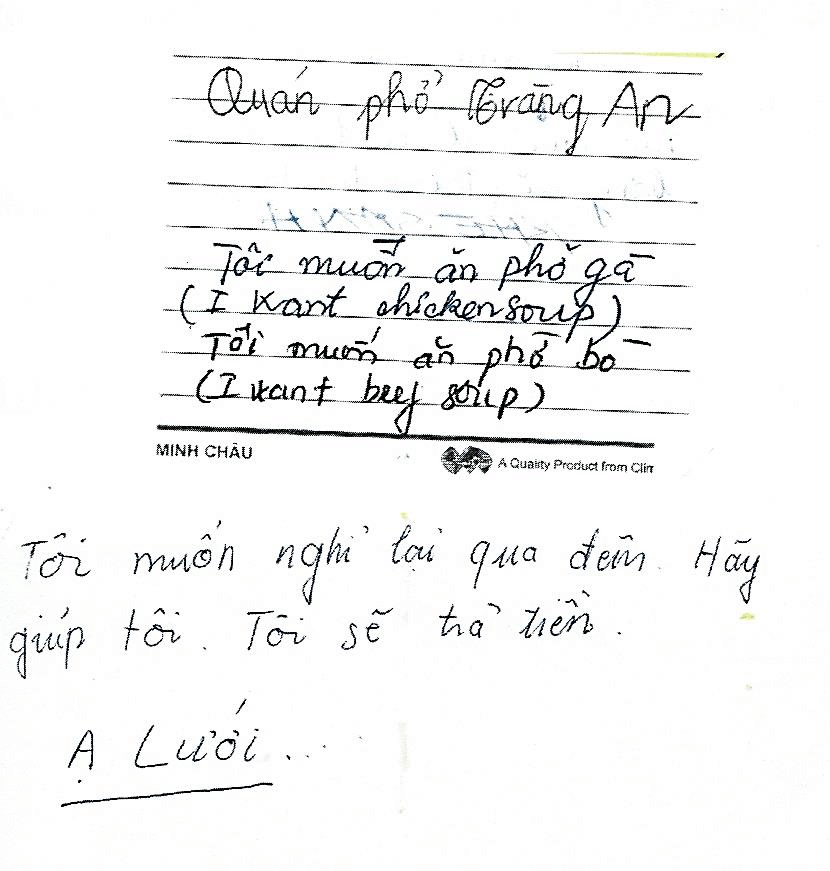
A Step Back In Time
Page 45
Why Routes 9, 14, and 49
The walk was originally to start at Cau Viet and then proceed down Route 9
to Dong Ha. Comrade Chris suggested the walk start at Cau Viet along the beach,
then drive directly to Dong Ha as there wasn’t much to see from Cau Viet to Dong
Ha. Additionally she suggested that I ride to Lao Bao from Lang Vei, to give some
additional time should anything go wrong on the trail. Made sense to me, and
that was the route I would take the next day.
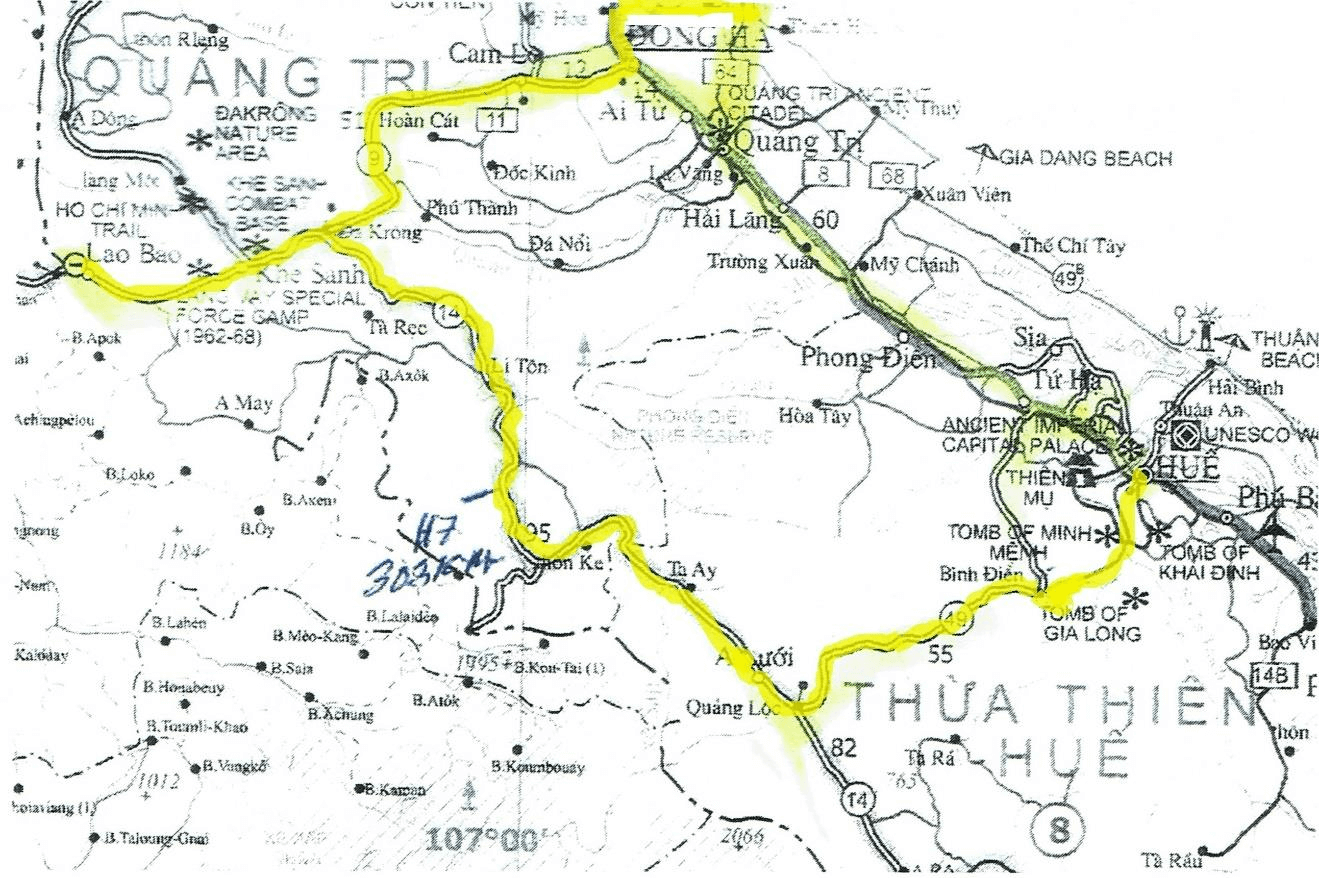
Page 46
A Step Back In Time
AS SEEN FROM “THE STREET WITHOUT JOY” • MARCH 2012

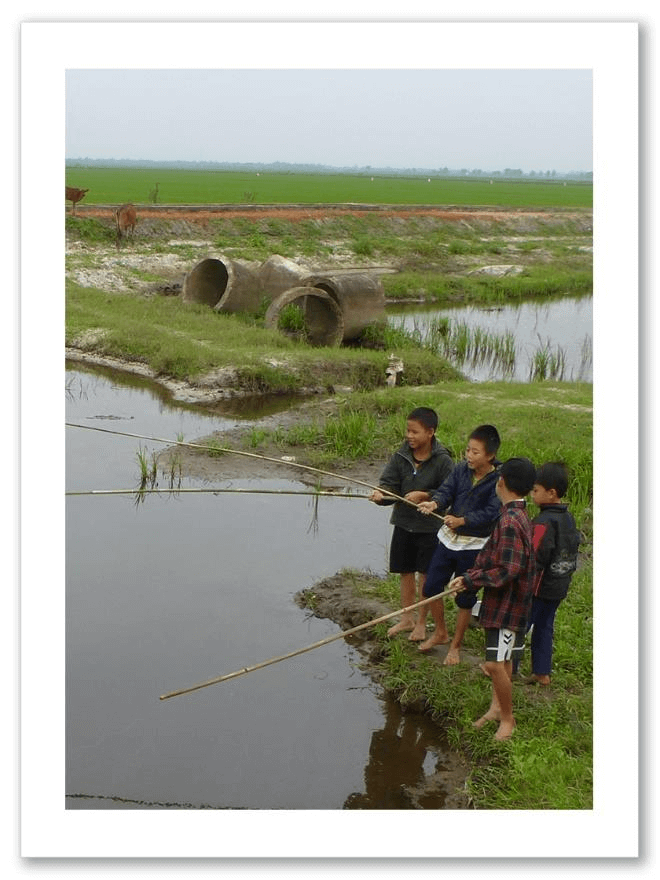
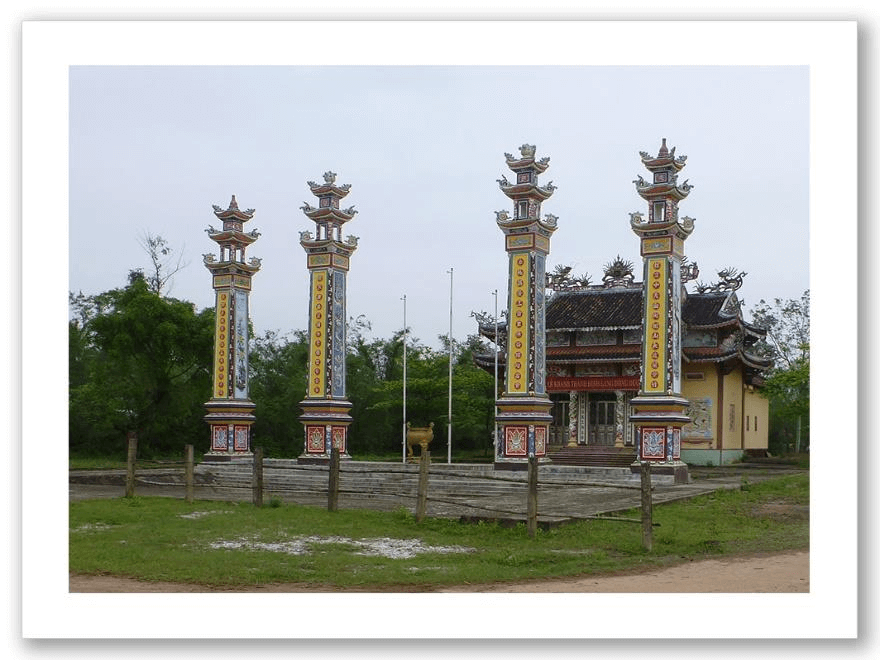
A Step Back In Time
Page 47
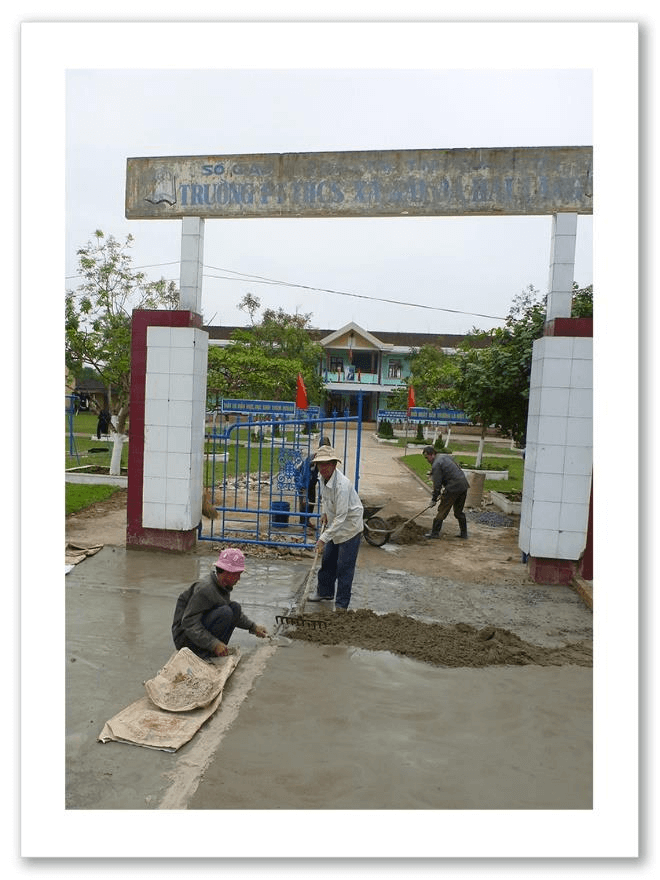
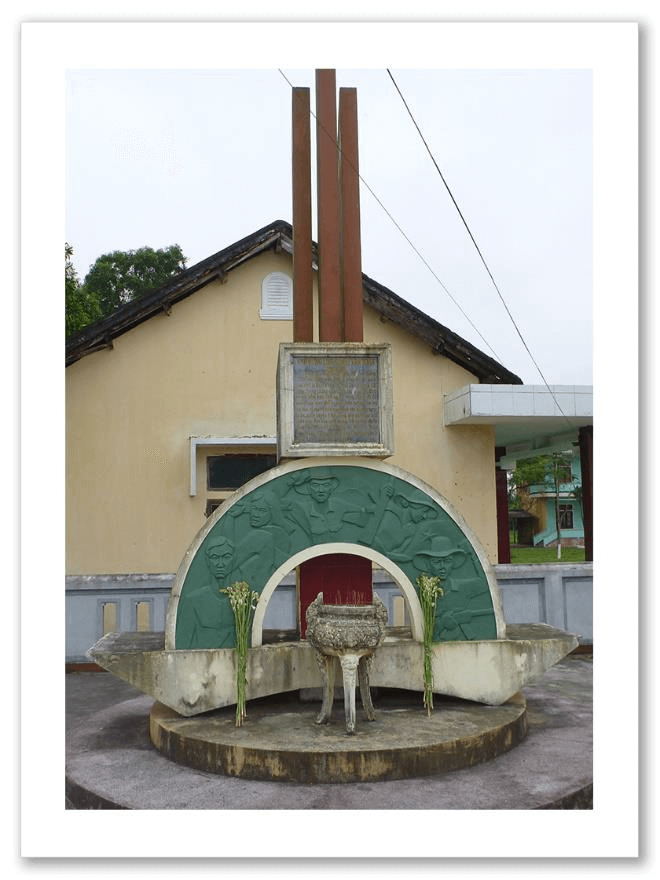

Page 48
A Step Back In Time
VIETNAMESE ARCHES • FORTIFIED VILLAGES • THE TREE LINES
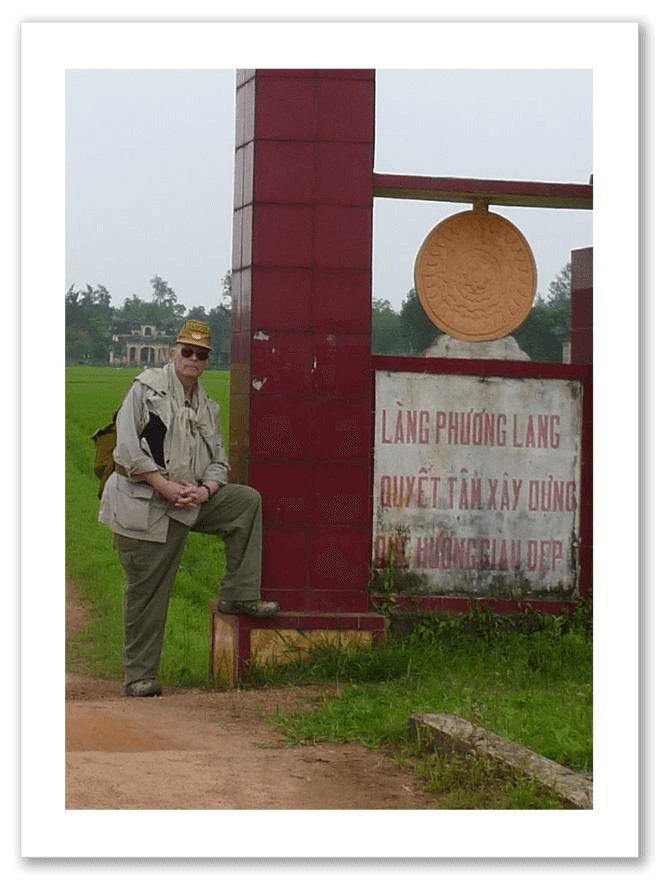
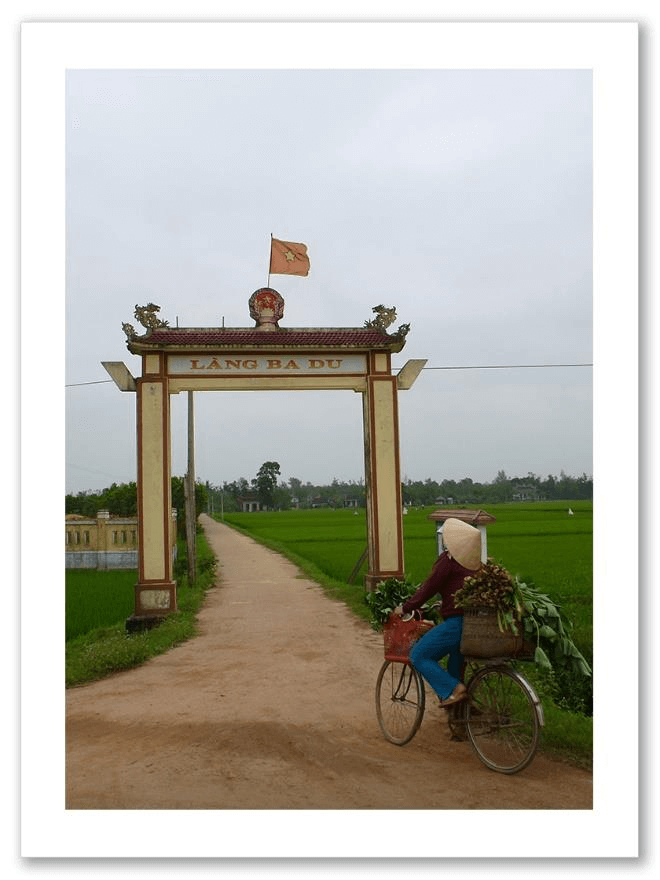
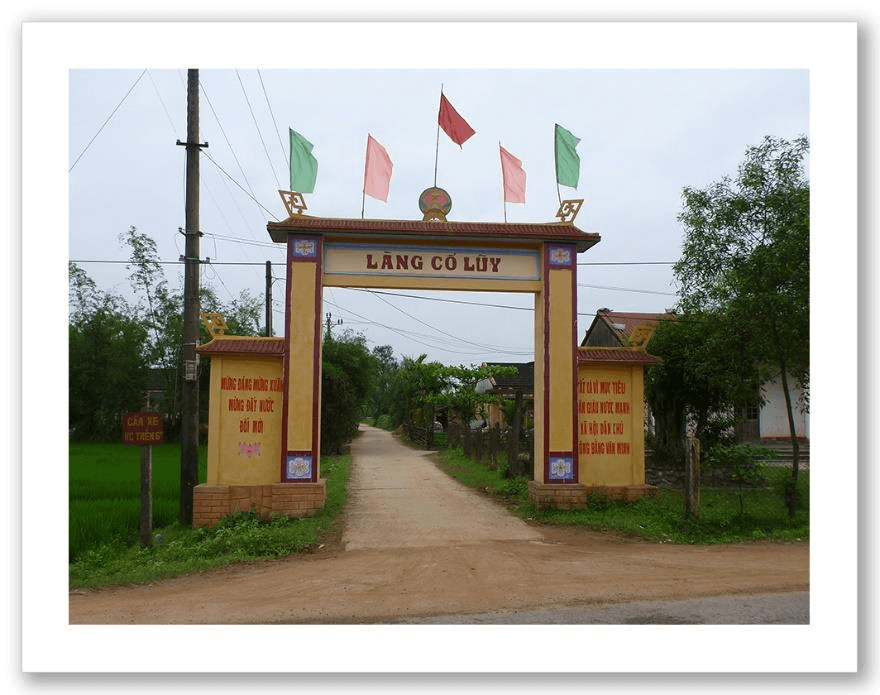
A Step Back In Time
Page 49
The Cam Lo Chamber of Commerce Welcomes You
Cool, overcast
Couldn’t sleep and an 0 dark thirty start by car to Cau Viet—pitch black
outside of town, but I knew from the beginning there would be no sun as the front
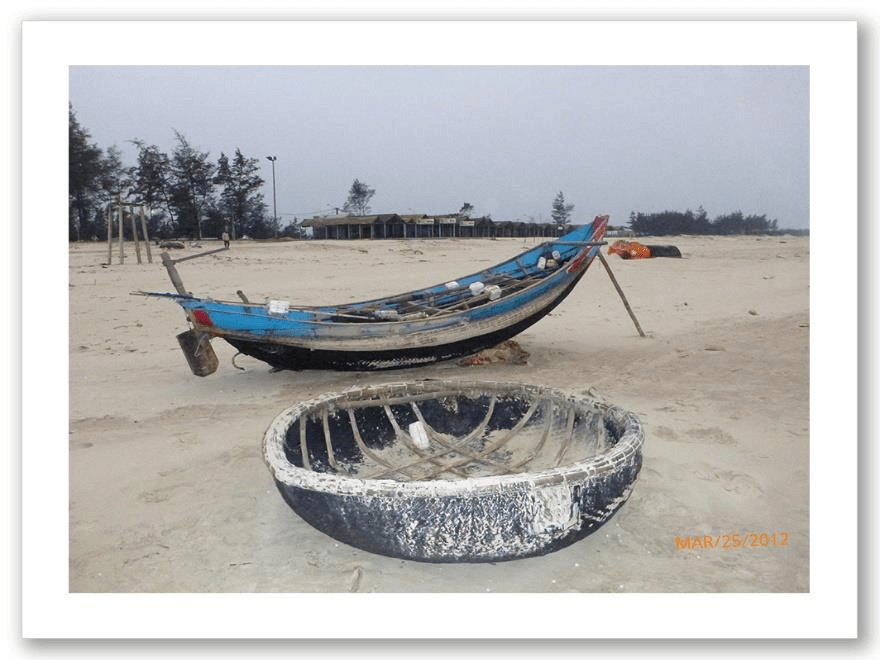 had stalled.
had stalled.
Cau Viet had been
the initial entry point for the
logistics which supported
most of the Central Highland
operations and Khe Sanh.
Did not get into the town but
headed for the sandy beach
which stretched for miles. I
walked about five kilometers
on the beach. The ocean was
calm, tide going out, and the
beach was dotted with tra-
ditional craft and circular skulls, tubs almost, that fishermen generally use solo.
Not terribly early, but for some reason no fishing was going on. I spied the car
parked about a kilometer away. I walked off the beach and as I did I happened to
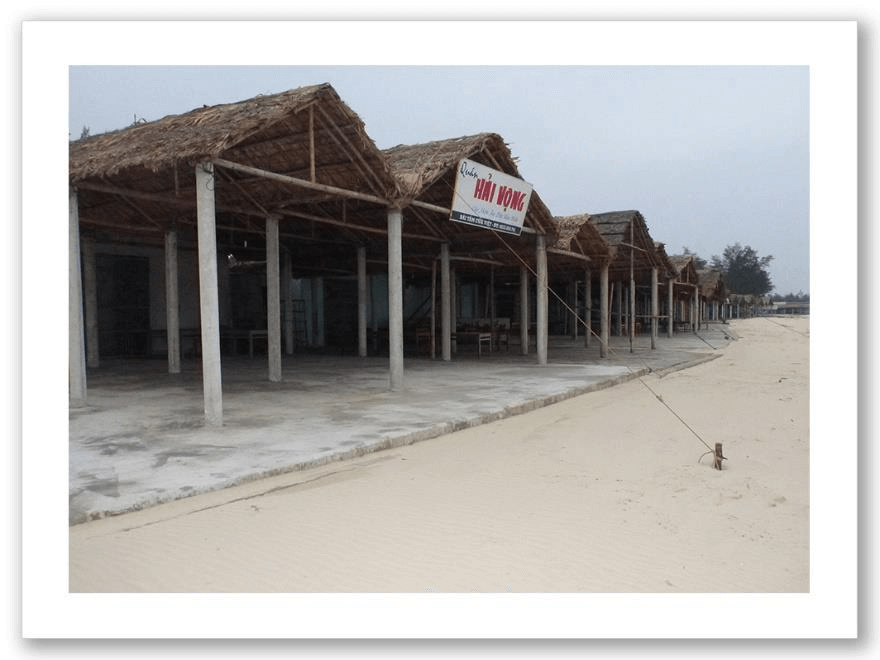 look down and see an almost
look down and see an almost
five foot bamboo walking
stick—just lying there by
itself, nothing around it. I
picked it up and knew that
I held the sweetest weapon,
other than a gun, I’d had in
my hands in the last sixty
years—it almost sang to me.
Scoped out the dunes
and walked a bit inland to
where the ground was more
marshy than sandy. You
could see where the heavy stuff might get bogged down. In the summer it must
be a hopping place with restaurant sheds stretching for miles—hard to tell them
apart. I continued my walk up to Route 9 and the car.
Page 50
A Step Back In Time
The road to Route 9 parallels the beach; little traffic, most pleasant. The
driver spoke broken English and said since we were so close he would drive me
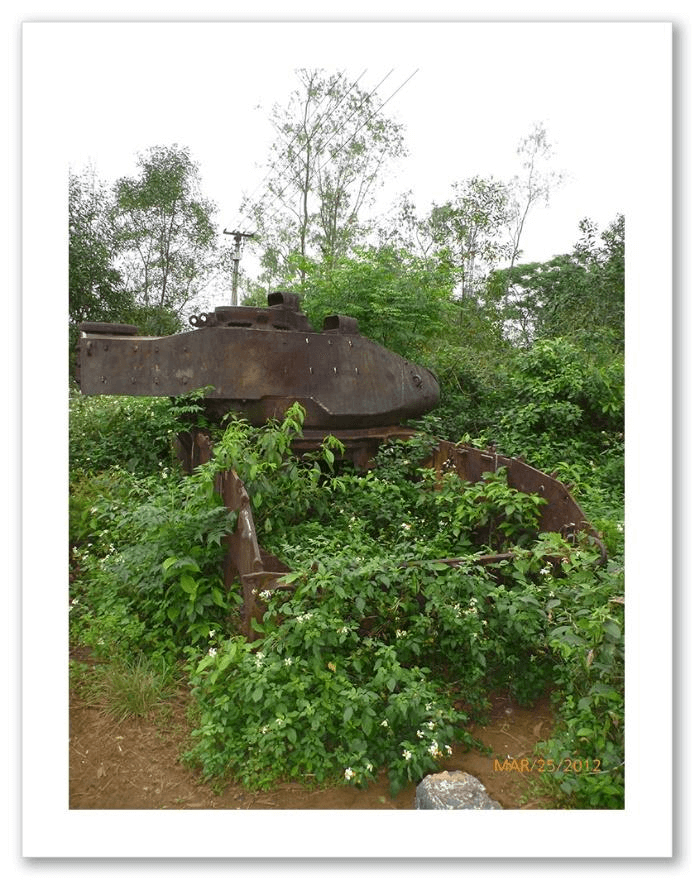 to a relic of the McNamara line. We
to a relic of the McNamara line. We
had to run across a busy four lane high-
way and scramble up a hill, but the only
hardware left of the two billion dollar
line is a vine-covered armored earth
mover. So much for electric fences to
keep the barbarians out.
The driver knew what I was about
to embark upon, and he offered to find
me a Khe Sanh bus. I bought him a
Coke, and we sat on a curb just before
the bridge in Dong Ha. As he left, he
beeped his horn. I would have an easy
start: I didn’t need to come out of the
gate running, Cam Lo was but a short
way (12 klicks), and I would stay the
night there before climbing into the
Highlands.
I set out down the two lane asphalt road, small businesses of every type on
both sides. Lots of truck traffic going both ways. Vietnamese truckers, especial-
ly the tandem rigs, have made overweight into an art form. The last four wheels
on those rigs are already half way to hell. I walked in the road and got into a
rhythm. All the small shops had mynah birds and a slew of other species, and as
you passed they commenced singing—a bird symphony! The mynah birds have a
haunting call and I was serenaded almost every step of the way.
Pack too heavy, but I was doing well until about a klick outside Cam Lo. I
was still walking in the street and stupidly not paying too much attention to my
immediate surroundings. I came across a woman selling dog meat from a card
table. I noted two other men behind her and I continued to walk past when a man
dressed all in baggy black, about 150 pounds, put his right hand on my shoulder,
and I noted a four or five inch blade in his left hand. Stupid, stupid, stupid to let
him get that close—I didn’t like his eyes. No way to run or get the pack between
me and him, but I did have the club between us. I had to neutralize his right hand
so I could get a shot to drive his left side ribs into his lungs—I needed about three
A Step Back In Time
Page 51
more feet and then I could move on to the other three. They could surround you,
but if you carried on you could use head shots on the others, then coming back,
and with due deliberation, have a full and frank discussion with the downed guy.
If I could get just a little space, his left rib cage had a bullseye on it, nothing to
stop the blow because I had the arc on him. I needed a foot or eighteen inches.
Several things went through my mind. First, my father always taught
me if you strike, strike to kill. Second, I felt sixty-two years of the yoke of civil-
ization slip off my back like a beautiful Jim Thompson silk shirt. Next, as any
kendo master will tell you, plan four or five moves ahead; I wanted to down all
four of them, and in my mind it was doable. Lastly, as anyone who has served in
Cambodia will tell you, boy soldiers, or indeed most Cambodian soldiers, with lead
flying so thick you can walk on it, say they can see death flitting on the battle-
field; (Robin Koch in his book Highway to a War makes specific note of it.) Stand-
ing off to the right, I saw Micheline Anne in her school uniform, and now it was
payback time.
I never hesitated. I smashed the club down, crossbody smash from about
eighteen inches. He fell back, and in doing so his left side opened up. My left foot
was centered on him, my right angled, and he had dropped the knife when I hit
him. I didn’t take the shot—old, slow—stupid, no explanation; I wanted all four of
them and I wanted to turn the place into a real abattoir.
I know that when I meet my father at the gates of hell I will have to explain
my failure to him, and that when I had a chance to live up to Micheline Anne’s be-
lief in me I failed again. She will forgive, he will not. A professional has told me I
chose life. That is rubbish, pure and simple. I stupidly did not take the shot. No
one moved. I stood with that club about three feet from my attacker. He waved
me on. “Funning” had paid big dividends and I owe those Harlem YMCA guys a
dinner. I was not souped up, in fact I wasn’t twitching, but I wondered if this was
the start of a gauntlet. From that point on in the trip, I became a disciple of Yao
We Nyuan, an apologist for the Tiananmen Square massacre, who opined that in
“struggles” to come violence does the trick. I reminded myself to ask Santa Claus
to give me a sirupate kukuri, twelve inches please, for Christmas—just the trick
for encounters of this type. I figured things might get interesting.
I am not spiritual, but whoever or whatever put that club in my hand
saved my life—some powerful kami was in my corner on this one. Incredibly,
as I moved into town I was offered rides by two cyclists who indicated they were
going to Khe Sanh. I politely declined. I could visualize the headlines: “Crazed
Page 52
A Step Back In Time
Geriatric Vet Kills Four Free Enterprise Roadside Butchers in Cam Lo.” I could
think of a lot worse ways to go out.
Because of geography I had to stay in Cam Lo that night but Comrade
Chris’s guesthouse selection was in the part of town where we had just taxed the
outer limits of the “People to People” program. I sat down at a small drink store,
and immediately became the object of interest to school children who had mas-
tered “hello.” I remained there for an hour or so until an impeccably dressed
Vietnamese, in unaccented English, asked what I was doing. I decided to raise
the stakes by telling him I was walking to Lang Vei—screw him. He did not pry,
but said it was unusual and he had never heard of anyone doing it. I was, per-
haps unfairly, getting into it, and added that I was interested in “native textiles.”
Always a good one, and then I told him of my little misunderstanding with one of
his countrymen and asked whether I would be running a gauntlet all the way to
Lang Vei and down “The Trail.” This got his attention and he apologized for his
countryman, saying that amphetamine abuse was rampant among the lower
classes in Cam Lo and Dong Ha. He said that contrary to today’s experience I
would be of great interest to locals on the trail as no one ever walks down there.
He spent a couple of hours with me discussing the trail and walked with
me to a guesthouse. He advised the manager that I wanted to have an early
departure, and if anything required assistance they were to call him. I watched
the two wheels in hell traffic for a while and went to bed. Not the ordinary start
for a trip. Note to Comrade Chris: Cam Lo is unfriendly—skip it!
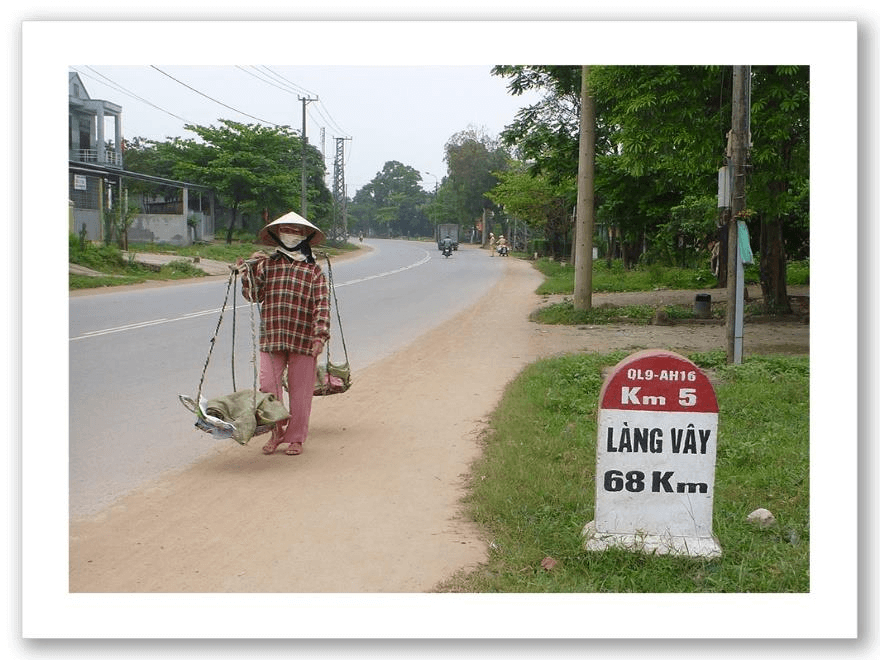
A Step Back In Time
Page 53
There is No Elevator to the Highlands
Cool, overcast
The stretch from Cam Lo to Da Krong town was 51 kilometers and a climb
of more than a thousand feet. This was the road that the relief columns had to
travel to relieve the more than sixty day siege at Khe Sanh. Zero dark thirty
start and I immediately began to climb. As a field problem the assault on this
stretch would have come from the South; the northern side of the road dropped
off precipitously.
Began to see stilt houses, then a small mountain about 1000 feet high
that had been cut in half and fed into a spanking new gravel pit. Here you could
control the road with tubes, even recoilless rifles. To break the monotony of the
climb, I devised a contest: I would race the tandem trucks! I started this about
15 klicks out, and, as the drivers struggled with their half-in-hell loads, I would
race them as far as I could go, then rest. Before long they got into it; honks and
waves from many truckers.
The road was busy with every variety of truck known to man. On my
side the trucks were struggling, but in the downhill lane the drivers were redball-
ing. I thought it likely that the redballers had not seen an AAMCO service shop
recently, if ever, and I had visions of their brakes letting go and a spectacular
launch into the valley. About twenty kilometers out it became clear you could
be attacked from both sides of the road, and a good tubeman could make your life
miserable; ambush points were everywhere. If you were to move forward at this
point, you had to secure both sides of the road. Put simply, you were in the open
and you were going up—ugly sledding.
I could see I was starting to move up. Although stilt houses were becoming
more common and no one was in tribal clothing, the ubiquitous cell phones were
in use everywhere. Another common phenomenon: clear cutting and slash and
burn agriculture. Large tracts on both the north and south sides of the road were
barren, and large scale erosion was rampant. Little to see except an ascending
highway, but I am offered rides on two occasions. When I politely refuse, the
motorcycle drivers appear puzzled. The truckers going east continued redballing
with a flair, tempting the fates to send them to the gates of heaven, or rocket them
straight to hell.
About twenty klicks out I could look down to the North and see I was mak-
ing progress. As I passed by houses, people would stare and then get on their cell
phones. I kept on racing the tandem trucks. About 30 klicks into the climb, I
Page 54
A Step Back In Time
thought it best to try the local transport. It turned out to be great fun, hilarious,
and a lesson in the strength of the combustion engine.
I was on a not so steep incline when a blue van of unknown vintage, chassis
so out of whack that it tilted, and overloaded beyond belief both on the roof and, I
subsequently learned, inside, came up slowly, clearly in first gear. Here is where
the fun began. I waved the van down, and it was going so slowly I could keep up
with it. Out jumped an aging female fury, incredibly strong, who threw me into
the aisle between the driver and the seats. We never stopped, and I must have
looked like the Golden Fleece to them—a roundeye paying client.
To make room, the fury shoved an older woman further back into the van,
which was already chock-a-block full of people (I counted six). When granny hit
the back I was unceremoniously deposited on a fishmeal sack. I told them I was
going to Da Krong town, and we carried on for the remaining 20 kilometers. As
the van continued the ascent, the military issues increased from every angle.
With hills all around and a river parallel to the road, tubes on all sides (never
mind mines) must have made progress very difficult.
Then the driver’s helper noticed my ring—Navajo hummingbird pattern—
and the fun began. He asked if he could see it and he showed it to everyone—
much close examination. At this point the driver’s helper made an airplane ges-
ture with his hand, and whistled the bomb down. Deciding discretion was the
better part of valor, I shook my head no. Not content, he held his arm like a ma-
chine gun and made chattering machine gun noises—much laughter all around.
Even knowing that they understood not a word of what I was saying, I stuck to
the “native textiles” story—it was as good as any—and if they had taken a poll I
believe the machine gun would have carried the day. I marveled at the van’s
engine because we were so overloaded we should have been smack on the high-
way to hell. I just didn’t see how the cab could stay on the chassis. I was asked
where I had come from and where I was going, and everyone wanted to feel my
legs, I guess to find out if they were strong enough to get me through. The pas-
sengers knelt in line to see if I passed the test.
It was getting dark as we pulled into Da Krong town, if you can call it that,
and we stopped on the only level piece of ground for miles. The driver asked for
two dollars and I gave him three. I watched the van slowly pull away, the cab
tilting almost fifteen degrees to the right, as it crabbed its way up the hill to
Khe Sanh.
A Step Back In Time
Page 55
I took stock, and the military problems on the south side of the river were
more than grim, with high hills everywhere, and the hills to the North towered
over the village—not an easy nut to crack! As I continued to watch the van strug-
gle up the hill, I saw another come upside it and into the lane where redballers
would be barreling down. I couldn’t bear to look.
Chris had written out, in Vietnamese, the name of a guesthouse in Da
Krong town, and I had a clean room for $6.00. The proprietor spoke some Eng-
lish and asked what I was doing and, when I told him I was going down the trail,
he said I must see the bridge immediately. In no time I was on the back of his
bike, and we drove the seven klicks to Da Krong Bridge. It was impressive, built
by Cubans, and as we looked at the bridge and beyond, we could see little of the
trail. The proprietor turned to me: “Don’t do it. There is nothing down there.”
Back to the hotel to prepare for the run up to Khe Sanh.
“They Just Disappeared” “We are in the Middle of Nowhere, Fighting for Nothing”
Cool, overcast
The Battle of Khe Sanh, a centerpiece of General Westmoreland’s vision
of grinding up the North Vietnamese Army in a set piece battle, has justifiably
entered into and added luster to the Marine Corps legend.
Khe Sanh was more than a nightmare for the military, the President and
the government as a whole, as the spectre of Dien Bien Phu ricocheted day and
night from the Oval Office on down. Indeed, “Whiz Kids” became “grand strate-
gists”, and the services fought among themselves as to how the battle should be
waged, if waged at all. Army and Marine commanders became gamecocks with
no quarter asked or given. It was not a “can’t we all just get along” atmosphere at
Joint Headquarters. Some suggested Westmoreland delayed relieving the siege
so he could “bomb away”, but one thing is clear—the political ramifications of the
North Vietnamese holding Khe Sanh hostage for more than seventy days, while
USAF’s “Operation Niagara” rained down ordnance and “Operation Pegasus”,
a joint Army, Marine, and South Vietnamese relief force, attempted to break
through, had not been foreseen by the Commander-in-Chief and his advisors.
As I left at first light and started the 21 kilometer climb, it was clear that
the road uphill to the base could easily be hit hard from both North and South.
Cynics say the delay in relieving the siege was deliberate. If you walk the stretch
from Da Krong town to Khe Sanh, even without being in the military, you are on
a slog which, without protecting your flank, could quickly turn into a debacle.
Page 56
A Step Back In Time
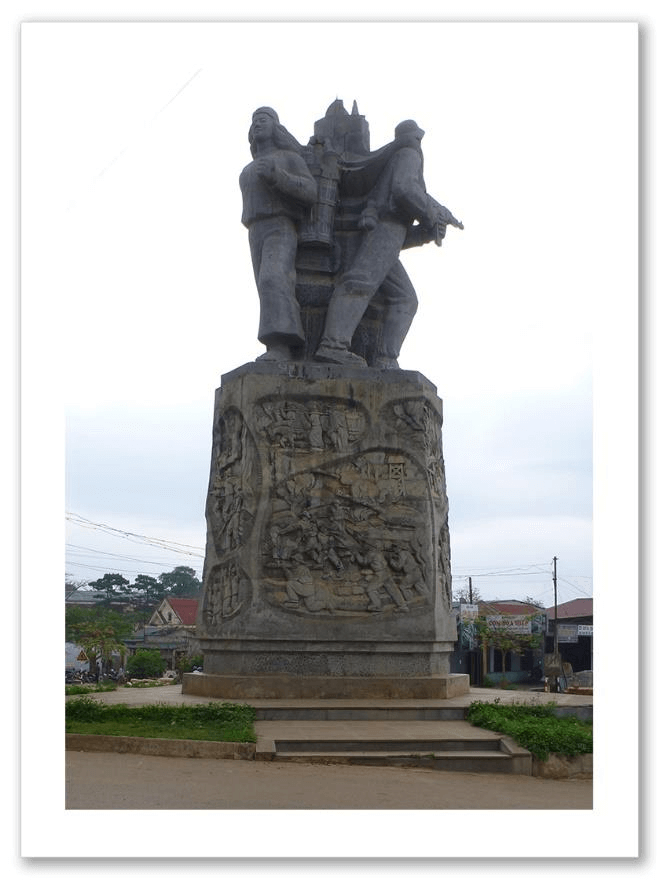 You don’t need a program to know
You don’t need a program to know
you are in Khe Sanh. I arrived in town
about 1:00am, went to the hotel recom-
mended by Comrade Chris, and the ad-
venture began. I was greeted by a young
Vietnamese woman, dressed in a red
housecoat with a red feather boa. I live
in New York, and, stylistically, nothing
floors me, but this was beyond Dada. I
told her I wanted to go to the battlefield
and we spent the next five minutes in a
dialogue of death until a French muse
opened the door. Ms. Red Feather Boa
indicated she would be my guide, but I
would need to hire a cycle driver to take
me to the site. She spoke little English,
but assured me I could rely on her to be
my interpreter—figure that one out.
We took off and soon arrived at the battlefield. I mistakenly believed you
could not walk on the Khe Sanh runway, and two Marine Corps friends had asked
me to bring back a souvenir. I was not convinced that Ms. Red Feather Boa’s
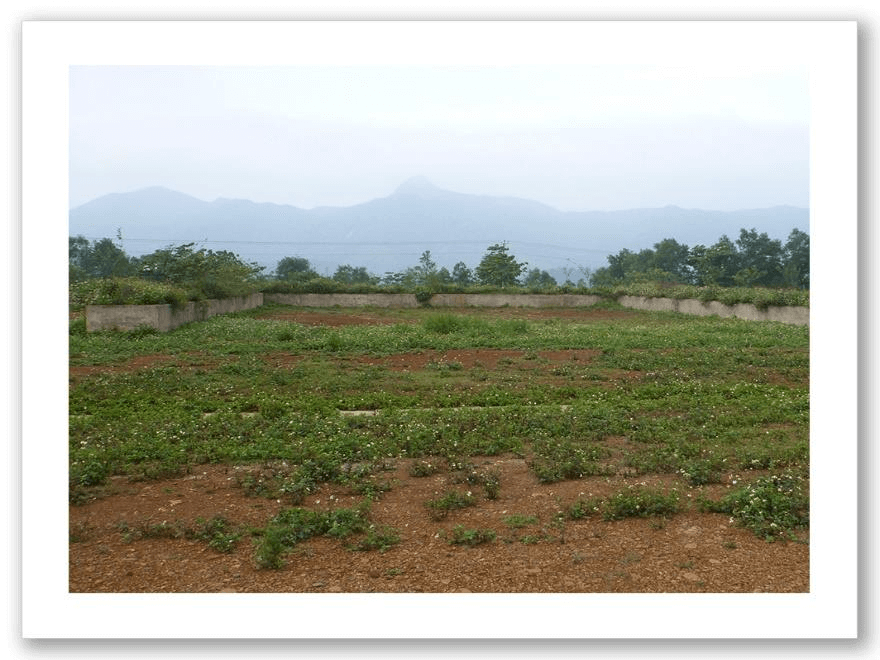 language skills were up to the
language skills were up to the
challenge, so I showed Comrade
Chris’s note to a local who pro-
duced a guide, and what a guide
he was. Sizing up the note, the
young man I will refer to as
“Christopher” asked “Where do
you want to start—northeast or
southwest?” I told him to carry
on. We started on the northeast
and looked over at Tiger Tooth
Mountain in the mist, and one
of the five helicopter revet-
ments still extant.
A Step Back In Time
Page 57
It was Children’s Day and school kids were everywhere. The runway is
half the size it was when operational, as the other half has been turned over to
agriculture. As we walked I got a blow-by-blow of the siege from the North’s
perspective. I sought to spice the stew and threw out that the Hanoi crowd had
sacrificed the Viet Cong forces in Tet so that when the North won they could take
over the best positions and jobs, since all or most of the Viet Cong cadres would
have been wiped out. Christopher candidly admitted there might be something to
that statement—I was floored—but that we failed to appreciate the psychological
impact in both North and South of the NVA holding the world’s mightiest military
machine in check for more than seventy days. Hard to argue with that!
We continued to walk the runway and, as few can, he made history come
alive—with a different perspective to be sure. Even those not of a military bent
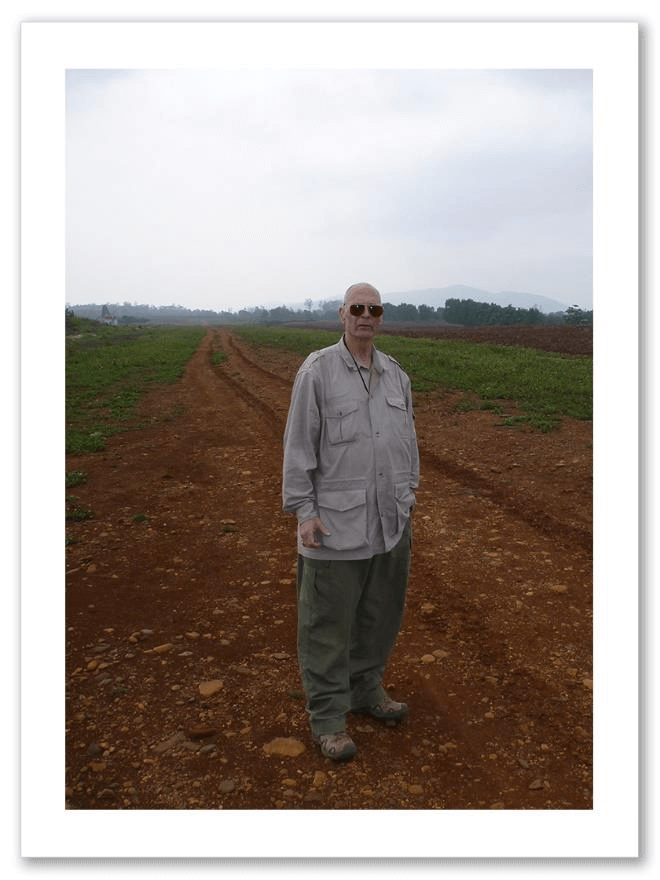 can quickly comprehend, and those who
can quickly comprehend, and those who
served there will never forget. The run-
way ground cannot forget, bearing silent
witness to a war that ended 37 years ago.
From conversations with Marines
I learned that the mountains were often
cloaked in mists which harbored evil
spirits. Marines occupied “bad ground”
here, as they did in Lebanon, and were
fighting, in the view of some high-rank-
ing Marine Corps officers, “for nothing
in nowhere”. Heavy tubes in Laos rained
down on the base making simply going
to the latrine a dance of death, and two
direct hits on the main ammunition stor-
age dumps brought the base as close to
hell as you can get without entering.
Supply of the base was by air, and both going in and coming out pilots and load-
masters shoving the stuff out the door faced a daily deadly crap shoot.
The guide was speaking to me in English and to the driver and Ms. Red
Feather Boa in Vietnamese. At this point the driver spoke, and he informed us
that his two uncles had fought in the siege, and had simply vanished—vaporized,
never to be heard from again. I stepped back and thought about that, and how
chance had put us together on the Khe Sanh runway.
Page 58
A Step Back In Time
BATTLEFIELD VIEWS • KHE SANH • MARCH 2012
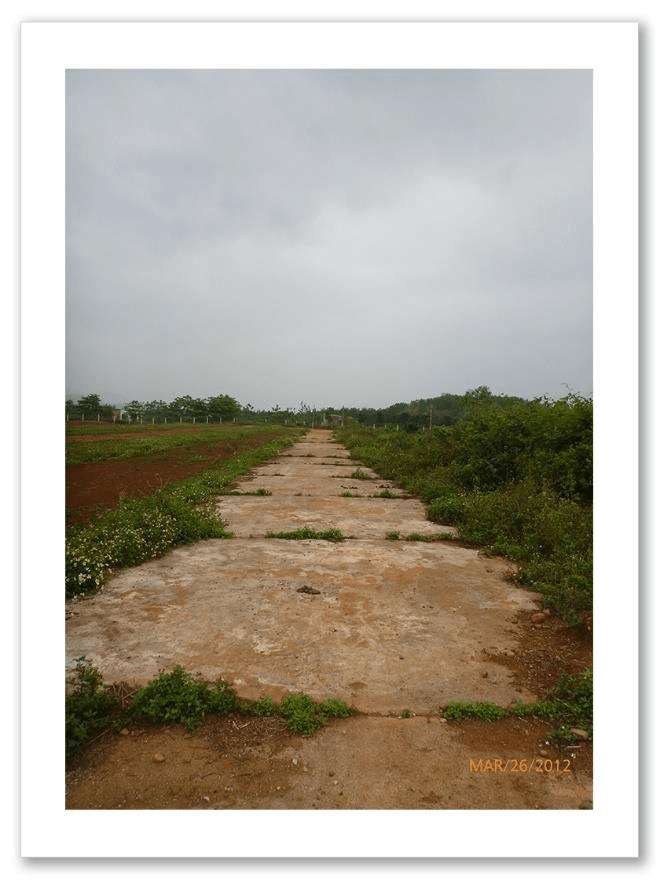
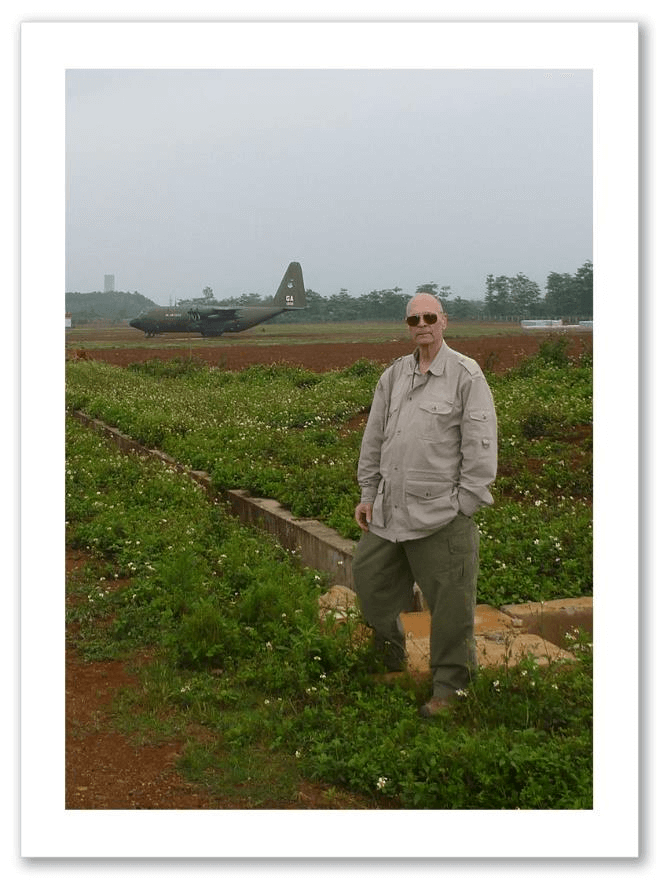
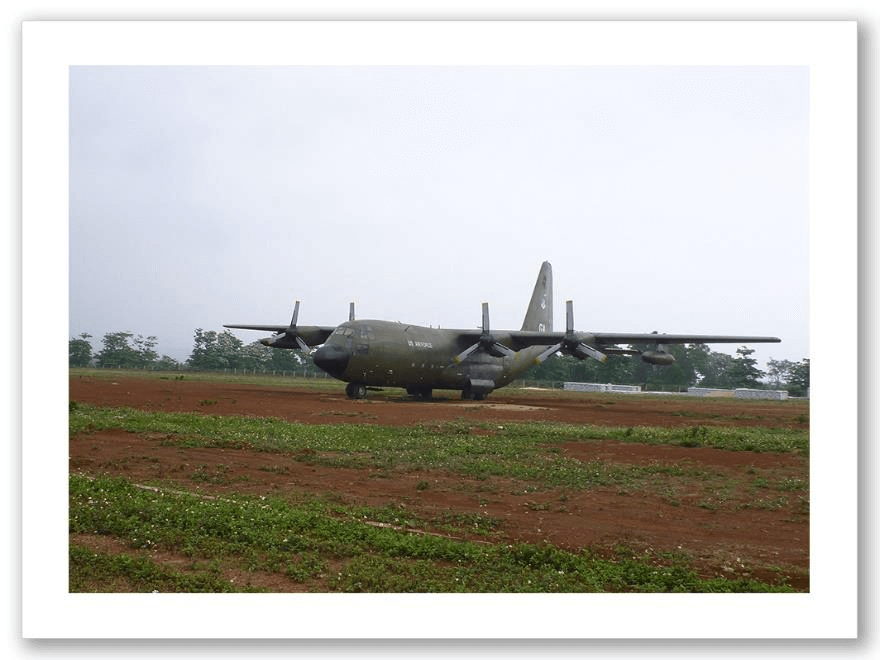
A Step Back In Time
Page 59
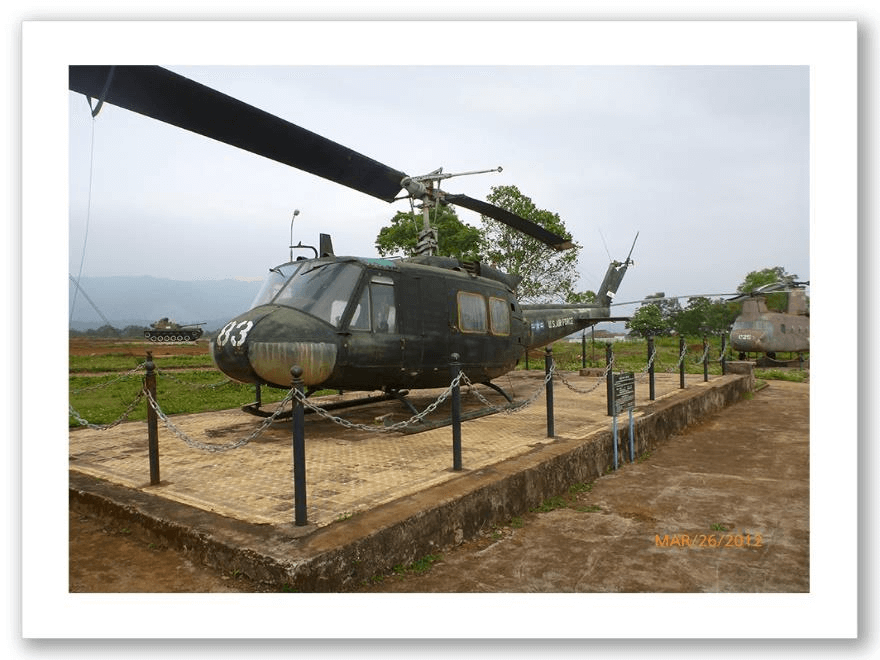
Christopher questioned me as to why I wanted to walk on the runway,
and I replied I was doing a favor for some Marine friends. He then asked if I was
going to Lang Vei, and I told him yes. He said I would be disappointed. Why was
I walking? I told him I owed it to some friends. He then asked did I owe it to
some friends to walk “The Trail”? Given that I had not told him I was going to
walk the trail, I told him that one was all on me. I did not throw out the “native
textiles” dodge. He was far too smart for that.
After the “they just vanished” disclosure, what happened next was equally
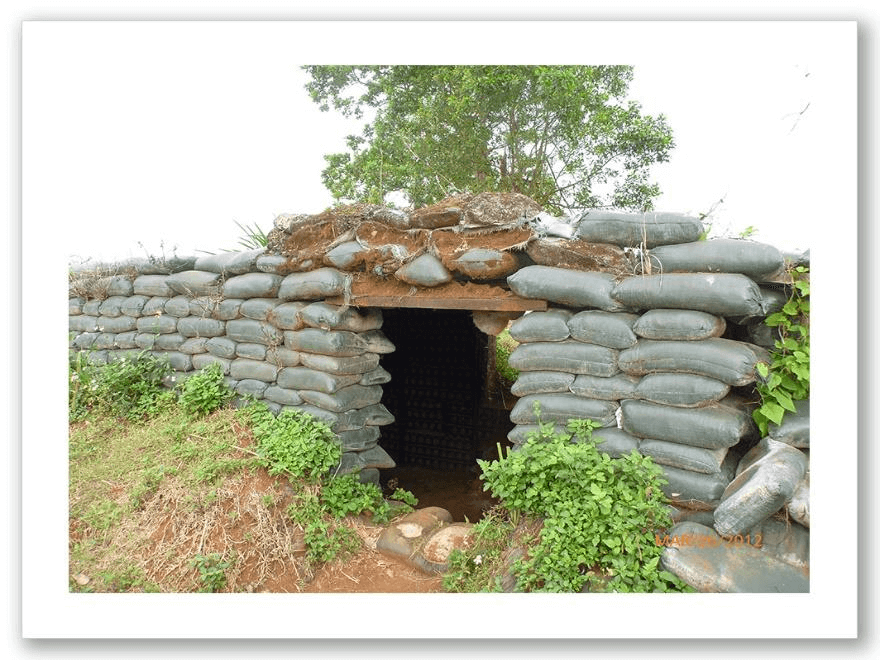 startling. Christopher indica-
startling. Christopher indica-
ted that since I was clearly in-
terested in visiting the battle-
field, and because it was Chil-
dren’s Day, the crowds today
would probably be too distract-
ing. He volunteered that if I
showed up at 6:00 the next
morning I would have the
place to myself for two hours,
as no one would arrive before
8:00 He would leave the gate
slightly ajar so I could enter.
As we passed a bunker he noted that with the passage of thirty years or
more the Vietnamese preferred United States-made sandbags to new sandbags
from China; the U.S. sandbags lasted a lot longer.
Page 60
A Step Back In Time
As we were about to leave I looked around and saw that the hills were still
wreathed in mist. As we parted, with a wry smile Christopher said I think you
 will be disappointed in Lang Vei, but if you
will be disappointed in Lang Vei, but if you
look to Laos, as I am sure you will, it will
bring back memories, probably not-so-good
memories. Many brave men died on both
sides fighting for that worthless piece of
territory. I told him if he continued to
smoke he would never see his granddaugh-
ter play games or attend her wedding. As
we were leaving, I asked Ms. Red Feather
Boa how she liked the tour. She said it was
her first time to Tacon—she was going to
be my guide?—and she gushed that she
learned a lot! Floored again!
As we returned to Khe Sanh I spied
a local dress shop which featured what the
stylish Central Highland ladies are wear-
ing. Sad, oh so sad. The triumph of MTV.
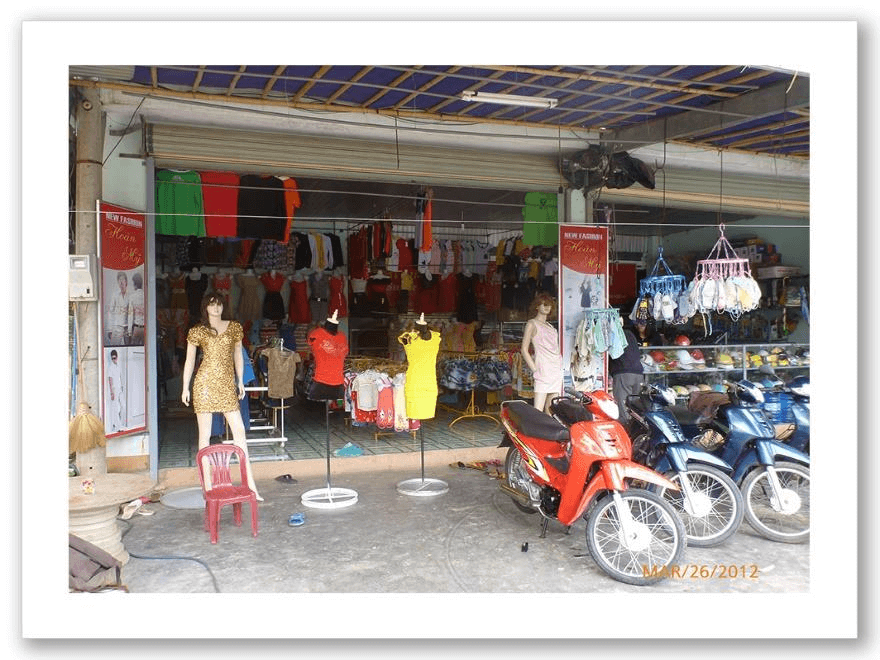
A Step Back In Time
Page 61
Comrade Chris: “The Bru All Became Christians, Now They All Have Cellphones”
Cool, overcast
Up early for a quick run to Tacon, and as promised the gate was slightly
ajar. Mist wreathing the hills, and a farmer walking his cows to pasture on the
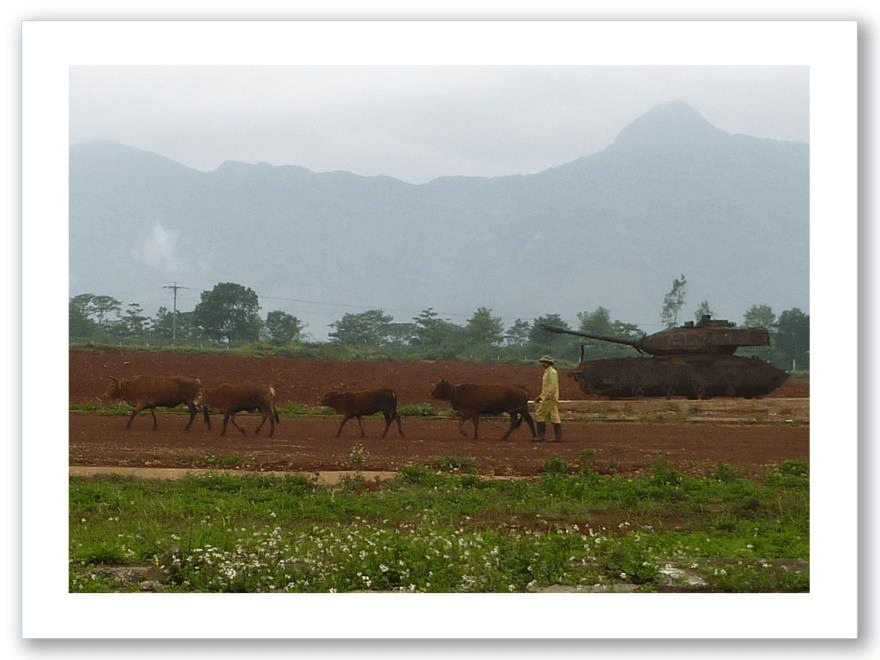 runway. We are the only per-
runway. We are the only per-
sons on the base as morning
birds start to sing. Hard to
imagine the cacophony of
battlefield sounds—fire, ex-
plosions, Willie Pete—all the
organs of war going full bore
—now silent!
I move to the runway to
pick up some dirt and a few
stones for my Marine friends,
and, as I take a rock and start
to scoop some dirt into a
medicine bottle my driver, whose two uncles had disappeared, takes another
rock and starts to help me gather up the stones and the dirt. I was bowled over.
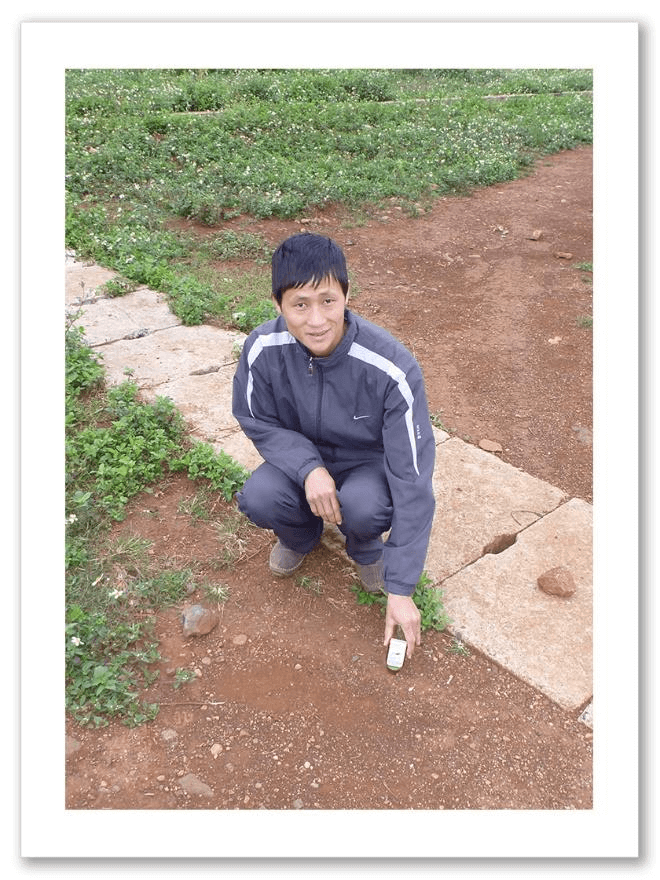 For the next hour and a half, except for
For the next hour and a half, except for
the tinkling of cow bells, we sat on the
runway looking at Tiger Tooth Moun-
tain and the mists, each with his own
thoughts. A Zen master would have been
hard put to set this up. The irony of the
two of us together on that runway in the
enveloping silence, given the loss he had
suffered and my clear allegiance, I doubt
was lost on either one of us.
About eight, Christopher arrived
and asked how we found the silence, add-
ing that he always found it evocative. He
advised me that I would have no silence
in Lang Vei as the road went straight
through the camp. Not much was left,
but I would remember the saddle into
Page 62
A Step Back In Time
Laos because we lost so many in the cross-border operations. He looked me
straight in the eye when he said it.
I told him I would be walking from Khe Sanh to Lang Vei, and he replied, I
thought so. The red mists began to stir. He asked if we would like to share some
tea with him before we left and we accepted. And then commenced the second
out of body experience of that day.
Christopher opened the conversation by asking whether I was familiar
with the Chinese “plant a seed in the other land” program. I told him I was not.
He proceeded to detail how the Chinese had launched a program offering high
prices to buy the front feet of water buffaloes. There appeared to be no rhyme
or reason for their doing so, and Vietnamese farmers sold the Chinese their
buffaloes.
Soon afterwards the Chinese offered most generous terms for tractors, and
now almost all tractors in Vietnam are Chinese tractors. This was soon followed
by the Chinese offering the Vietnamese cheap power, and, as Vietnam is power
deficient, the Vietnamese government enthusiastically entered into a deal. After
a period, and for no apparent reason, the Chinese cut off the power sites and sold
power generators to the Vietnamese. Then, after another stretch of time, the
power was mysteriously restored.
I told him the Chinese were doing what the Japanese had done earlier in
the 1960s. This was good old capitalism, securing market share—nothing wrong
with that because obviously the boys in Hanoi had approved all this, and his con-
cerns were just Vietnamese xenophobia. He laughed and said it was all well and
good for an American to say this because the tiger’s tail is not in his country, or
is it? It is better not to step on the tiger’s tail, wherever it may be. The April 7th
issue of The Economist makes a telling argument, a bit more subtly to be sure,
concerning China’s military rise—clearly, based upon this article, it is best not to
step on the tiger’s tail anywhere, any time.
Christopher suggested that when I returned to America each time I pur-
chased something I should check where it was made, to see if a tiger’s tail is
growing in America. He then wished me luck on the walk to A Loui, and he was
impressed that I would go it alone. I told him 400,000 of his countrymen had
died on that stretch of road, and I wanted to see if I could do it. He said it was a
strange thing to do in this time, but I told him I had no other motive. He smiled
and said again “alone”. He wished me well once more and said he was sorry we
were not on the same side, but the next time around perhaps we would be on the
A Step Back In Time
Page 63
right side. I thanked him again for allowing us to enjoy the silence. He smiled
and said “Walking to A Loui” and I repeated “Walking to A Loui.” At this point a
spanking new bus with approximately sixty Lao tourists arrived to enter the
compound. Christopher smiled again and said, “In those days you went to Laos,
now we bring Laos to you!” I hitched up the ruck as I knew I had 12 klicks to go
and set off—another Ambush Alley as the road for tube work was clearly visible
from both sides. The Lao mountains loomed to the West and family scenes began
to emerge.
Lang Vei, a Special Forces camp that fell in 1968, was the first base at-
tacked by North Vietnamese armor; it had been used extensively as a jumping
off point for cross-border operations into Laos. Seventeen Americans, about
three hundred ARVN troopers, and a large number of Bru tribesmen who were
used as scouts were killed. Controversy still resonates around the conduct of
the Marines in not allowing the survivors to enter the Khe Sanh perimeter.
Route 9 runs right through the base, and little of it remains, but one haunt-
ing, human image will stay with me forever. The hills to the west of Lang Vei
were often covered in mist, and this day was no different.
As I pulled into what was left of the compound area I saw a Soviet tank
memorial front and center—oh my kingdom for some armor piercing. I tried to
orient myself as to the command bunker, but despite scrambling around I was
unable to set it right in my mind.
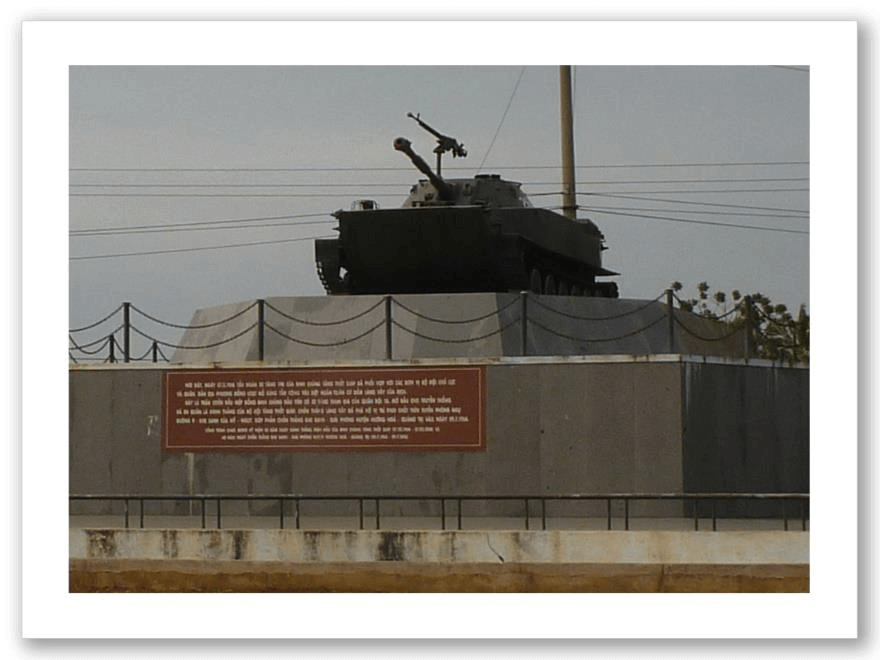
Page 64
A Step Back In Time
What I did notice was, according to my driver, a Bru woman seated on a
curb. She was facing east, and looking towards what I remember was the Bru
village, which was peopled with kids and the Bru families. I sat down beside her
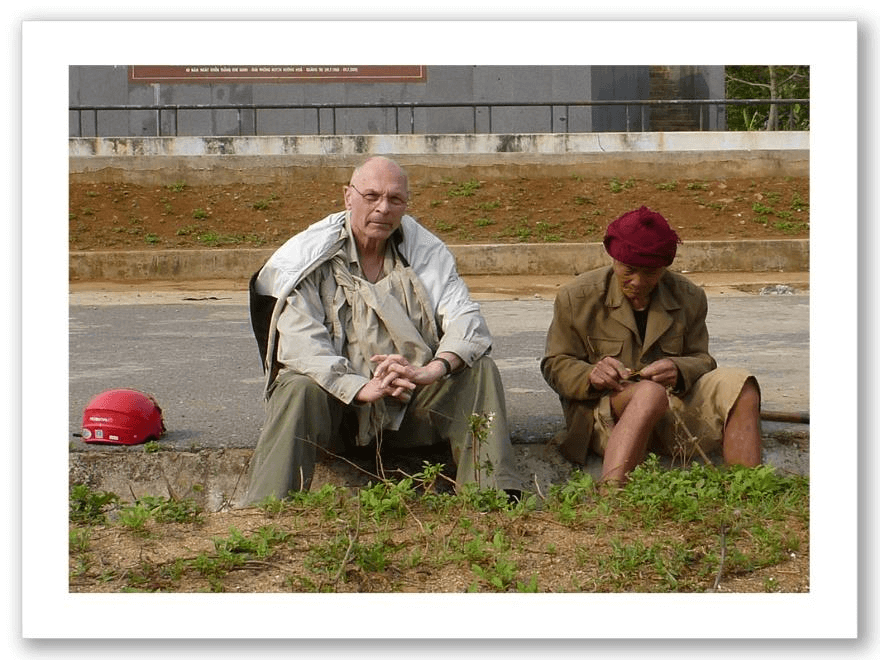 and she moved her razor sharp
and she moved her razor sharp
sickle to her other side. She
was not crying, but keening, an
almost other-worldly sound.
She had a piece of wide yellow
plastic string, and as I watched
her she appeared to be attempt-
ting to make a cross —it just
wouldn’t come out right. I sat
there for an hour listening to
her. She took no notice of me
but kept staring down the hill
toward the tree line. Then I
remembered Comrade Chris telling me the missionaries had been very active
with the Bru, and many had become Christians. She continued to try to make a
cross, continued to fail. Her eyes did not look at you, but through you, to a point
beyond you, and the chanting never stopped. She never acknowledged me and I
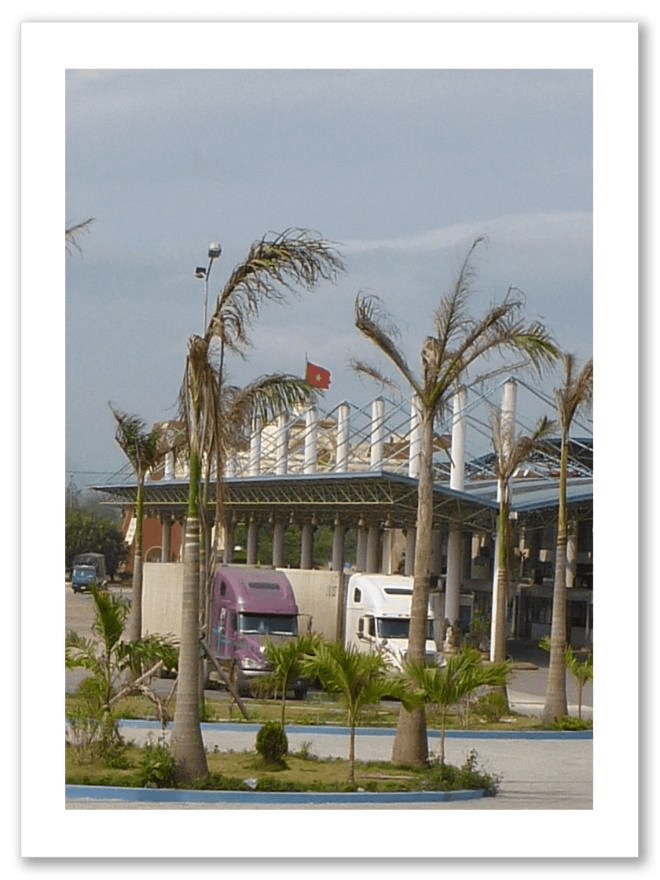 just sat with her until I had to leave.
just sat with her until I had to leave.
I told the driver to take me to a
point five klicks from Lao Bao as I wanted
to walk in. Lao Bao was, just as Comrade
Chris had said, nothing but a large border
crossing for smuggling from Laos. An
officious Vietnamese border guard would
not let me closer, but I did get a picture
with the flag. However, all was not lost,
as Chris had told me I would be able to
see the remains of the old French prison
where many “politicos” had perished dur-
ing French colonial times.
We found the prison and purchased
our tickets, but there were no guides and
the guidebook was useless. We probably
A Step Back In Time
Page 65
appeared as bewildered as we were when a dignified French tourist detached
herself from her group and took us in hand.
The Frenchwoman showed us the prison cells and described the conditions
under which the prisoners were held—barbaric. The cells were clearly nothing
more than large coffins, and no one could have stood upright in them. The heat
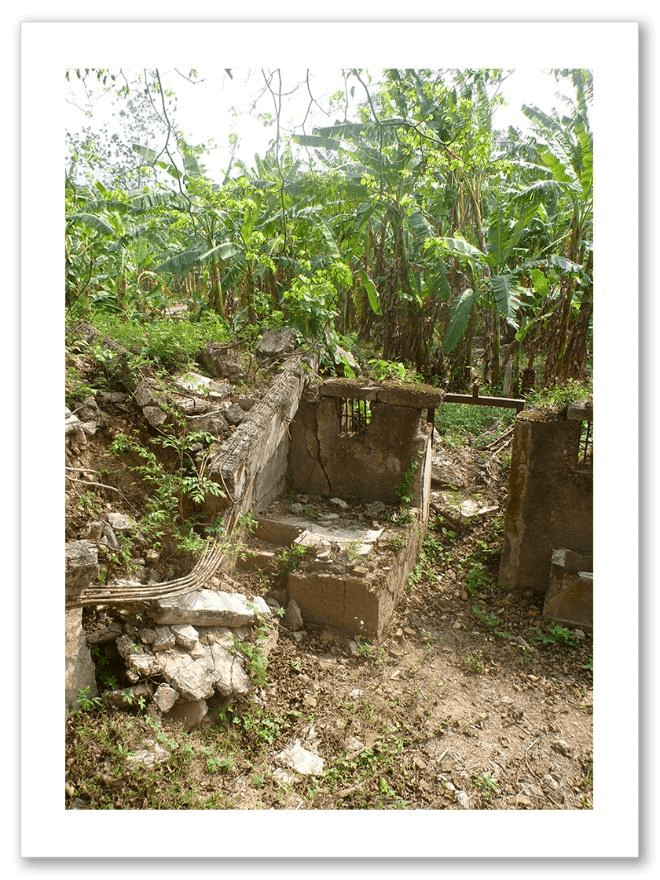
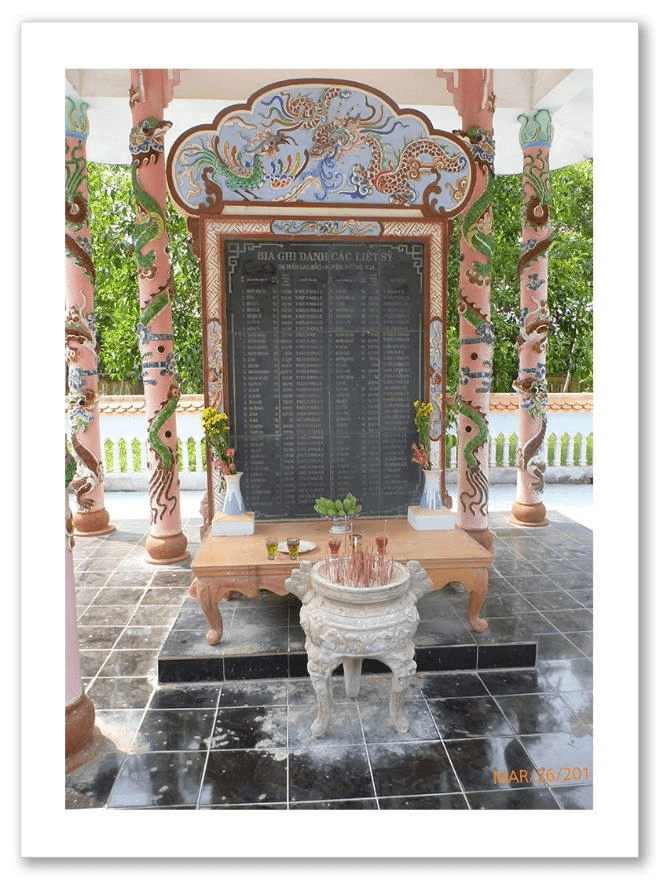
must have been close to the temperature of hell. Our guide brought us to the
memorial to the prisoners who had been guillotined, and then to the present
government’s monument to those early martyrs. She spent the better part of
three-quarters of an hour with us, and only left when her tour bus began to honk.
Another example of beyond gracious hospitality. Three in one day.
I told the driver that on our way back I wanted to return to the Lang Vei
site. I wanted to see if the Bru woman was still there—she was, and she was still
trying to make the cross from plastic string. I looked out to Laos as dusk settled,
she looked inward and continued to chant. A more than memorable moment. I
felt helpless and didn’t know what to do or how to help. I returned to the hotel
to contemplate The Trail.
Page 66
A Step Back In Time
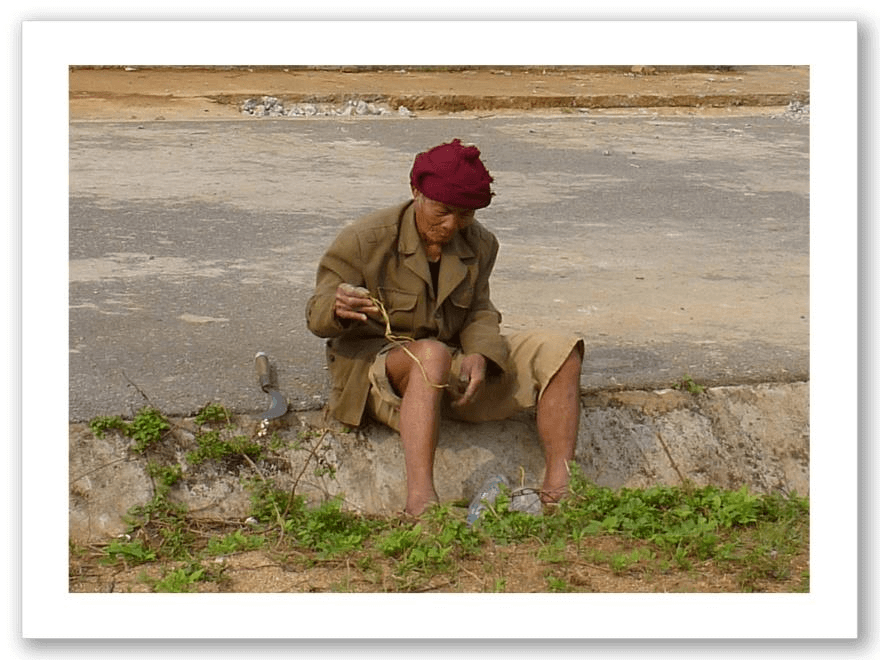
“You will be the object of attention, hospitality, offered rides all along the way”
Bamboo Boy, Lonely Planet Forum
Cool, overcast
Today starts the unknown part of the adventure and I am concerned for
several reasons. I wanted an early start so I requested a zero dark thirty call—no
need, no way I could sleep.
In preparing for a solo walking trip in an area reported to have “nothing
down there,” it is mandatory that you hit checkpoints; you are going to be asking
people permission to stay in their homes, or looking for public rest houses, and
there are long stretches between points. The checkpoints provide not only a
sense of accomplishment, but also give you a reasonable timeline to complete the
journey. In a trip like “The Trail”, strange as it may seem, maps are hard to come
by, and I am indebted to Stan Volynsky who was not only a constant source of
support, but was also able to create a virtual program which allowed us to select
villages that appeared to offer reasonable checkpoints; the hospitality part rested
on Comrade Chris’s “laissez-passer” which I was to present to Vietnamese as I
moved along. The trail program covered the Da Krong Bridge to A Loui, with
Route 49 to Hue posing its own set of problems.
I appeared in the lobby at 04:30 and was greeted by Ms. Red Feather Boa
who had slept behind the desk. I was wearing a Buddhist talisman and Spetsnaz
ID—as Stan said, I covered all the bases on this one. Ms. Red Feather Boa queried
me as to the Spetsnaz signature on my hat—she had previously seen the Buddhist
A Step Back In Time
Page 67
talisman. She informed me that Russians and Buddhism don’t mix—at such an
early hour her observation brought a smile to my face. Then she confided that
in the early ’80s her aunt had a tumultuous relationship with a Russian, and I
should get off the Russian kick and go with Buddha. Another little smile. I told
her I needed all the help I could get, and I was going with both.
Ms. Red Feather Boa told me she was very concerned that I would not be
able to walk to A Loui, and if I would stay she would give me two free nights in
the hotel, and I could then catch a motorcycle to A Loui. She appeared genuinely
concerned and what I experienced next will never be forgotten. She brought out
three joss sticks, lit them up, bowed three times and placed them in the shrine
altar in the lobby.
I was more than touched that she was trying to put me on a celestial rail;
the incense was pleasant, and all I could offer her in return were my sincerest
thanks. She added that she understood a van would be going to A Loui in two
 days’ time and she would have them be on
days’ time and she would have them be on
the lookout for me. If my father had been
there he would have smacked me to my
knees for having been such a social snob
the day before. I must learn to be more
considerate of Red Feather Boas, day or
night. On this note I left the hotel with
the motorcycle driver whose uncles had
“disappeared.”
The town was silent, no lights in
homes, and we moved quickly down Route
9 to the Da Krong Bridge. It was still dark
when we arrived, and we waited for the
false dawn. As it broke the motorcycle
guy rubbed my legs, gave me a thumbs up
and departed. I looked across the bridge.
Then I looked at the sign and it brought
the second smile of the day to my face.
The trail was no longer a trail but a well surfaced two lane road. I started
off and tried to imagine what it was like weighing 140 lbs and pushing 150 lbs of
munitions down this road. Hundreds of thousands had carried, pushed, dragged
and lugged all the necessary war supplies for the Viet Cong troops in the South.
Page 68
A Step Back In Time
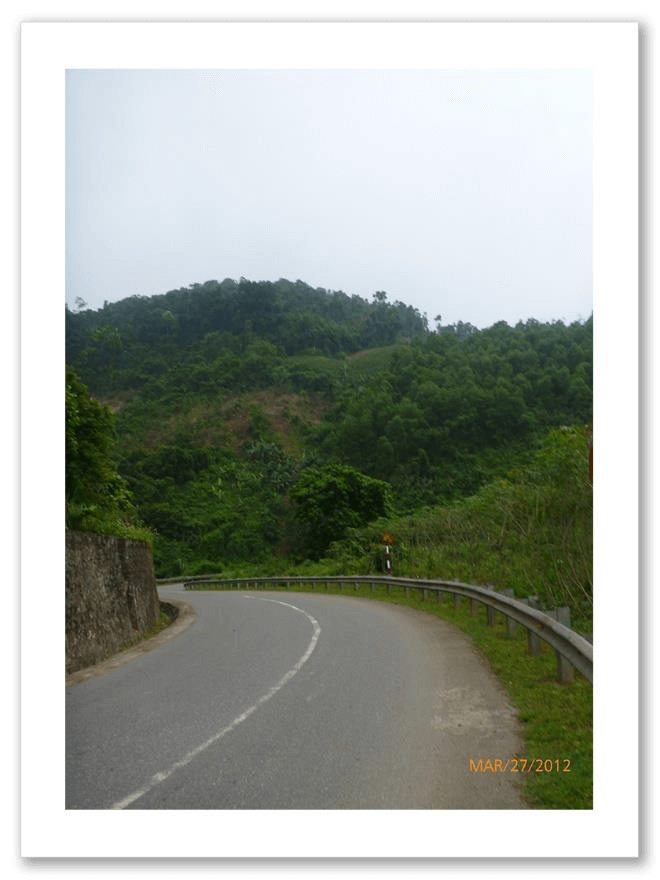
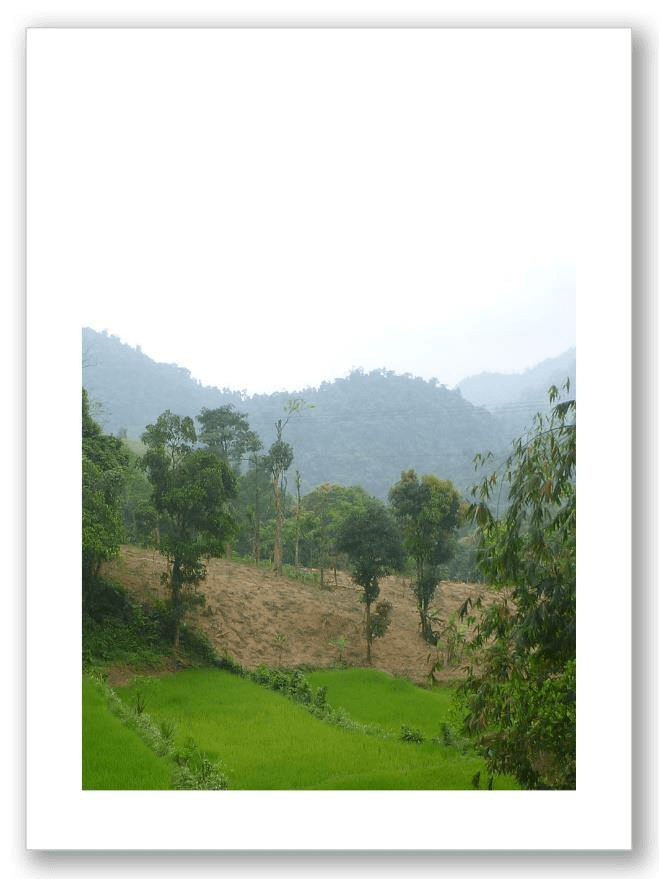
Hundreds of thousands went down the trail. Fewer than half came back, victims
of bombs, disease, malnutrition and exhaustion.
The initial stretch was up and down with large hills on each side. I was
walking on that part of the trail that Major Hathorn described as one of his first
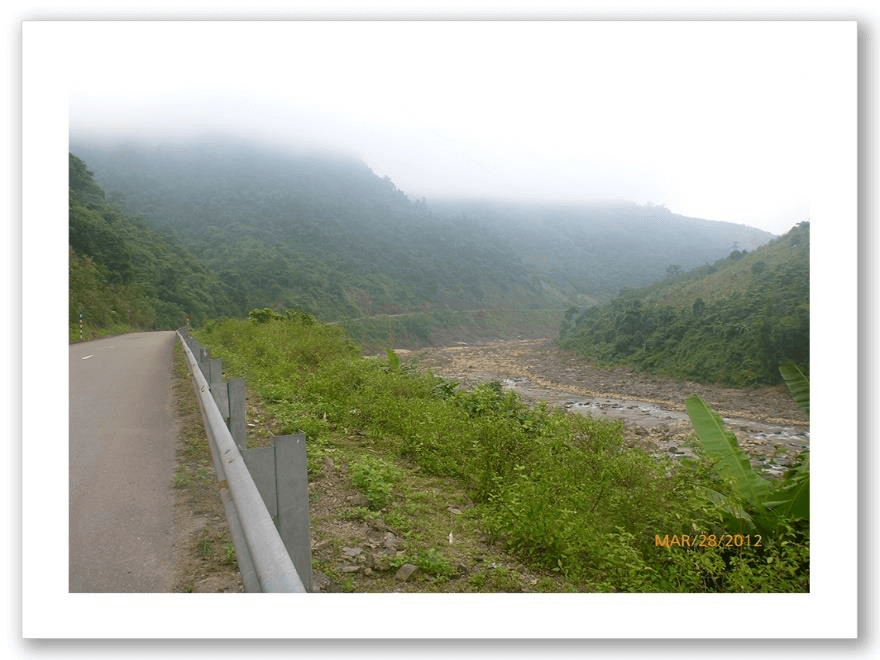 missions in Here There are
missions in Here There are
Tigers. I would occasionally
go close to the river. A stilt
home in a classic slash and
burn field exemplified the
isolation of the trail. At times
the landscape would break
out and the tireless industry
of the Vietnamese peasant
farmer would be juxtaposed
against the slash and burn
activity of the hill tribesman.
For those who have
walked the point, the Highland mists, which keep it cool, are a constant reminder
of the spirit world. I moved along, going up and down several hundred feet in five
A Step Back In Time
Page 69
kilometers, but the walk was not stressful. I adopted Joyce London’s view:
“Remember why you are here and enjoy it.” I knew somewhere further down
was a 2,500 foot climb with a screwy checkpoint at both ends.
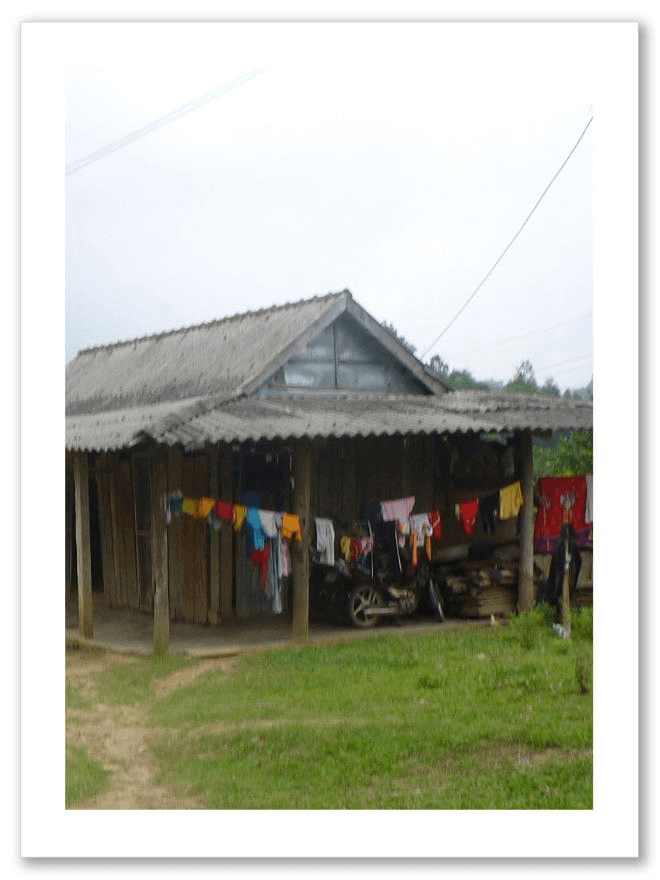
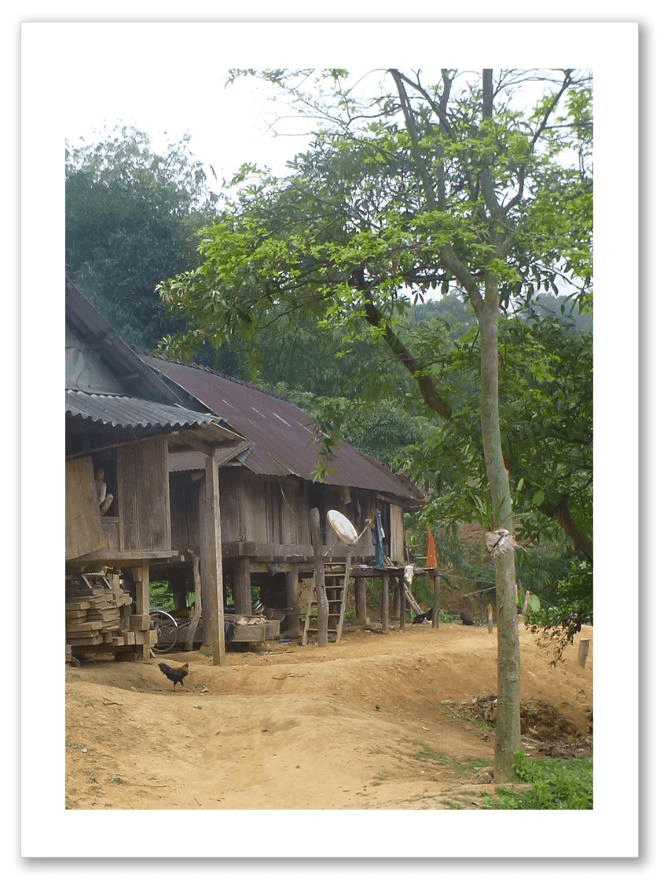
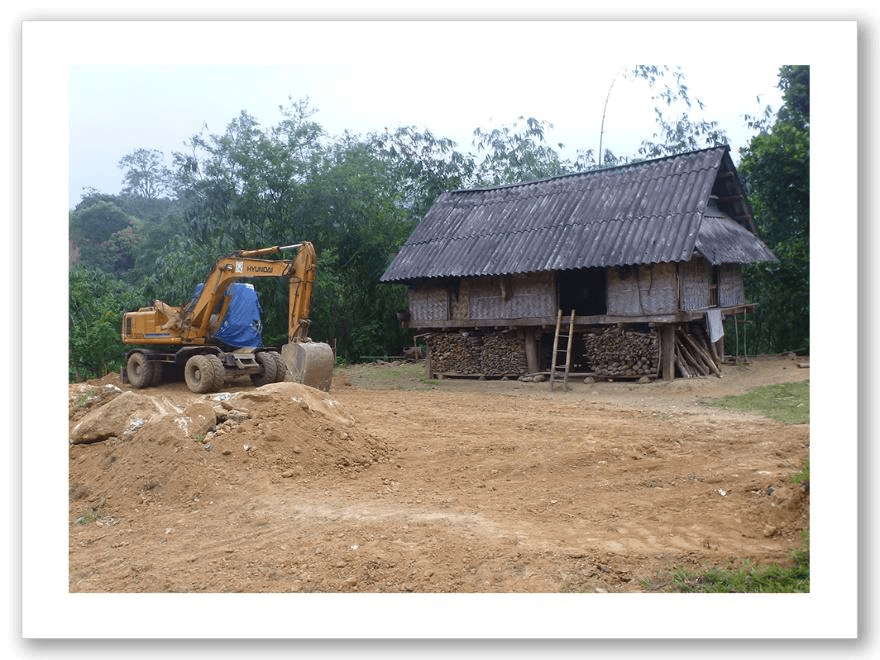
American style laundry came into view and the family washing was
definitely Southern California. Stunning landscapes showed the effects of slash
Page 70
A Step Back In Time
and burn activity, and I could oversee large fires from across the river. For four
hours the silence was deafening—nothing passed me, and I passed no towns of
any significance. I was getting into it when incongruities began to show up. At
what I thought must be half way to the checkpoint at Ly Ton, I noticed a stilt
house with satellite TV and another putting in a driveway for that Lotus second
car. As I moved along I looked mostly west and tried to imagine what it must
have been like when the first 0-2 appeared—marked smoke and you knew the fast
and slow movers were seconds behind. The trail continued to rise and fall, and
then I heard my first motorcyclist who almost crashed while looking at me.
When Stan and I selected Ly Ton as the first checkpoint we did so because
there was not much on either side, but now I was getting antsy because I had
passed no one to ask how much further I had to go. I carried on going up and
down with super scenery on both sides. Two more motorcycles passed me, and
I began to comprehend “there is nothing down there.”
On toward afternoon I saw the sun for the first time and I realized it was
the enemy. I tried to walk in the shade, but for long stretches it was impossible
to avoid the sunlight. I stopped for one hour, as I never move during the noon
hour; but when you are trying to hit a checkpoint your anxiety goes up after the
noon hour because, as everyone knows, when night falls in the Highlands you
cannot see the hand in front of your face. I pushed on now more to reach the
checkpoint than to live the trail. The terrain was hilly, the river had vanished,
and still nothing around.
I hit a work site and asked everybody which way to Ly Ton. I got blank
stares. I showed them my map—it might as well have been written in Sanskrit.
Best to go low key in these situations, but I was getting quirky, and for the rest of
the trip I always threw in Center Sandwich. No matter, I got the same response.
Then the road crew offered me food, and one guy said 20 klicks. Another said
nothing. I knew the guy who said 20 klicks was off because what had I been
doing for the last six hours? One pointed to Laos. Now I was in the game, but
what game?
It was getting late, the pucker factor started to kick in, and I pushed up
the treadmill speed. I found an individual who walked with me for two kilo-
meters to Ly Ton, which I would have missed on my own, as it was about 200
meters off the road. A small modern town of about fifty modern homes, and I
quickly became an object of interest to the younger cell phone set. There were
no elderly people in sight.
A Step Back In Time
Page 71
I produced Chris’s laissez-passer and it was handed around to much merri-
ment. I rapidly began not to like this crowd, and I guess it was mutual because
they gave me that contemptuous right hand wave and told me, in effect, to get
out of town. It was still light and there was nothing for miles, but I returned to
the road where I saw a young man in a hammock. I presented my pass to him
and he motioned me to wait. Out from a beautiful stilt house came a most dig-
nified individual. He motioned for me to come into his home, and pointed to the
floor in the family room. I had gone from hell to heaven in barely 400 meters.
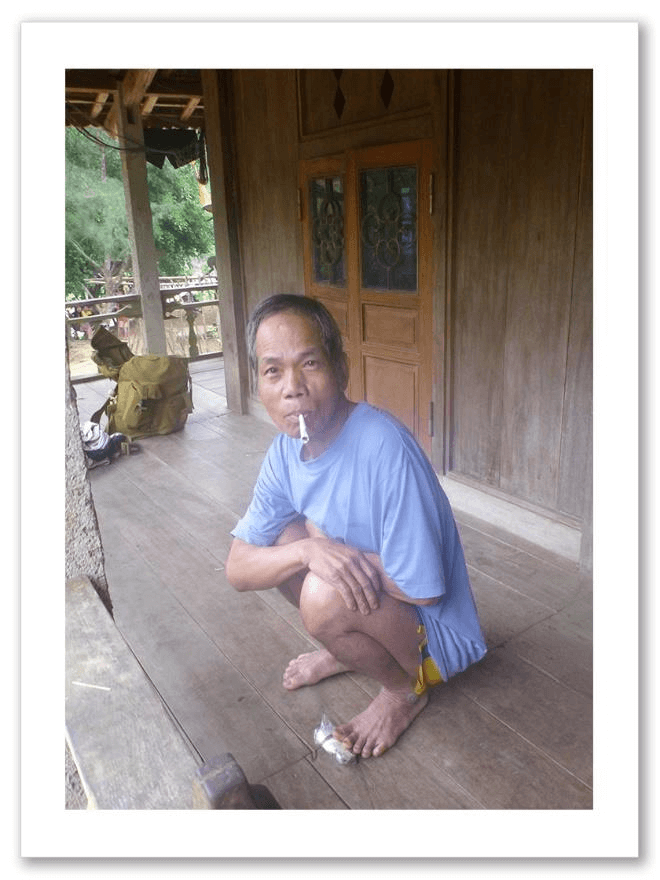 I went to the veranda, took off my
I went to the veranda, took off my
boots and leaned against the house. My
host came out and put a pillow between my
back and the wall. For the next hour as the
mists came in from Laos, I watched him
make bamboo strips with a razor sharp
sickle as he wove the most exquisite small
round basket I had ever seen. Me, I had
made my check, I had a place to stay, and I
was remembering what it was like to feel
good. I was in for a bit more.
As I re-entered the home I looked up
and saw two (not one, so he was obviously
a cadre of some sort) Viet Cong certificates
and a three foot long picture of Ho. My
host’s red star officer’s pith helmet hung
from a hook near the certificates. We could
not communicate with words, but I made him understand I was walking to A
Loui. I ate with the family, watched Vietnamese television—yes, TV on The Trail—
and spent the rest of the evening practicing English phrases with my host’s son.
Everyone gathered round to sample my PowerBars (chocolate won out over
oatmeal), and they all had a grand time with my Swiss Army Knife—does it get
any better than this?
Before I went to sleep I pondered why we have the McNamaras and they
have this guy—it just doesn’t seem fair! And I made a mental note to put Ly Ton
on a list, and they should be in the first frag order.
Page 72
A Step Back In Time
A Further Stroll Down The Trail to Meet the Wild Crowd
Overcast, warm
A zero dark thirty start and it was more than touching. My host woke
me and as I dressed he motioned me to the veranda where he offered me a home-
made cigarette. I signaled that I did not smoke. We sat together on the veranda
in silence as light came over the hills. When he finished his smoke he walked
me to the head of the courtyard, smiled and gently showed me to the road. We
laughed as I moved off. I looked back and he was still standing in the yard until I
turned out of sight. To my mind he defined, in its truest sense, the word “class”,
his ideology be damned. I needed to go no further to make the trip a success. My
plan had been to travel as fast and as far as possible, so that on the third day I
would be close to the climb, with Thon Ke as the destination, 31 klicks away.
I never made it. I was having too much fun.
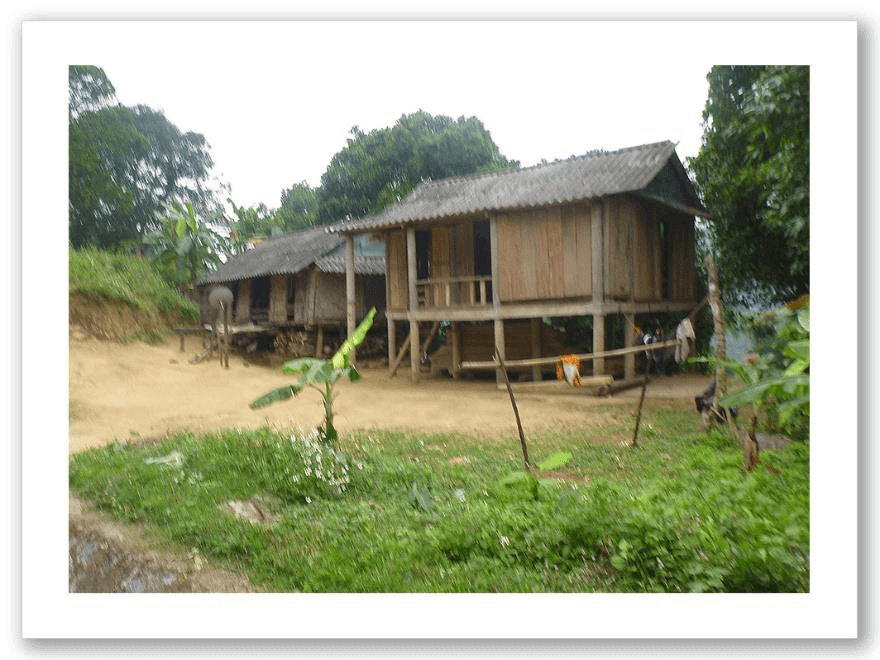 The road was a gradu-
The road was a gradu-
al climb with nothing, and I
mean nothing, out there. For
scenery, triple canopy jungle
on each side, and I was alone
again for hours with the
silence. The trail was open,
and the hills on each side be-
came steeper. No birds, noth-
ing, for miles. Two motor-
cycles passed and gave me
no notice. Hills steeper still,
houses with dish TVs appear-
ing out of nowhere, then on to more nothingness.
The idea that I should hustle to Thon Ke was good, but candidly I was
enjoying myself too much, and I slowed to take it all in. I kept looking for bottle-
necks and found none—the trail hugged the hill halfway up, open to the winged
death coming from the north, south and west but not east. Because of the hill,
coming in from the east would not give you a good run and you would over-shoot.
I kept looking to the west and tried to imagine seeing aircraft coming over the
hills on a run. More than sobering to contemplate. More silence, more reflec-
tion, slower pace. Although it appeared I was not climbing I noticed a strain on
A Step Back In Time
Page 73
my legs. The scenery was like the day before, but the hills appeared higher and
closer to the trail. No one passed me for five hours.
The sun came out and it started to heat up—here there was no shade. I saw
a van pass headed for Tarot and I knew I was not as far along as I hoped—I quick-
ened my pace, but more climbing and still no shade. I fell further behind on my
schedule. I came across a work crew and asked for A Deng, and showed them the
map. I got the idea I could have showed them Chaucer in old English and done as
well—vacant stares. Just to keep a hand in I asked for directions to Center Sand-
wich and got the same response. No surprise.
I passed a very small town I believed to be A La, and I stopped to get water.
I quickly became the center of attention in this 100 yard town, and I peeled off
my rucksack which was soaked with sweat. I opened it up and found my strip
map was soaked, as were my notes from the previous day. I sat and tried to plan
my next move.
An older man tapped me on the shoulder and motioned that he would like
to see the strip map and notes. I motioned OK. He carefully opened the map and
notes and put the individual sheets in the sun to dry. He then went back and sat
on his haunches while I pondered a lot of things about his conduct—good things.
I stayed there serenaded by the birds. Thirty minutes and nothing passed in
either direction.
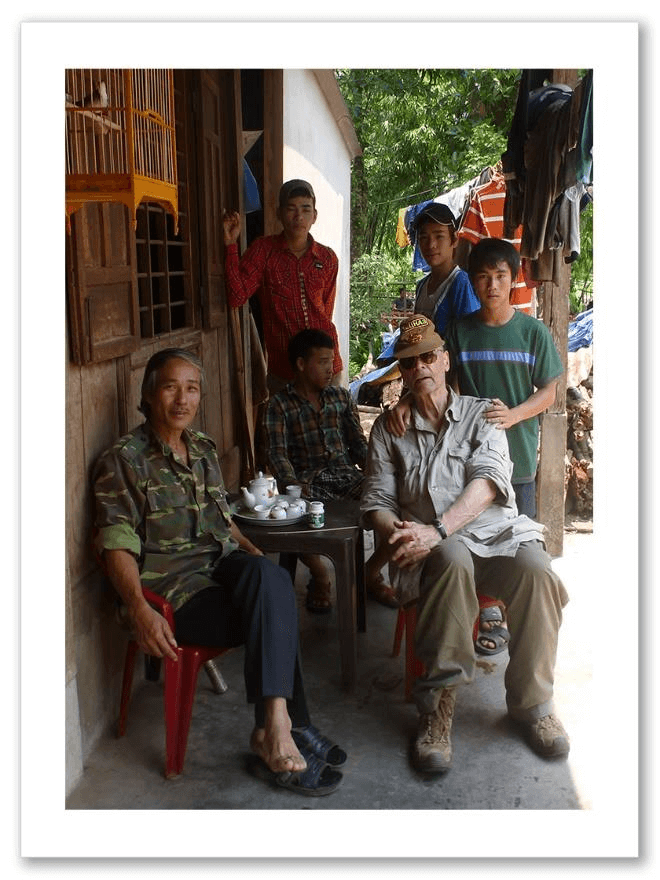 As I made to leave he carefully
As I made to leave he carefully
refolded the map and notes, wrapped
them in plastic and returned them to me.
Floored again! He motioned a request to
see my ring, and asked if he could put on
my sunglasses. The camera was not work-
ing. A shot lost for the ages. The whole
town appeared to see me off—does it get
any better on a cruise ship?
I had some decisions to make, and
although relatively cool, the sun was
starting to make my decisions for me. I
knew I was never going to make the next
checkpoint. The ground started to rise, I
hit A Deng, and the fun started all over
again. I stopped at a small store, cum
Page 74
A Step Back In Time
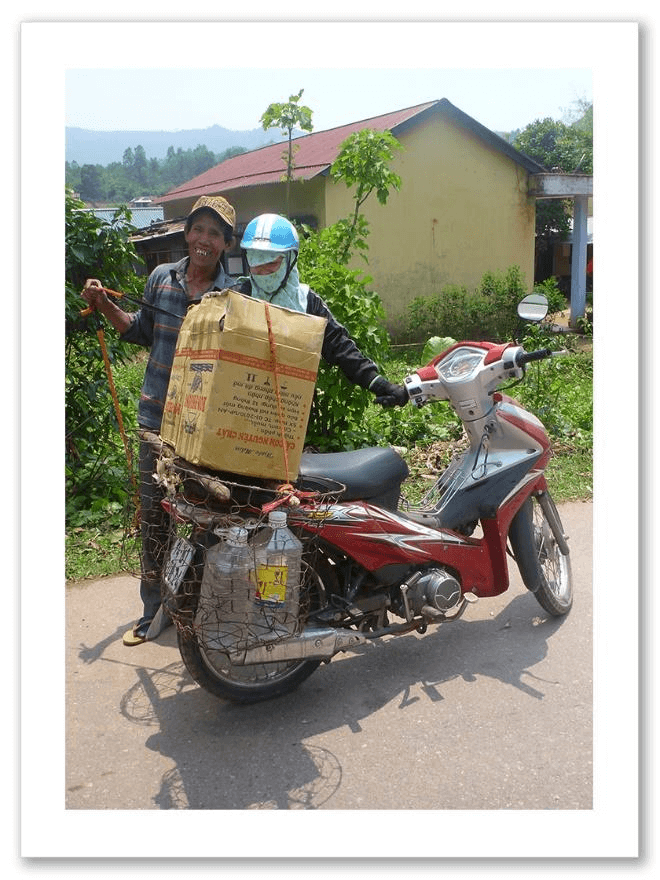 restaurant, and the group was, to say
restaurant, and the group was, to say
the least, eclectic. I was particularly
enamored of the camouflage worn by
one of the guys. My Buddha talisman
got things started, and then the ring.
It was as if the blue van crowd had
sent the word down the line. First,
the bombing routine, then the ma-
chine gun routine. Polite denials.
I knew I was at least ten miles
short of the checkpoint but the climb
had taken its toll. I produced my
laissez-passer and the family enthu-
siastically showed me where I could
sleep—a table in their establishment.
It looked good to me. The mynah bird
and others were going full tilt—more
than pleasant.
One of the most renowned chroniclers of industrial design is Henry Pet-
rofsky, and while waiting for evening to fall I witnessed a scene worthy of his
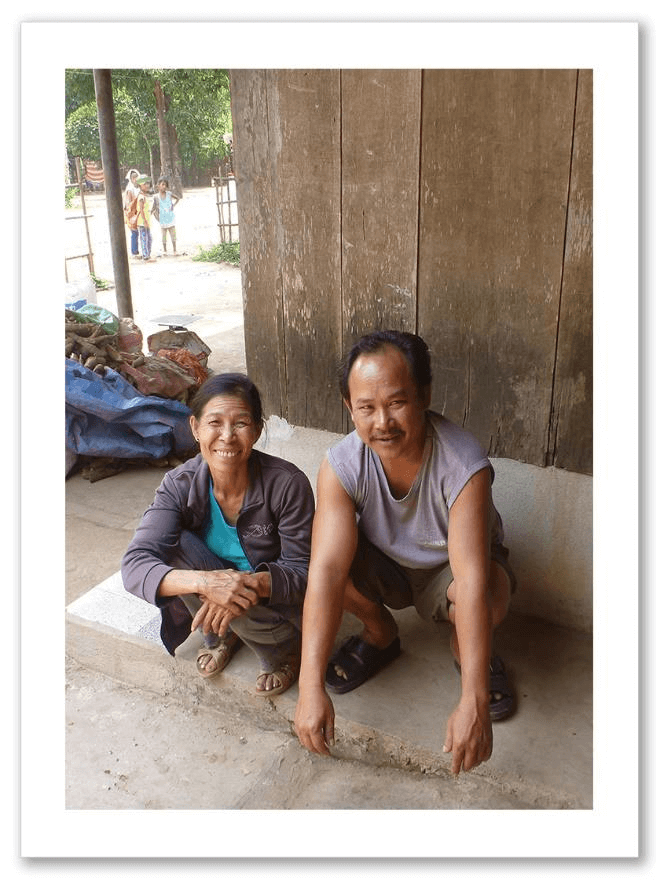 insights. A van arrived and two huge
insights. A van arrived and two huge
boxes were off loaded, a young man strug-
gling under their weight. Along comes a
diminutive Vietnamese young lady on,
I believe, a Honda Dream which was al-
ready loaded up with plastic jugs of cook-
ing oil. The bike had been modified to
accommodate two large metal wire bas-
kets, wings almost, on either side of the
rear wheel. The young man staggers, lifts
the two boxes onto the wings and lashes
them down. The young lady mounts the
bike, and with a grain bag on her lap fires
up the machine. At first it doesn’t start,
and when it does, the bike almost rolls
over from the load. Finally the engine
A Step Back In Time
Page 75
wakes up and bike and driver wobble off, drawing to a close the afternoon’s
human drama.
For the rest of the afternoon I watch life pass by—nothing—but when I tell
the group I was headed to A Loui, Mr. Camouflage gives the universal sign for
sex; he was heading out to get some and did I want to come along. He departs in
a cloud of dust. I quietly watch the night approach, walk to the end of town and
scan the ridge lines—they looked higher. My host and hostess offer me food, and
I note that up until I went to sleep nothing passed us—this was the end of the line.
A Night on Bald Mountain
Overcast, warm
I knew before I started that I was in for a bit of a go. The family saw me
off. Camouflage had not returned from his sexual adventuring. I was at least ten
kilometers behind schedule, and I was looking at a 2,500 foot climb. The sun was
coming out and from Thon Ke I faced 10 kilometers of nothing on this side of the
hill. I needed to get to Ta Ay—not going to happen—because I had time constraints
and no money if I missed my flight. Comrade Chris’s wisdom in building in a day
came into play. I had to move—onward and upward.
As soon as the trail turned east I was climbing, and I mean climbing. The
northern vistas were small canyons of triple cover jungle. The southern were
steep hills close to the trail. My camera was acting strange and the best approxi-
mation I can offer would be a black and white Sebastian Laval photo of the High-
lands. The surroundings were beautiful, not to be missed, but a bitch for me, and
my “walk 100 steps, rest 10 seconds” was not cutting it. The trail was below the
ridges, but with a steep drop 2,500 feet into the small canyons. To your right
the hill was right on you, and the grade steep. Hard to appreciate all the beauty
when you are slogging to reach an unattainable goal, but I had discovered a
targeteer’s choke point dream. I do not care how strong you are, when you are
pushing the equivalent of your weight up 2,500 feet you slow down. You are
more than vulnerable, especially on a switchback. In this instance your bombing
or strafing run would come from the south, and you could slide the whole hill into
the canyon.
I take a few moments to ponder this. True, many years had passed, but I
would have thought the area would still look a bit like the surface of the moon.
Not so. To me there seemed to be no visible damage at all. I continue to walk, and
I am definitely straining. I pass a road repair crew with a blue tent and a table,
Page 76
A Step Back In Time
but I press on. I will quickly regret this decision. I think again about what it
must have been like for porters to carry, push, drag and wheel their body weight
up this hill. I was only carrying 30 pounds. They were carrying 150—better men
than I. I will never again look at a climb up Mount Chocorua as anything more
than a pleasant stroll.
Once more, Joyce London’s admonition kicks in, and I let myself take it
all in—but this Ansel Adams moment is tinged with anxiety, because where am I
going to stay? I can either throw myself into the canyon or find a break in a nine-
foot drainage ditch, and drainage ditches harbor all sorts of unfriendly creatures
and unpleasant things, not to mention the water. Plus, I could feel the humidity
beginning to ramp up.
Prior to my leaving the States, one courtroom deputy declared dismis-
sively: “Batchelder is going to Vietnam so he can sleep in a ditch.” At this point
in time a dry, reasonably safe ditch would have done me just fine—there simply
was no dry ditch, and no way I could climb over the ten or eleven foot upside
retaining wall.
Nothing had passed for hours, and besides, I was damned if I would ask
for a ride. I couldn’t quit because there was no place to sit down. I cursed my
stupidity in not staying at the work station. The pull was beginning to get to me
and my stride was shortening. I increased the length of my steps. Finally, I was
able to scramble gracelessly over a somewhat lower retaining wall—a memorable
sight had there been a passer-by.
I could go no farther—had to spend the night. A steep grade, but some
sturdy if not large trees. I had faith in my equipment and I went into attack
mode. Two things of concern were snakes and leeches. I tied off my ankles and
waist and put my feet in the ruck and cinched it up—belt till it hurt—and then got
into a cocoon poncho which I cinched up, everything in it cinched about as tight
as possible. Knees up, tied it all to the tree. Time to take in the view. For two
hours I watched the mists come in, and then pitch black.
Just before it all shut down, a guy on a Honda Dream came racing by talk-
ing on his cell phone, and that, to my mind, was an act of devotion, because if he
slipped he was gone forever. No one would ever find him in that triple cover
2,500 feet down. I hope his dinner was warm. I sprayed myself and all around
me with insect repellant, not knowing if it was a good or bad thing, but if it had
been Strontium 90 the area would be a hot spot for a million years. The repellant
tasted vile, and I hoped it would discourage any uninvited guests from entering
A Step Back In Time
Page 77
the cocoon. There were no noises or sounds whatsoever. No stars, no light, pitch
black. Although not an ideal situation and not in the travel brochures, I wasn’t
too badly off—the cocoon poncho was almost tent like, if a bit snug. Although the
insect repellant was vile, I felt reasonably safe, and I was on the very road where
400,000 ghosts and shades patrolled. Although not exactly a relaxing evening,
the bastards hadn’t put me down, nor was I going to quit! I was so cocooned up I
could not get to my water and PowerBars, so I just had to hold out the night—the
porters had endured a lot worse.
Before going to sleep I flashed back to summer session of my first year of
law school at the University of Virginia. Charlottesville is a lovely spot, but if you
are straight out of Southeast Asia and have been cooped up for nine months with
no money it tends to addle the mind.
In those days the school had a shirt and tie dress code, somewhat relaxed
for summer, but punctuality was mandatory regardless of the season. My room-
mate and I were living in a cave apartment that was so damp mold grew on our
shoes. When he prepared a sumptuous repast for a lady friend she politely indi-
cated she would forgo the pleasure of returning, and in the future she would cook
meals for us.
Anarchism or whatever was in the air and we, both veterans, wanted to
make a statement. I had a Japanese yukata complete with wide sash, and even
straw sandals. I do not remember what he was wearing, but as he is an intellec-
tual and very inventive, it was surely wildly inappropriate.
It was raining hard when we emerged from our cave. As we got to the top
of the stairs some guy started playing, loudly, some discordant, weird, powerful
and haunting music. We stopped. I asked my roommate what it was, as he knew
everything. He answered, Mussorgsky’s “Night on Bald Mountain.” In the pour-
ing rain we listened through to its conclusion.
You were never late for class and above all you never made anything
that could be construed as a “grand entrance.” Professor Bunn said nothing as
we entered, but it was the talk of the law school for the year. More importantly,
although I can’t hum it, “A Night on Bald Mountain” stuck with me through life.
Additionally, I had recently discovered Mozart’s “Piano Concerto 20”—and who
doesn’t know 21—and its haunting first movement was burned into my soul.
On that desolate mountain in the Central Highlands the eeriness of the
Mussorgsky, and Beethoven’s equally haunting cadenza to Piano Concerto 20,
Page 78
A Step Back In Time
were companionship enough. Quiet, no lights, emptiness—with companions like
these we will do okay, and we did. I went to sleep without a hitch and, although
I missed my check, I was still in the game. Attack, attack, attack, and if you fail,
attack again and the world will yield.
The Gay Caballeros and the Ambiance of A Loui
I awoke at first light and slowly, ever so slowly, shook things out. No
leeches or unwanted intruders, but I am ripped at myself and on a mission. By
my calculation I am just below the big switchback, and I have about 21 klicks to
go and a 1,000 feet climb. The camera works for one picture, I hope, and I am
moving out, and I mean moving out. I was so furious at myself I was almost
glowing. I got into a new regimen. I took little notice of my surroundings until
I hit the 18 klick marker from A Loui and found myself on level ground. The
houses were more modern and I soon began to pass small towns. Then, to
my surprise, I came upon a wide boulevard town with some French Colonial
architecture. I was surprised because I had not expected anything so grand.
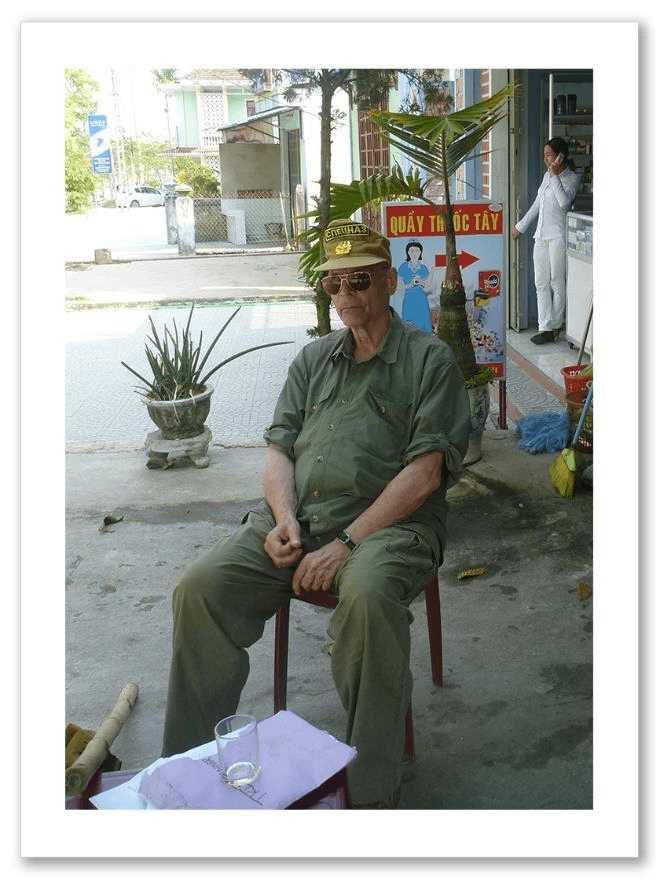 I realized it had taken me almost eight-
I realized it had taken me almost eight-
een hours to do 26 klicks—must do
better with the elevation planning.
I passed, of all things, a three
story glass and steel hotel, and I do not
understand to this day why I continued
on, but I did. Propitious choice leading
to many hilarious moments. I came to
a small café, cum music store, where
four Vietnamese caballeros were
seated. One picked up a Coke can and
held it high, shook it and motioned for
me to sit down, which I did. They
bought me a Coke and we started the
pantomime. Much checking of my legs,
and when I pantomimed I was walking
to Hue they offered a ride. Although I
didn’t speak their language they were all enjoying themselves so I silently joined
in. I was the recipient of another Coke. I didn’t tell them that although not a
A Step Back In Time
Page 79
drinker I was in such a fury at myself I would have tossed back absinthe if they
had offered it.
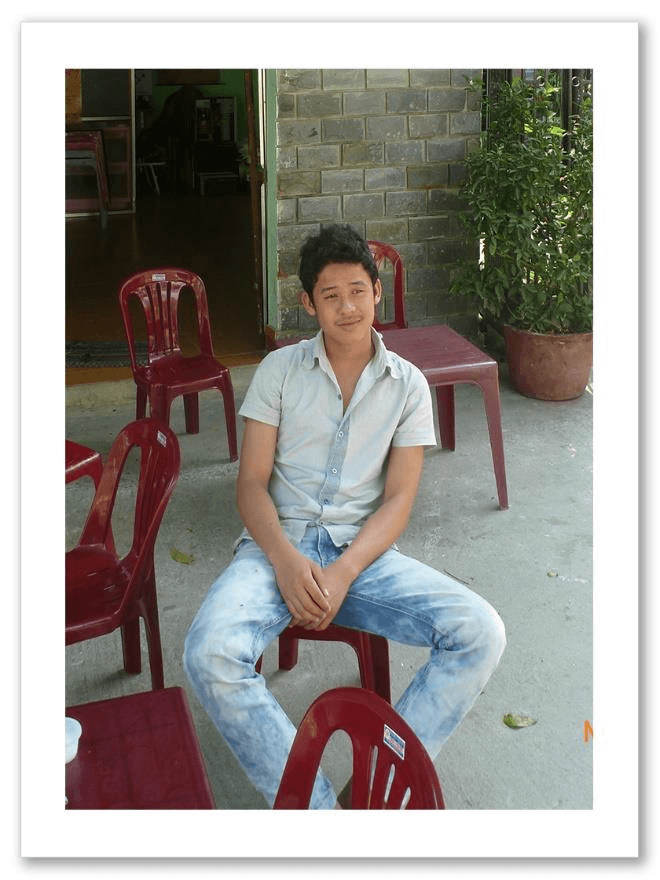 After my second Coke I noticed
After my second Coke I noticed
the music sounded familiar—it was Clay-
dermann playing “Rhapsody in Blue”, to
my mind the anthem of New York. We
listened for almost an hour and one of
them came back with the disc and offered
it to me as a gift. I politely declined. Clay-
dermann, seventy-five miles down the trail
with four guys I can’t speak with drinking
Cokes—how cool is that?
I indicated I was hungry and they
directed me to a shop next door. I pre-
sented my food note from Comrade Chris
(“I want beef soup” or “I want chicken
soup”) and ordered chicken. I had seen
the chickens as I entered, which gives
new meaning to the word “fresh.”
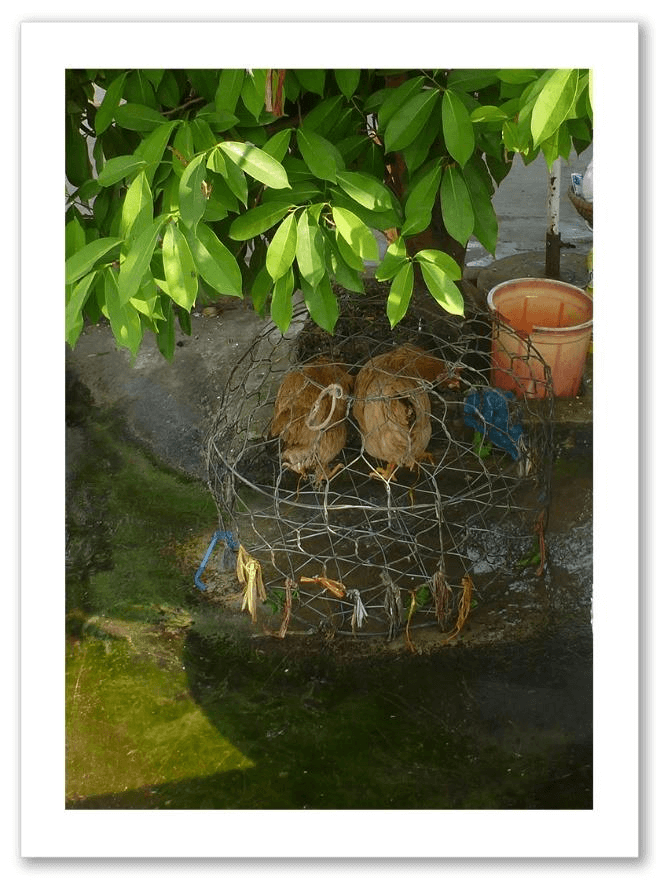 My beef soup, not chicken, ar-
My beef soup, not chicken, ar-
rived but I didn’t care if it was rancid
wildebeest, it was going down; Power-
Bars had lost their luster at this stage
of the game. The cook, with a great
flourish because she decided I was not
skilled with chopsticks, stuck a large
pair of shears which had been God
knows where into my soup and cut up
the noodles. I did not care where they
had been—it beats PowerBars. Hot
food! Over the top!
While I was enjoying my wrong
soup, a large heavyset woman in a
tight-fitting green muumuu arrived
and seated herself a few tables away.
She took out a ledger and appeared to
Page 80
A Step Back In Time
be reviewing the entries. A few minutes later a Vietnamese young lady arrives
on a tricked out Honda Dream, wearing a beautiful tan suit and sensible shoes—
your basic ten and a half. She would float down Fifth Avenue.
Madam reviews the ledger, counts out about twenty bills, and Miss A Loui
departs. Me, I am into my soup, but about ten minutes later my interest piques
when another ten and a half skirt, not so sensible shoes, arrives on a tricked out
bike—velvet crash helmet no less—and sits down with Madam who counts out
more bills. Ms. Second Skirt A Loui departs and, although slow on the uptake, I
think I have an idea about what is going on—lucky Camouflage Guy, whichever
one he got, although it may be that only time will tell.
At this point Madam notices me, gives the universal sign for sex, holds up
fingers one and two, grabs her cell phone and starts to make a call. By this time,
after much practice on the trail, I have the dismissive Vietnamese right-hand-
wave-off down pat, and I flash her one. But to be gallant I blow her a kiss. Sadly,
she did not appear to be amused. However, this little tableaux explained why
Camouflage Guy was so hot to blow out of town the other night.
I pantomime with the caballeros and they confirm the hotel is owned by
Chinese. When I give them the universal hand sign for sex and hold up two
fingers—they hold up three. No wonder Camouflage was still MIA. One of the
caballeros takes me to a five-dollar guesthouse; I want to get out of my clothes,
take a shower and become a “new man”.
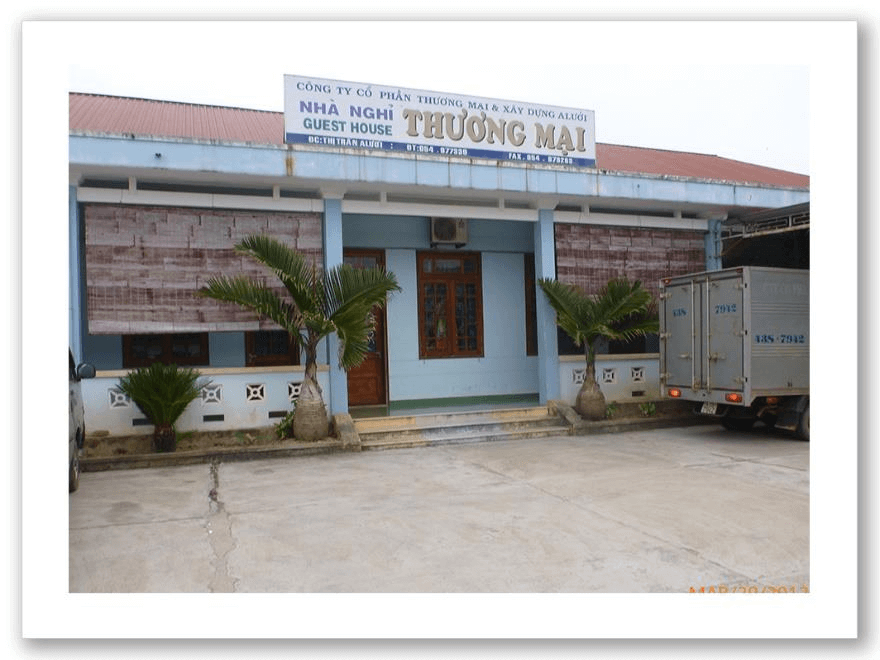
A Step Back In Time
Page 81
I attempt to register with a reasonably attractive young lady who is charm-
ingly clueless. Next, as if on cue, a grossly obese older man with his belly hanging
over his belt appears and starts yelling for my passport. I turn it over. I must
check with Comrade Chris to see if this belly over belt routine is meant to be a
fashion statement.
My room is basic but clean and gives new meaning to the phrase “the
water heater is in the bathroom.” The showerhead, no bathtub or stall, sprays
water right onto the bathroom floor, not exactly the Waldorf. Before I showered
I thought I would charge my camera as it had been acting screwy. I put the
charger into one socket and it shoots into the middle of the room. Undaunted, I
put it into another outlet and this time it shoots six feet into the air. A Maquib
exorcism is clearly called for, but not before I take a shower. No hot water, but
the Harlem Y had cold water showers. I dove in, and almost immediately the
power came on. The mist and the wires intrigued me. I had visions of “Geriatric
Vet Electrocuted In Vietnam Under Mysterious Circumstances,” but I refused to
quit—I had to get that insect repellant off me to open the pores. I soldiered on,
and the water was nothing compared to the Y. All new clothes laid out for tomor-
row, and then it hits me. The walkabout will soon be over. I wanted to keep going
to Saigon. Ennui.
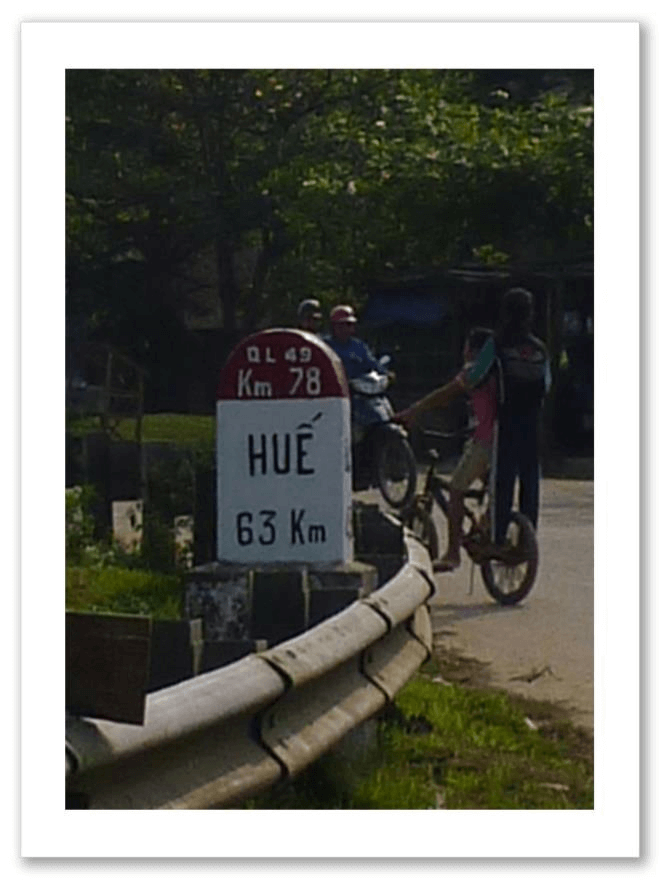
The Way Home
Overcast, warm
Stan and I knew precious little
about Route 49 except that it was 62
clicks to Hue and there was no place to
stop. The standard response to inquiry
was, “no water, no place to stop.” Little
water, true, but if you love the High-
lands the experience is magical—truly
magical. The terrain is downhill, and
much can be accomplished in the shade
until the ground levels out. Once again I
was walking through a living Sebastian
Laval photo. I was enchanted.
I didn’t want it to end. I got up
early and made my slow, solitary way
Page 82
A Step Back In Time
out of town, or so I thought at first. As I walked I noticed I was joined by more
and more kids. I thought I was big stuff but as we came to a school they all
dropped off—big man from the East crushed by his arrogant assumption. As
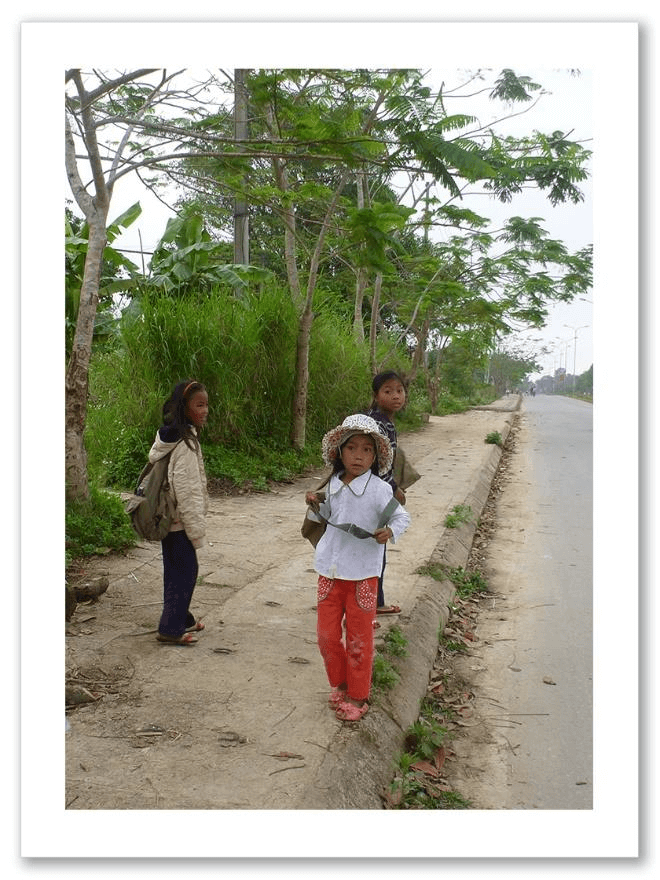
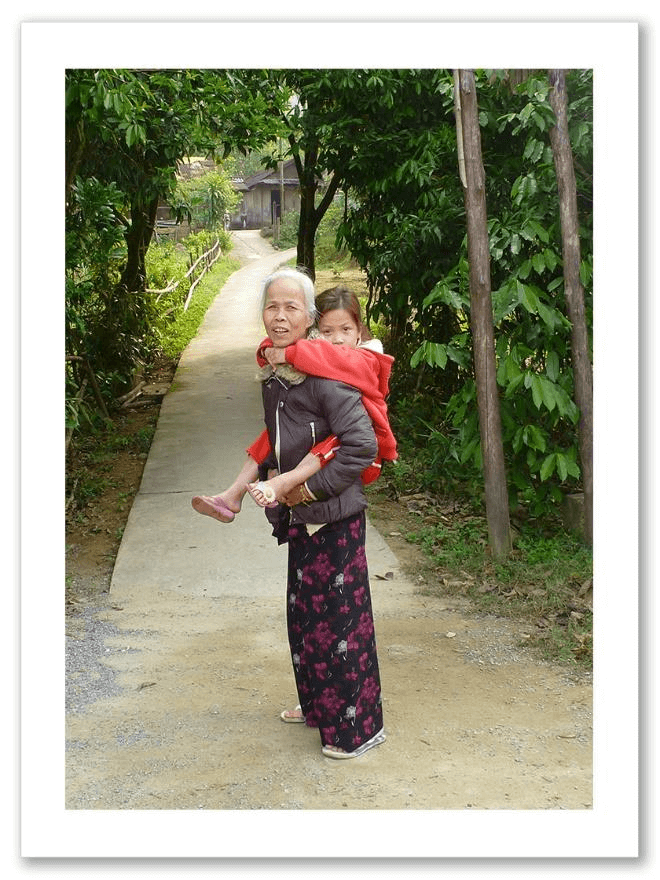
I moved along I came once more to a clash of East and West. Despite the stilt
house in the distance, grandmother and granddaughter have both feet in the
West, whereas the peasant woman with her bike could be a porter on the trail.
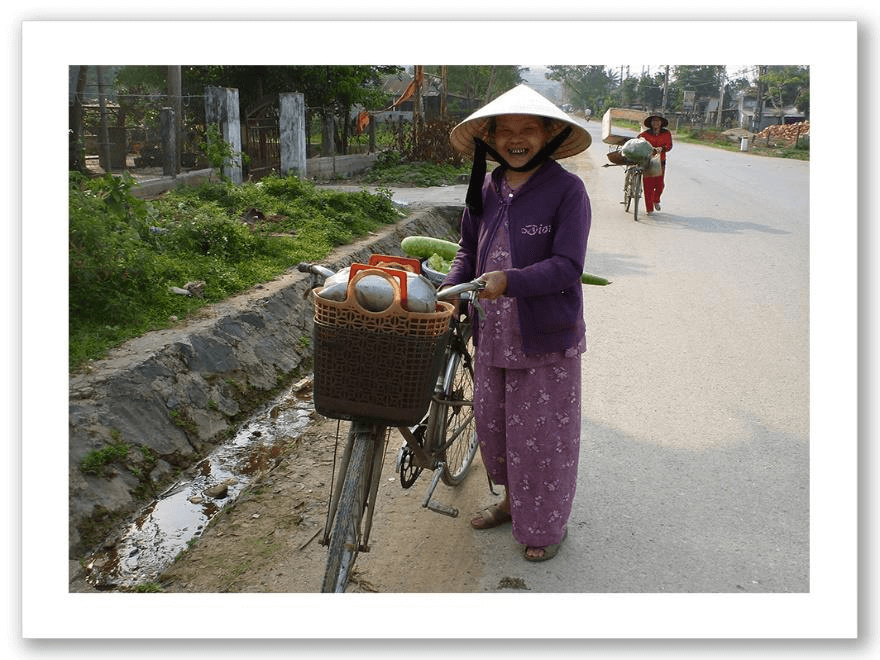
A Step Back In Time
Page 83
I knew the Hue turnoff was about 8 klicks from the hotel, but when I came
to a local market I sat down for a cup of tea—I just didn’t want to let it go. I began
to think about Ashau, only 24 klicks away. It can’t be as tame as A Loui. Then
on to Saigon—get behind me Satan, just not too far. I asked the guy at the next
plank for Hue, and he pointed to a group of low buildings down the road. What
was I supposed to do, walk through them? I tried again and got the same re-
sponse. He must have thought I was nuts, and I was sure he was off. Finished
tea and walked on. By chance I looked over and the Hue click marker was there;
if I hadn’t turned my head I would have been on my way to Ashau. Not such a
bad thing!
No farewell, just a small one lane paved road. I entered a tree lined canopy
and I was headed home. I climbed for a couple of kilometers and then saw the
most spectacular Highland view—another Sebastian Laval postcard come alive—
little traffic, and I started going down gradually. Wall to wall vistas of the High-
lands. Walking in the shade, it was magical. As I walked on it was all before me,
with a few ups, but the vistas were awesome—beyond magical—clearly no place to
stay, but I reluctantly kept up a good pace. Very light traffic. Every cyclist who
passed me offered me a ride, and after thirty kilometers towns appeared. I didn’t
want to let go so I slowed down.
I was getting close to the plains and the heat and humidity began to attack,
but I was still high on the first part of the trip. As close as I could figure I was
about seven klicks from Quoc. I engaged in a bit of civil disobedience. I went into
a schoolyard and watched the world go by. I am used to New Hampshire’s beauty
—its mountains are higher. Here the drop off into the valleys reminded me of the
Helambu region of Nepal. The silence settled comfortably on my shoulders; once
an hour a bike rolled by. I stayed on the school veranda and nobody seemed to
mind.
Page 84
A Step Back In Time
VIEWS FROM THE TRAIL • MARCH 2012
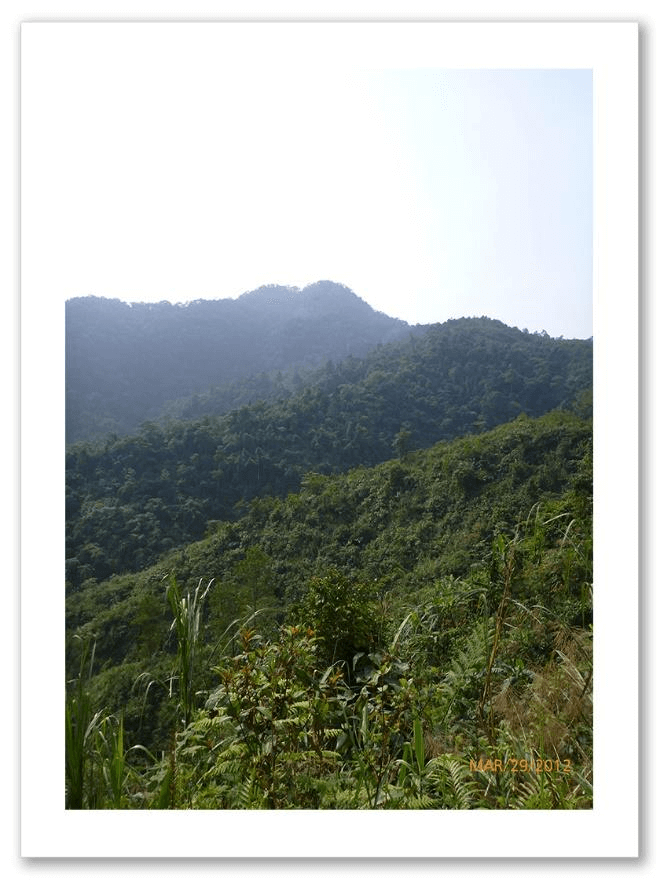
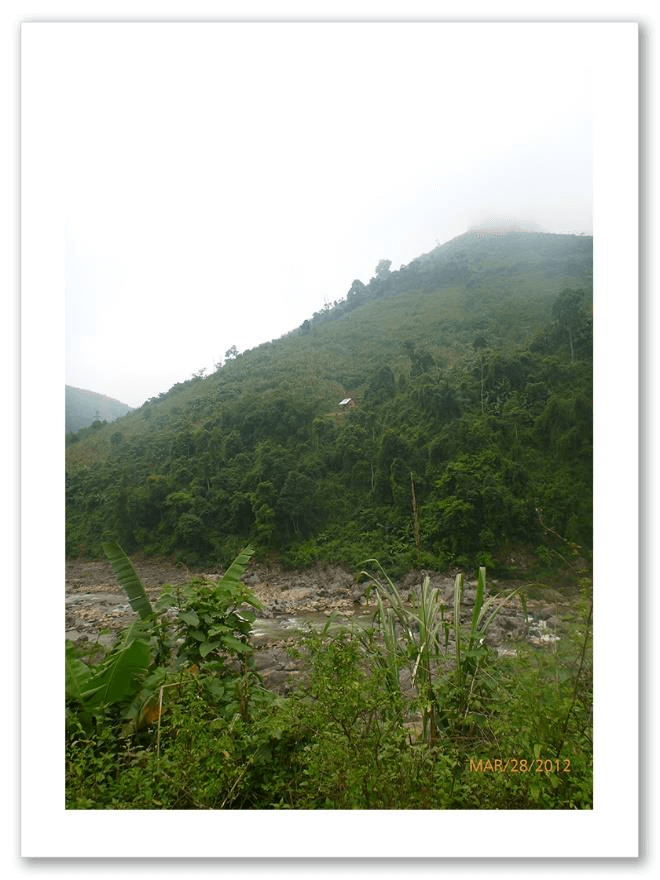
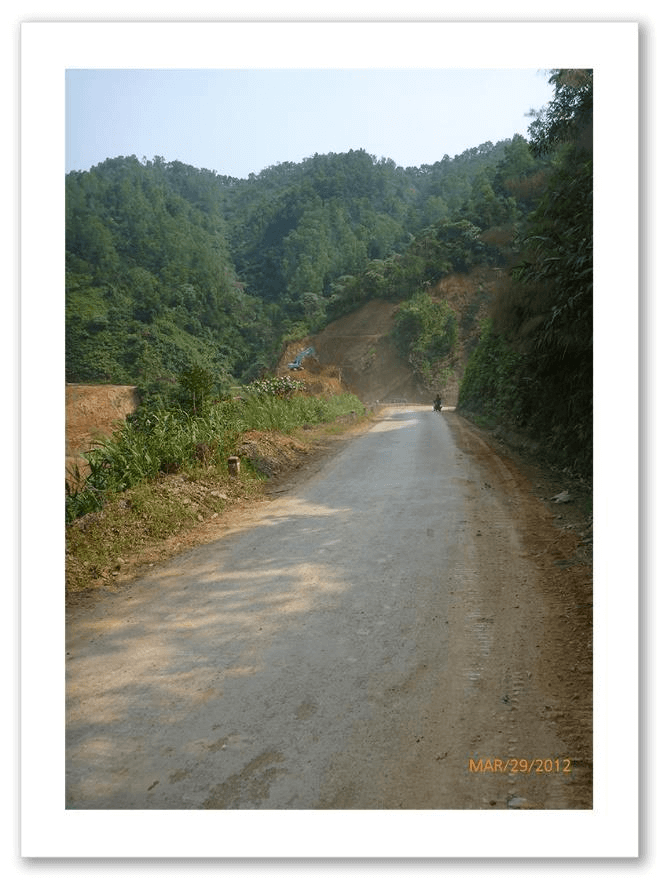
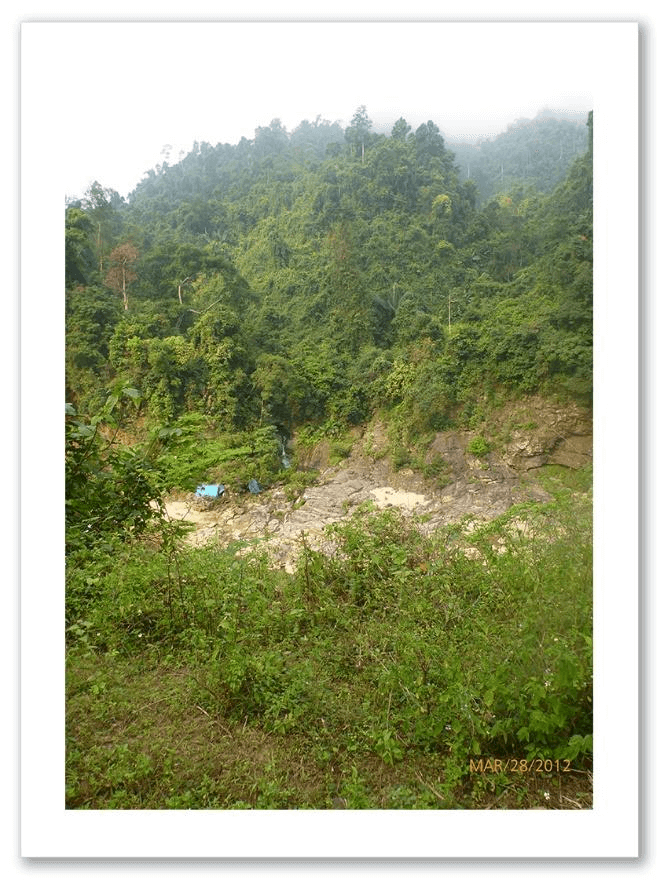
A Step Back In Time
Page 85
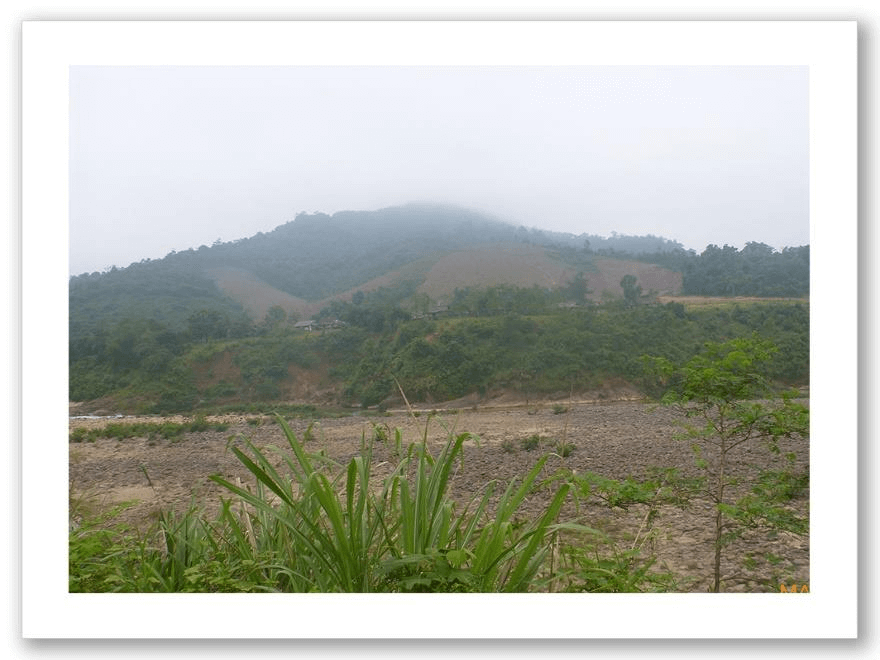
Where is La Residence?
Rainy, warm
Yesterday I could kid myself that it was not all coming to a close, but
today I had no such illusions. As I moved toward Quoc I began to encounter small
businesses and almost immediately the bird symphony commenced—pleasant,
welcoming sounds. The day began to get hot and I started my search for La Resi-
dence—this proved to be more challenging than any French boxwood maze. I
kept walking until I hit a huge concrete bridge and I knew I was crossing the
Perfume River—lots of stares as I walked across the bridge. I was a bit lost, but
I knew if I turned north I would be OK.
My reasoning was just follow the river, hit the Citadel, and then into La
Residence. Sounds good but that only works if the road follows the river—it does
not, and I might as well have been in the casbah in Algiers. I must say I was
pretty much ignored by the outskirts crowd, and I didn’t much care if I had to
wander around all day. I just didn’t want it to end. I was going to walk in as I
walked out. I spied a green taxi, hailed him, got a quizzical stare which soon
turned into laughter—he didn’t know where La Residence was, these five stars
are hard to find! He got in the game, went to his base. La Loi Street was the
rallying cry. He drew me a map and when I tried to give him money he refused.
I set off and when I emerged from the casbah I knew I had it made. At this
juncture city folk became as curious as country folk about this strange apparition
in their midst. I walked into the lobby of La Residence with eight days growth of
Page 86
A Step Back In Time
beard, a club, a Spetsnaz signature on my hat with a Russian airborne roundel
on the cap. I think it can fairly be said I was not one of the usual lobby denizens.
The front desk crew had been most helpful before the trip and came over
to quiz me about my adventure. I complimented them on the beauty of their
country, and the hospitality and kindness of the people I had encountered.
The ice cream at La Residence is so expensive, but oh so good—ice cream
for the reception staff and two scoops of coconut for me. I took a seat near the
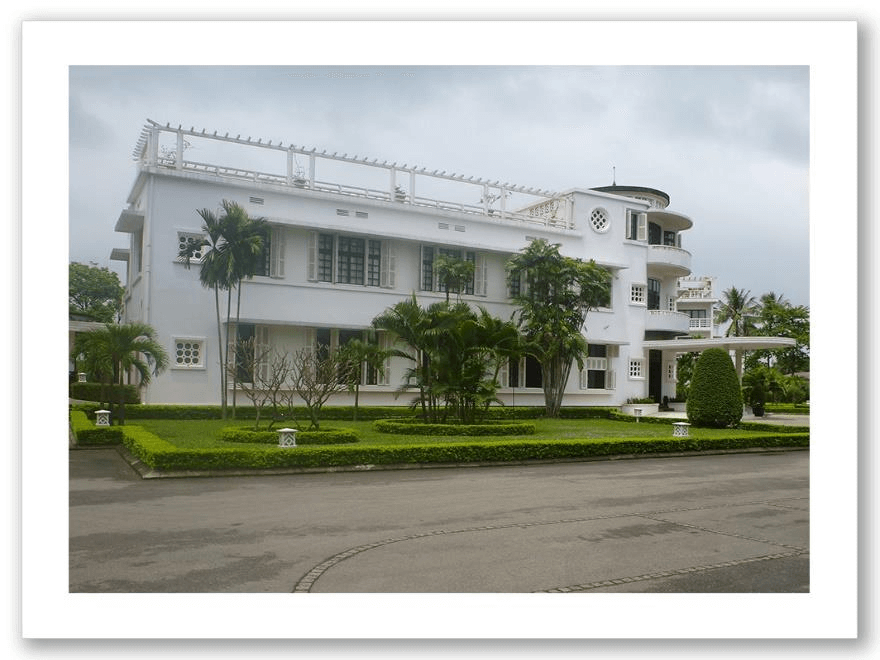 bar as I savored the cool
bar as I savored the cool
smoothness of the ice cream
and the subtle coconut flavor—
for three months I had disci-
plined myself not to eat ice
cream. While I contemplated
the “real” meaning of coconut
ice cream, two couples, two
Governor’s Island types, one in
camouflage shorts, the other
in yellow shorts, and their two
wives, a bit out of sorts by the
look of it, in Talbots and Ms.
Brooks, gingerly sat down at the adjacent table.
Camouflage Shorts wore NATO pattern, thank God it wasn’t tiger stripe.
(Where do they find these war fashionistas?) He opened the conversation by
stating they had spent the day touring the DMZ but “it was a great waste of time,
there’s not much up there.”
Camouflage Shorts looked at the “equalizer” and told me I didn’t look too
good, whatever that might mean, and he asked me what I had been doing. I told
him I was walking in the countryside studying “native textiles”, and the stick was
to keep the animals at bay. I was pleased to see that this mollified the group and I
was no longer considered an interloper assassin that hotel security had failed to
latch onto. I did not elaborate further, but I asked if they were headed to Ho Chi
Minh City; it is better to use this appellation rather than Saigon, especially when
you are speaking to someone wearing NATO camouflage shorts in Southeast Asia.
I told the group that everything they could conceivably want was on Dong Hoi
Street; I had been put off initially by the camouflage shorts, although once I re-
covered my manners I wished them “good hunting” on their shopping expedition.
A Step Back In Time
Page 87
The camouflage value of courtesy to obscure the sharp edges of scorn never
ceases to amaze me.
I pondered “nothing much up there” for a while—well, for starters, prob-
ably 20,000 U.S. soldiers died or were wounded in the Highlands; and whatever
your political persuasion, at least 400,000 Vietnamese, give or take 100,000
souls, perished “up there.” I was reminded of a statement attributed to Stalin
that a single death is a tragedy, but two or more is a statistic. I don’t quite see it
that way, and if my walk taught me just one thing, it was that I had a lot of com-
pany from both sides every step of the way. Maybe that was what Camouflage
Shorts was getting at—sadly, I don’t think so, and, perhaps a bit cruelly, I didn’t
think Ms. Governor’s Island was thinking of anything but damaging that Black
American Express Card on Dong Hoi Street.
The photos that follow show a few of the treasures “up there”, missed by
the Camouflage crowd, who shared their time and hospitality with me if only for
a few brief moments. The gentleman sitting on a rock, a former recondo scout
out of Da Nang, spent seven years in a “reeducation” camp: Marines always have
it harder; the average camp time was about three-and-a-half-years. His English
was good, now cutting weeds—everything gone, family, the lot! Also “up there”
was an unnamed driver whose two uncles simply disappeared at Khe Sanh; Ms.
Red Feather Boa, whose concern on the day of my departure would melt a heart
of stone; my first Viet Cong cadre who by his simple gesture of hospitality lifted
despair off my shoulders; the shopkeeper who carefully separated my maps and
papers, put them out to dry in the sun and then just as meticulously put them
back together; and, among a host of others, the “Four Gay Caballeros” who lis-
tened dreamily to Richard Clayderman—I guess who and what’s up there de-
pends on how you look at it. I know how I look at it, and why I avoid first class
hotels, and the inevitable encounters with the vulgar rich, who are not merely
boorish but oh so boring—go get ‘em, Tom Wolfe!
Page 88
A Step Back In Time
HIGHLANDS GALLERY • MARCH 2012
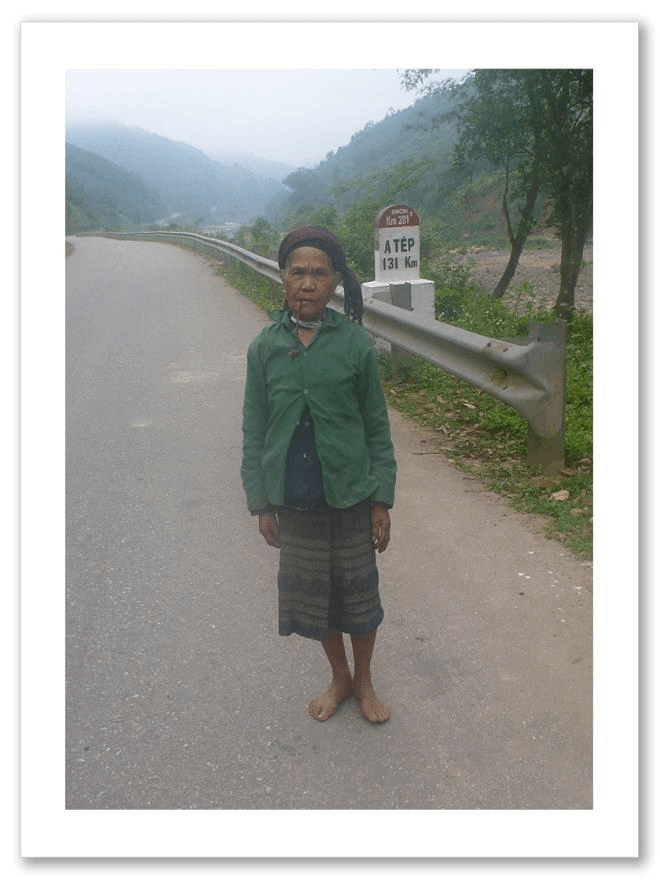
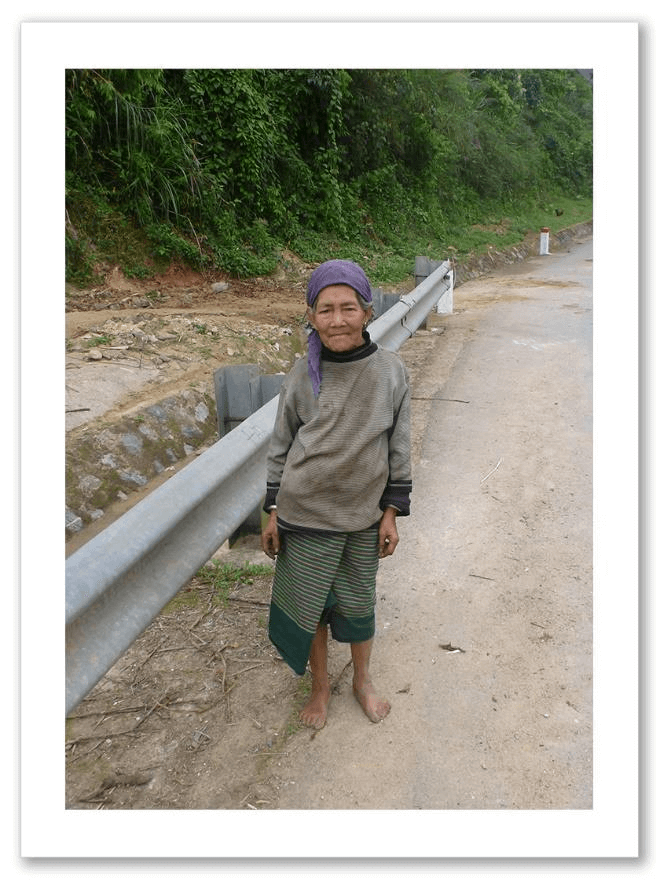
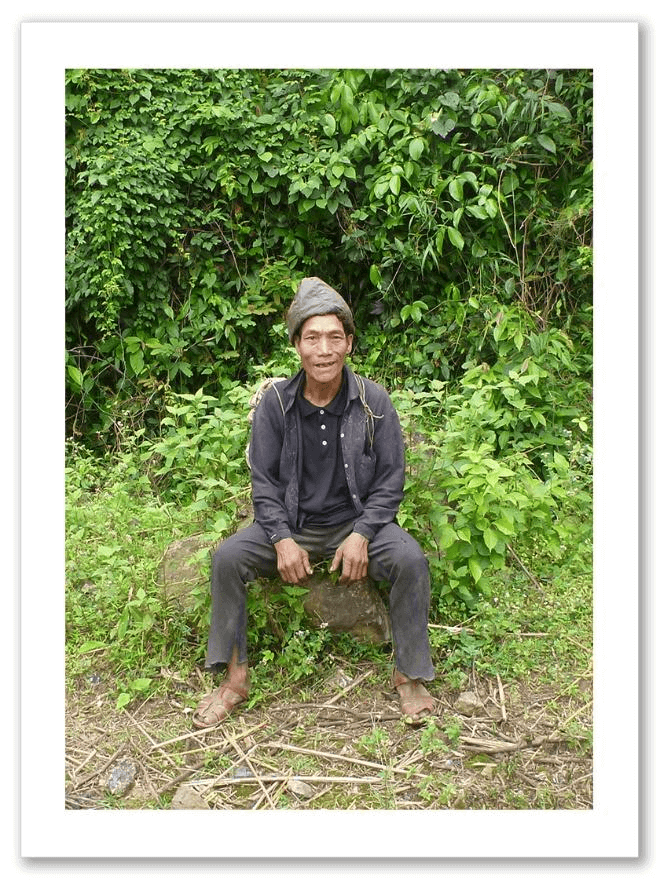
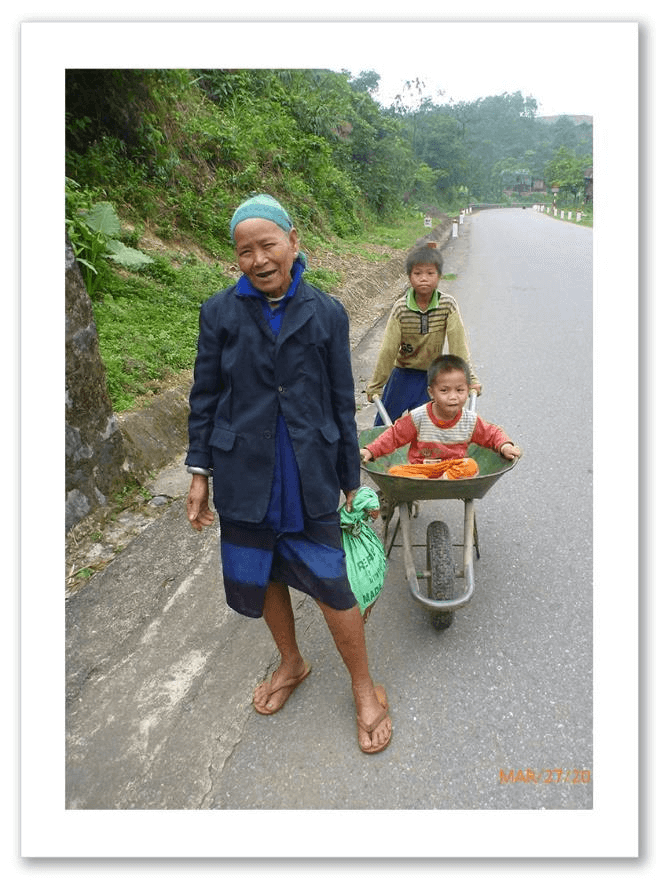
A Step Back In Time
Page 89
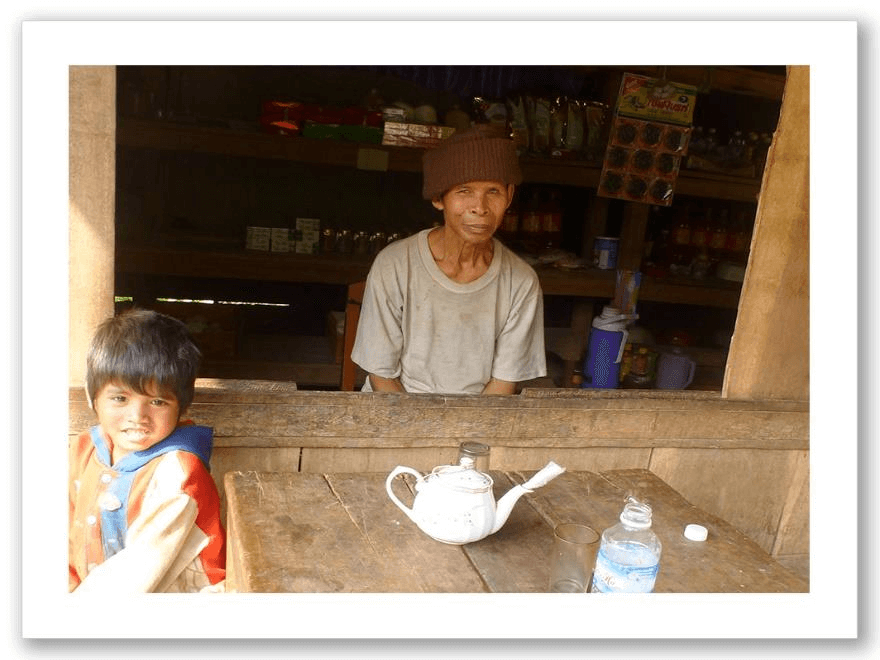
Those eight days are nothing to Sierra Club fanatics—could do it in a day
and see what? What’s more, this little adventure will have no impact on world
peace, global warming, gender equality; in fact no impact at all on any deeply
meaningful issue.
What it does prove is that if you plan carefully, prepare yourself physically,
and aim higher than you should, you can achieve a lot more than people give you
credit for. The SAS motto “Who Dares Wins” is a good one for life. On a personal
hygiene note, “The Trail” gave a giant boost to rinsing the sordid stench of curry
from my personal life.
The Last Days
I had a day and a half to kill but before embarking to socialize with the
bridge crowd I checked in at Harry’s to see that all was well. Customers “light”,
but I was put in charge of the red velvet rope, and when I returned the three lotto
sellers were waiting for me. Lotto tickets and Cokes all around. Who says good
news doesn’t travel fast, even in Hue? Oceans of black tea—appointment made
for tomorrow. I spent the day with the coven at the bridge and the stories flowed
like water. Back to Harry’s to patrol the velvet rope, on guard against the avari-
cious. I told the proprietress I would be leaving the next day.
Page 90
A Step Back In Time
Back into the Steel Bird
Next morning at Harry’s the three lotto sellers were waiting, and they
ordered me a Coke. They were drinking vile green tea, and when I went to pay I
was told by the proprietor it was their gift. We sat silent for an hour and when I
got up to leave they each gave me a lotto ticket to remember them by. Despite
the fact that we could not communicate except through the proprietress, and des-
pite the fact her English was broken, I never in my life had a better sendoff. I
took the flight to Saigon, and as we taxied on the runway I spied a very poor tag
of the peace sign on Revetment 4—how did the guy get out there to do it? He was
clearly in a hurry; sedition everywhere! Arrived at the Domestic terminal and
walked over to the International Departures terminal. I had four hours to kill, so
I sat and watched the “action” at International Departures.
Avarice and the Steel Bird
I thought I had experienced enough vignettes to last me a lifetime, but
they just kept coming! For reasons I cannot explain I craved a Whopper, and
when I arrived on the outside of the International concourse I saw a Burger King
at one end and a Pizza Hut at the other with nothing in between; Pax Americana
through fast food. I thought if I got lucky something ludicrous would happen, and
I was not disappointed.
I ordered my Whopper, no pickles please, and they got the order right. As I
went to sit down a middle-aged Vietnamese couple arrived. She sported 15 to 20
carats of diamonds and the obligatory half an arm of gold bangles. I projected
that if she fell in a mud puddle she would drown from their weight. They sat
down at an adjacent table. She had seven pieces of Vuitton, one of them being the
old steamer trunk of the twenties. I figure this small impedimenta would keep
Caesar’s legions on the march for a week—talk about a “grand entrance”! As they
say in my neighborhood, bet you they burned up twenty large or I will buy you a
bottle of Henny. Governor’s Island, anyone? All aboard—worse was to come.
He was tricked out in four hideous pieces of Rimowa—all the rage with the
trend sensitive—save me from this! I was pleased to see it was all in red. This is
a communist country, you know! The guys in my neighborhood would lay it
would kill six large. Then they noticed the Buddha talisman and started to chat
me up.
A Step Back In Time
Page 91
Bottom line, they had just nipped over from Singapore, where they live, for
three days of shopping in Saigon. People like this and I have a hard time with the
Ho Chi Minh appellation, but for totally different reasons. I said you must have
hit Dong Hoi Street hard. They said they come every two months and do not go
anywhere else. She rapturously cooed “It’s all there.” From the looks of it, quite
a bit of “it” was not still there. Their Whopper with fries arrived and they, as did
I, devoured American fast food—Pax Americana!
The C-130 is an American cargo aircraft with dirt field and STOL capabili-
ties. It set the operational bar so high that even today it is the workhorse of
several nations. The aircraft is coveted for a multitude of reasons by countries
up to good and to no good. As I was waiting for the call for my flight, as is my
wont, I ambled down to Gate 20, the last gate on the concourse. I walked beyond
the gate and spied a C-130 approximately one hundred yards down the tarmac.
It was unusual in that it appeared to have all new engines, and it was all black—
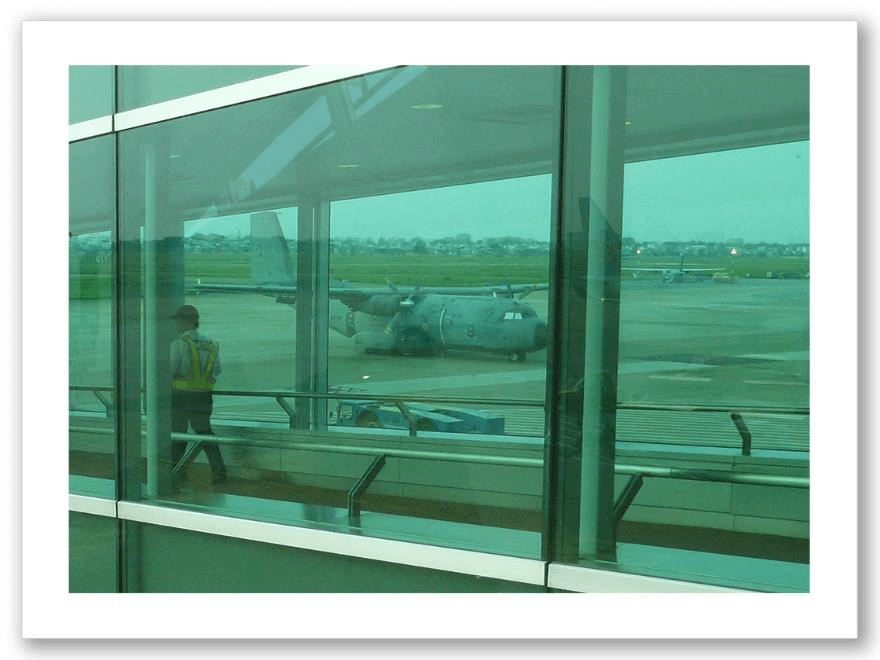 no, and I mean no, national
no, and I mean no, national
markings or markings of any
kind—a most unusual sight.
I watched the plane
for two hours and then saw
another peculiar sight—a
crew of three roundeyes,
USAF flight suits, and two
Vietnamese with no flight
suits, but some kind of uni-
form. They fired her up,
headed for 25R, and took off
for who knows where? You
could almost go back 52 years when aircraft like this were a dime a dozen at Tan
Son Nhut, and the smell of JP4 was everywhere—who won the war? Indeed, or
more ominously, what was this most useful relic of a bygone age doing on that
runway without markings? Ours don’t leak oil like the Russian ones do so that
gladdened my heart. Something to think about. They called my flight, and I was
soon on my way back to the land of the Big BX.
Page 92
A Step Back In Time
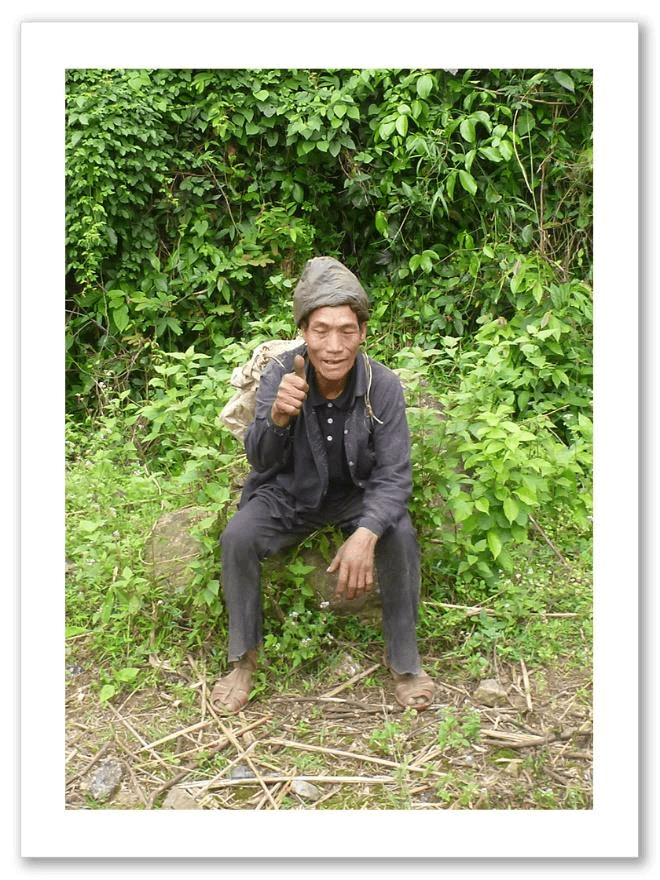
– Fin –
Thanks for this little adventure go out to Comrade Chris for her insights,
blazing humor, a laissez-passer and a much needed ideological tune-up so I could
find “The Correct Line”; Stan and Ilyna Volynsky for gifts of equipment and food,
and oceans of patience as we worked the maps; a big Spanish Harlem shout-out to
SI and NV for the torch of “eternal love” en beton that lit the fuse; Bamboo Boy of
the Lonely Planet Thorn Tree Forum who provided thoughtful advice; and finally
to Andy Greenberg and Carol Prendergast because they were “True Believers” in
the very best sense of the term—they never wavered, although I do suspect they
thought I might have gone “a bit too far” this time.
Harry C. Batchelder, Jr.
November 2012
New York NY
A Step Back In Time
Page 93
Harry C. Batchelder, Jr. is a three times decorated former
Colonel in the United States Air Force Intelligence Service.
In the late 1950s, ’60s and ’70s he was a “tourist” in Laos,
Cambodia, Vietnam and other “garden spots”
in Africa and the Middle East.
Mr. Batchelder is a criminal defense lawyer
in New York and New Hampshire.
Page 94
A Step Back In Time